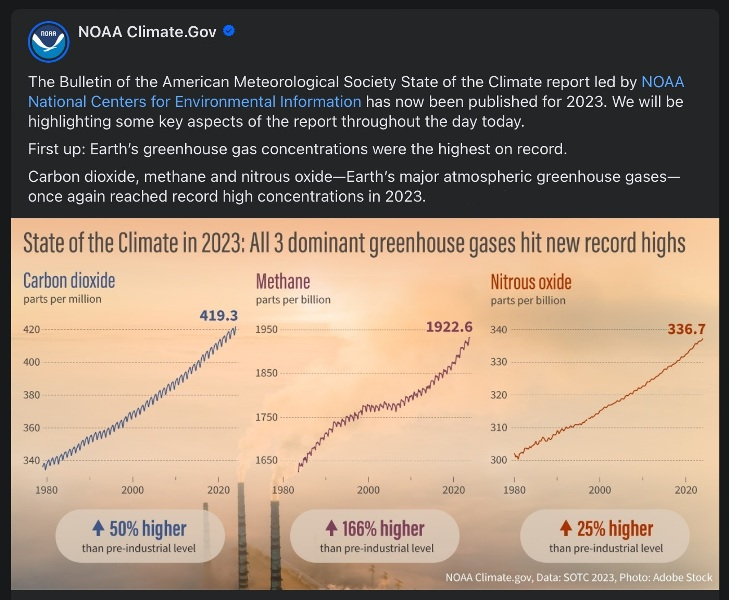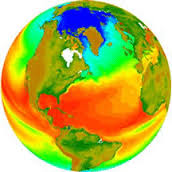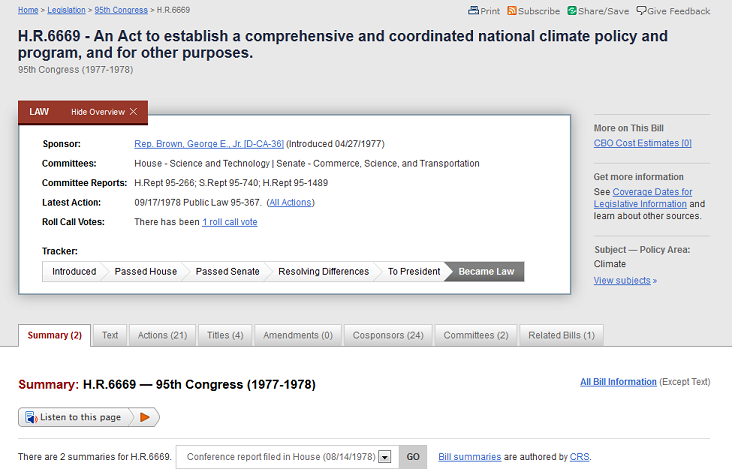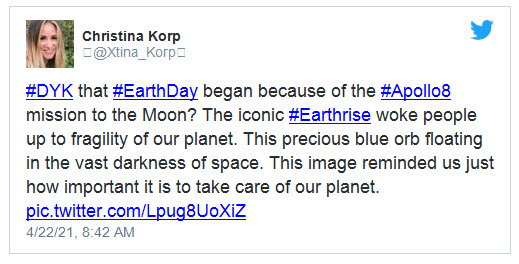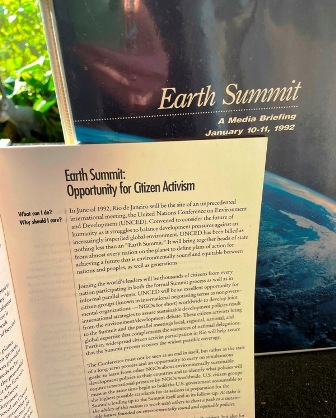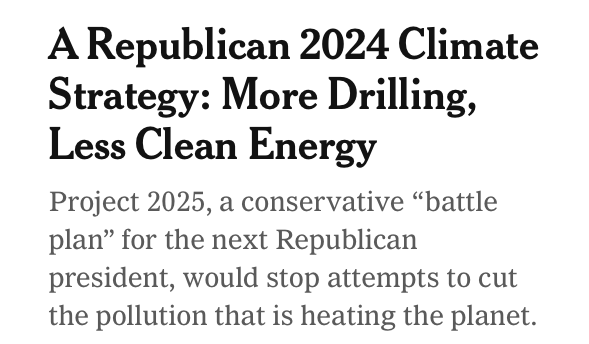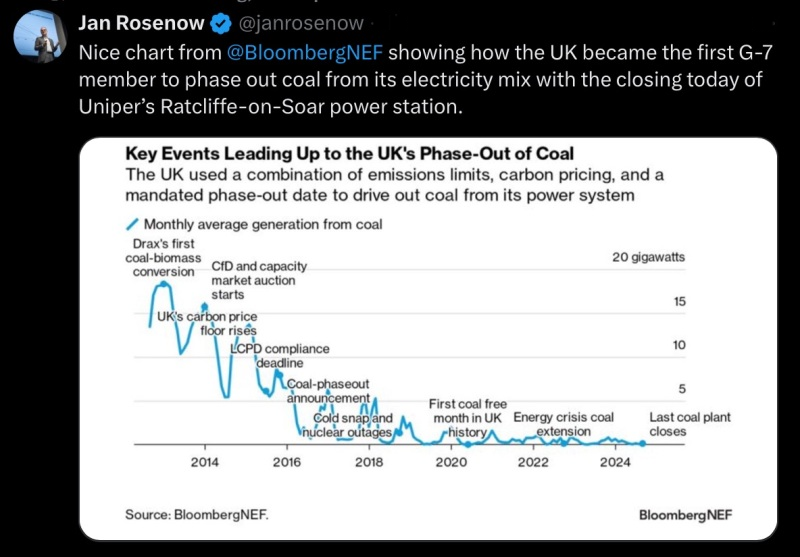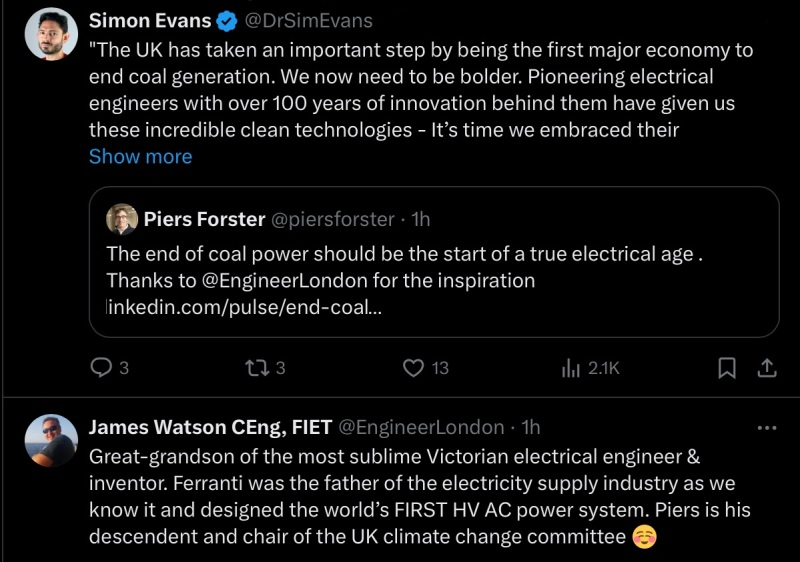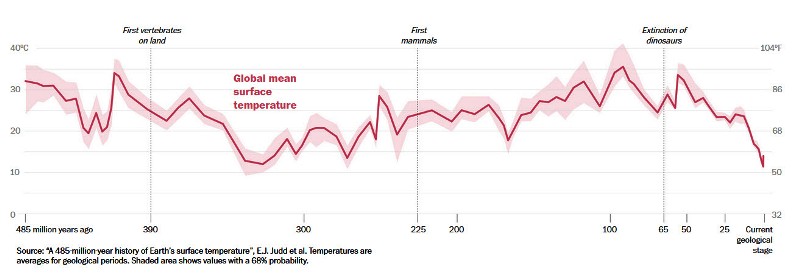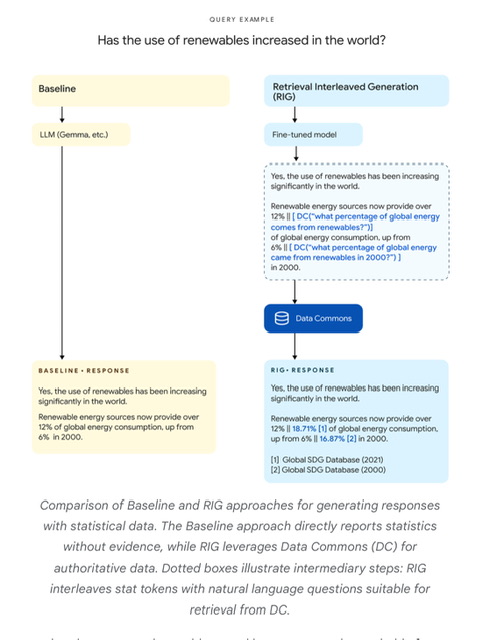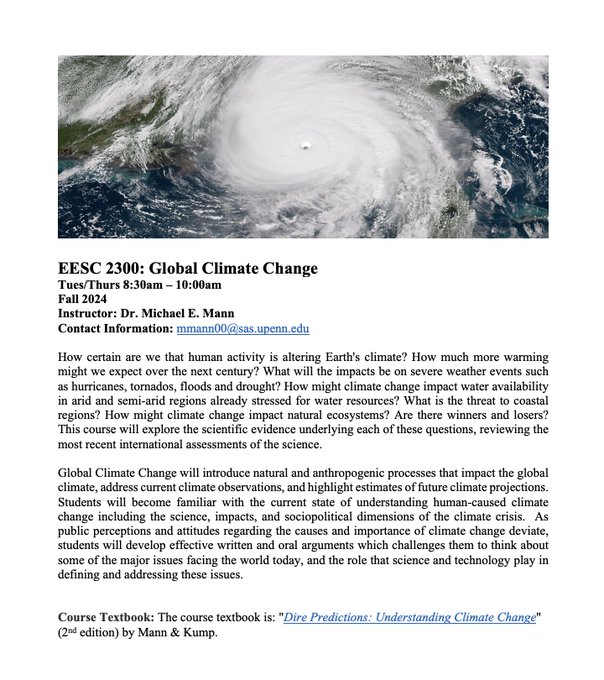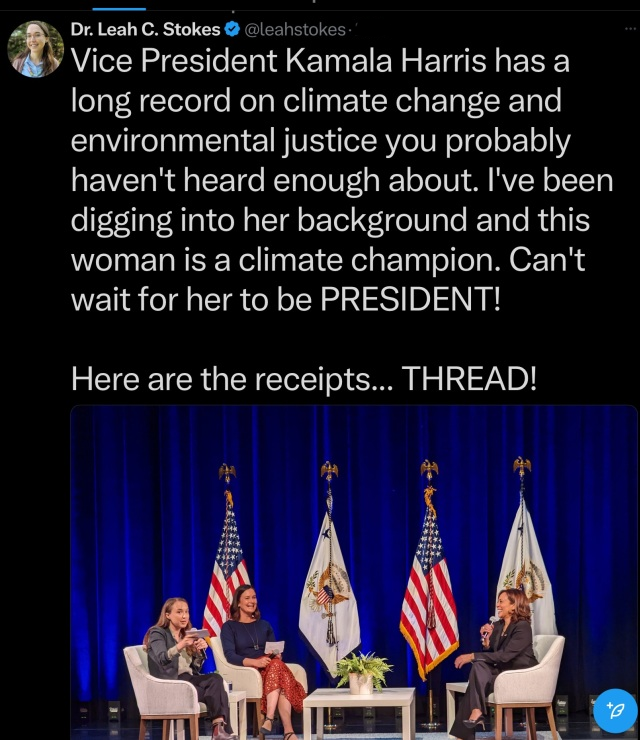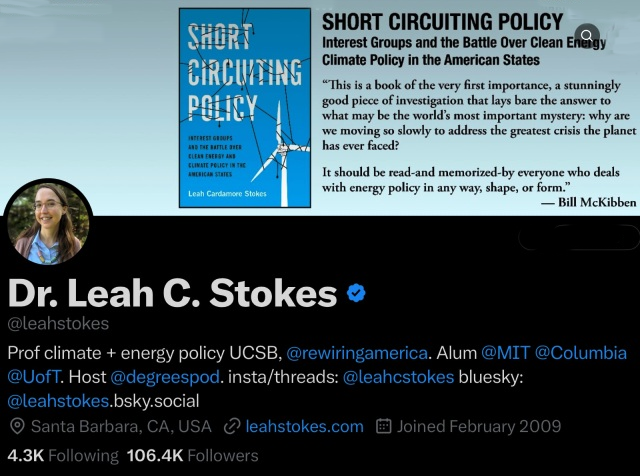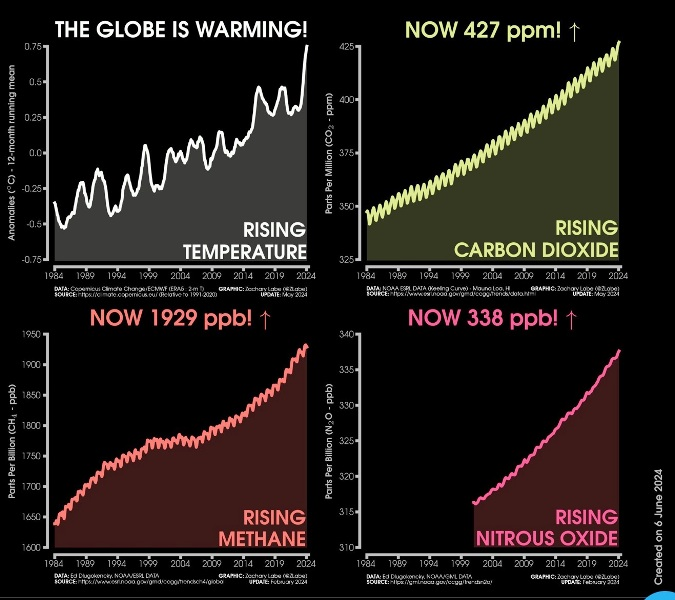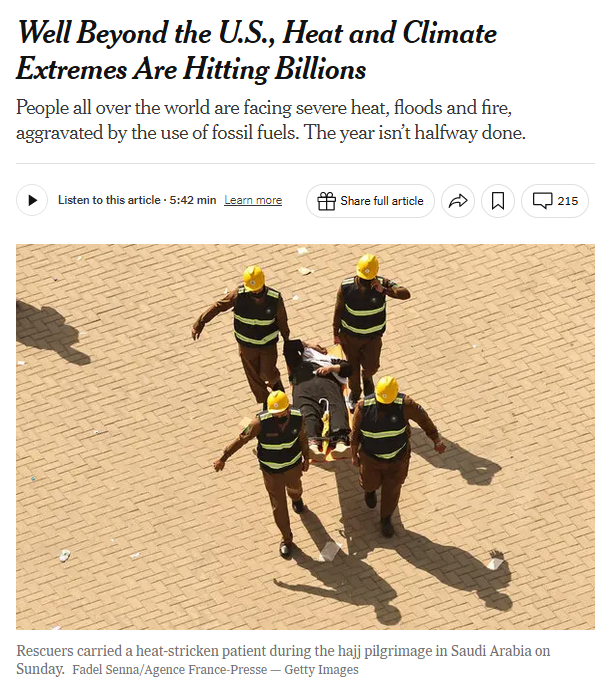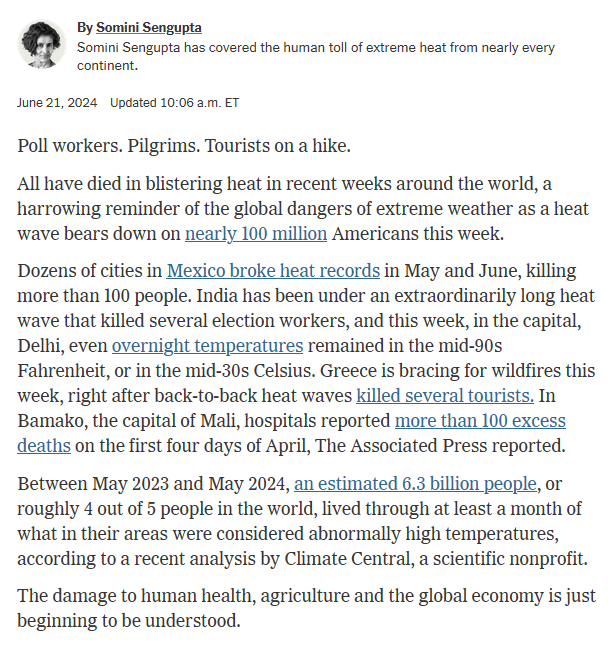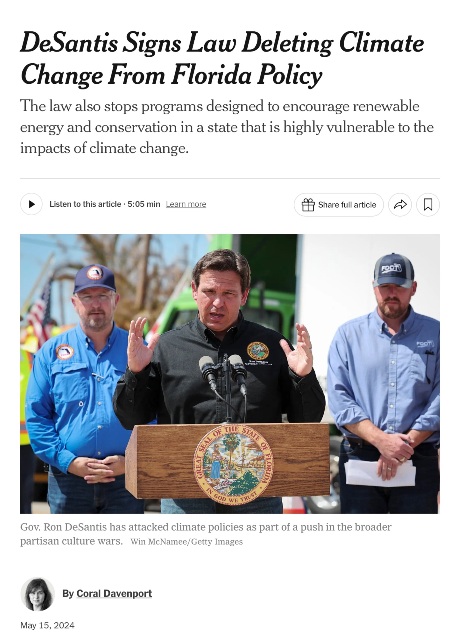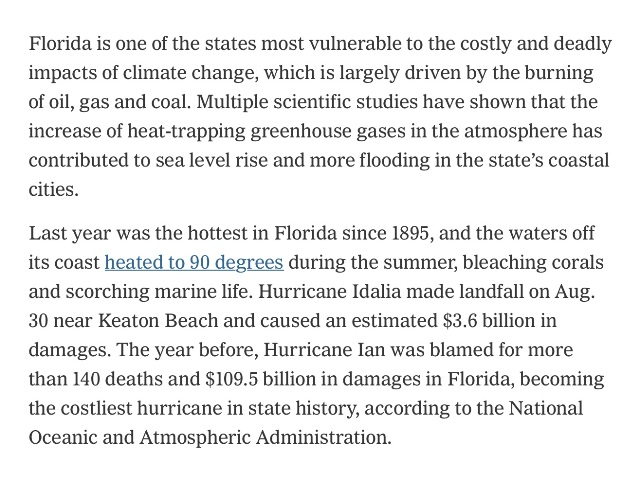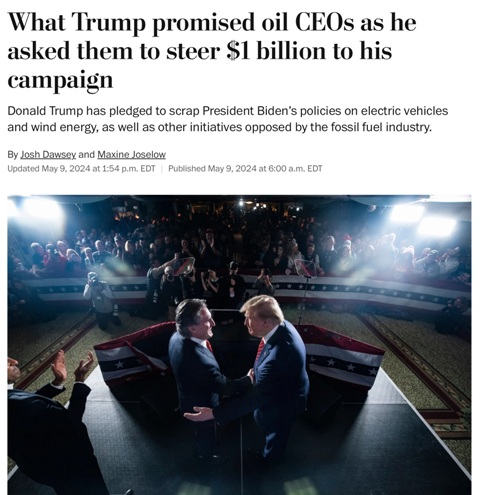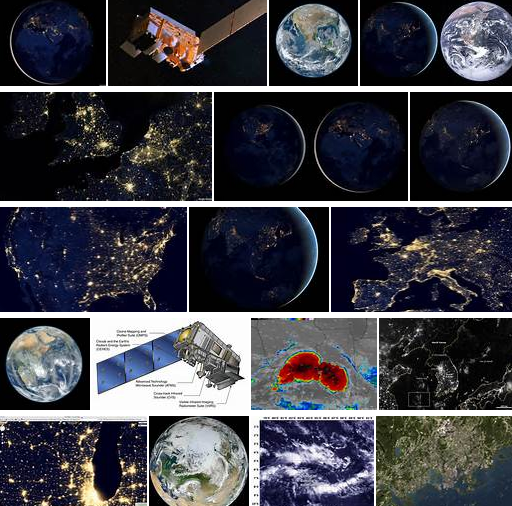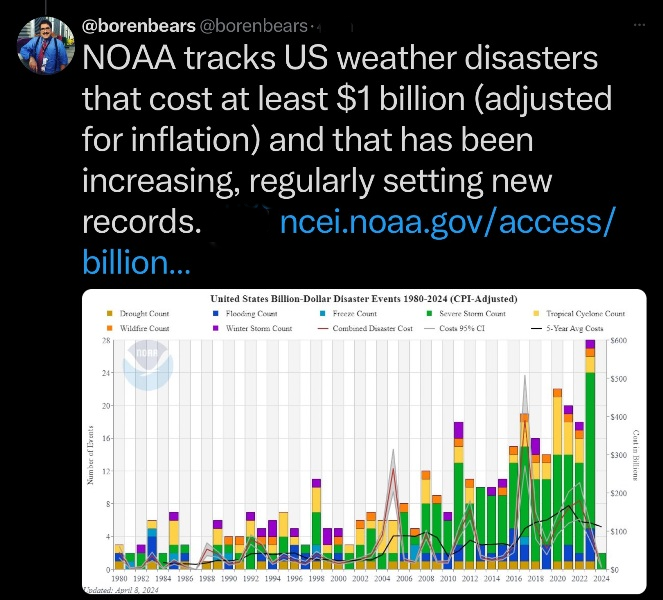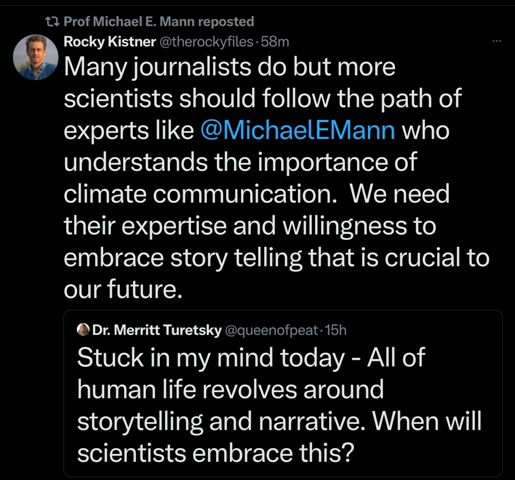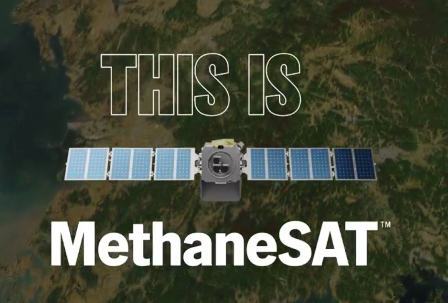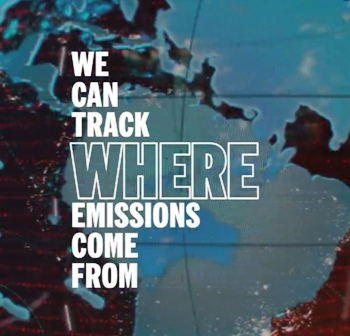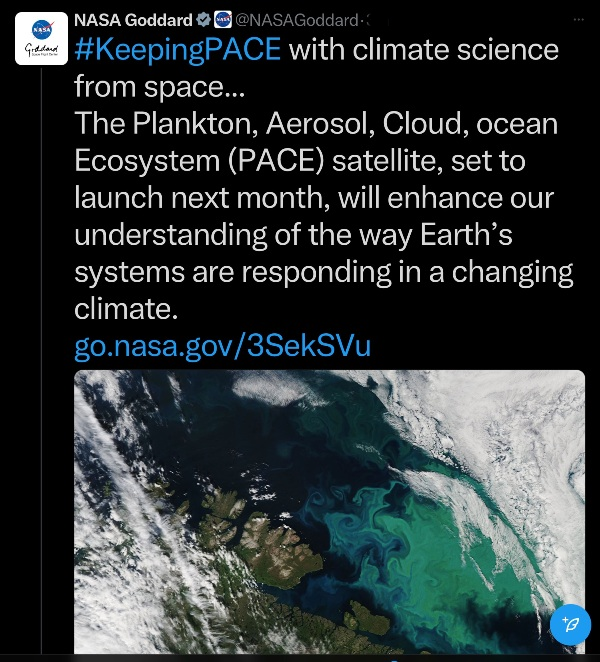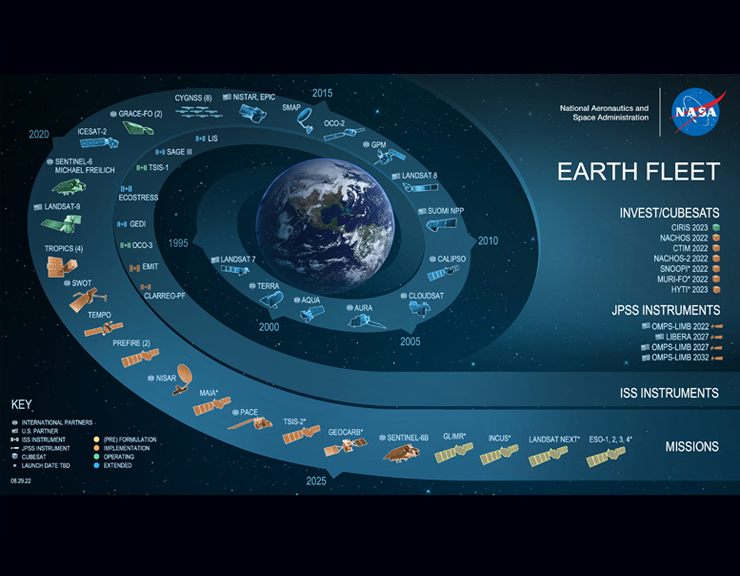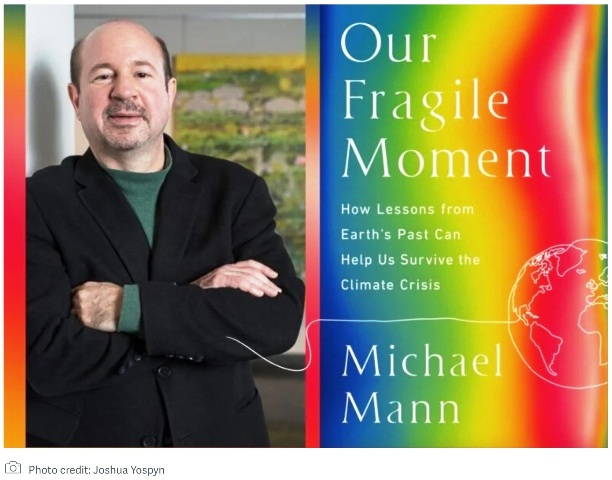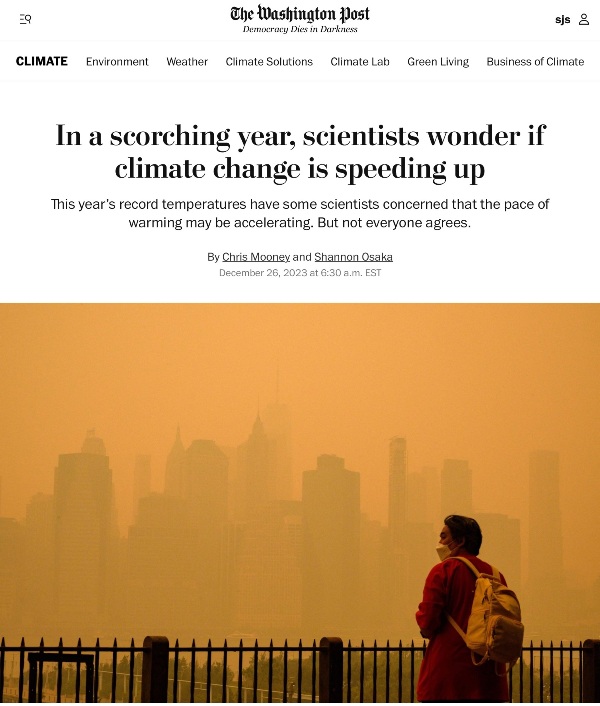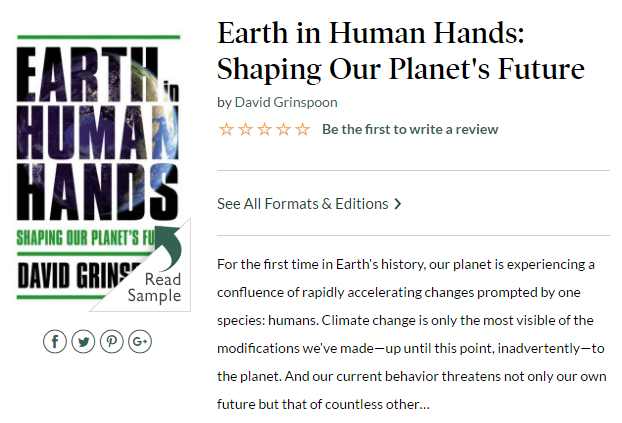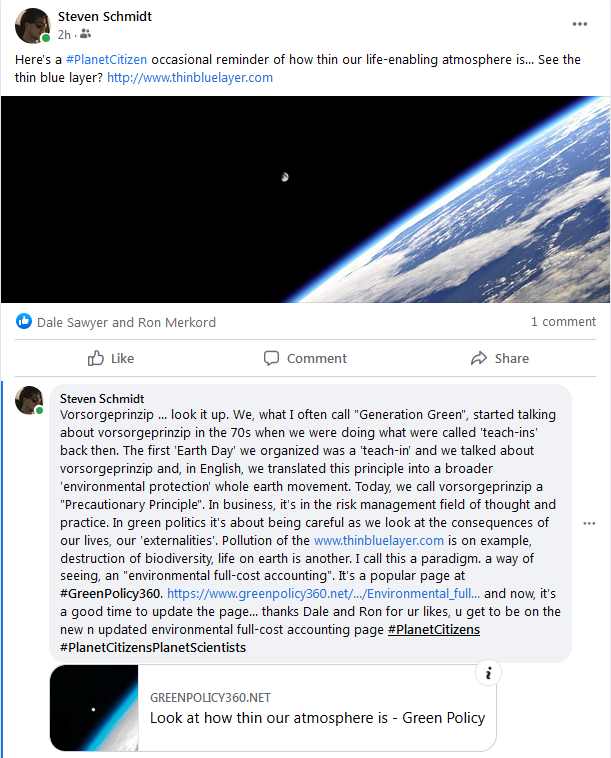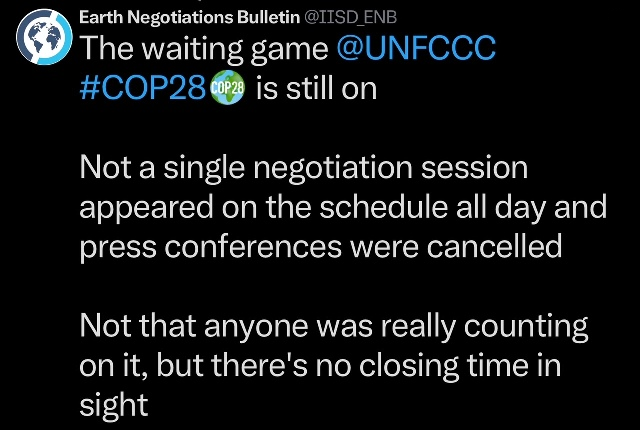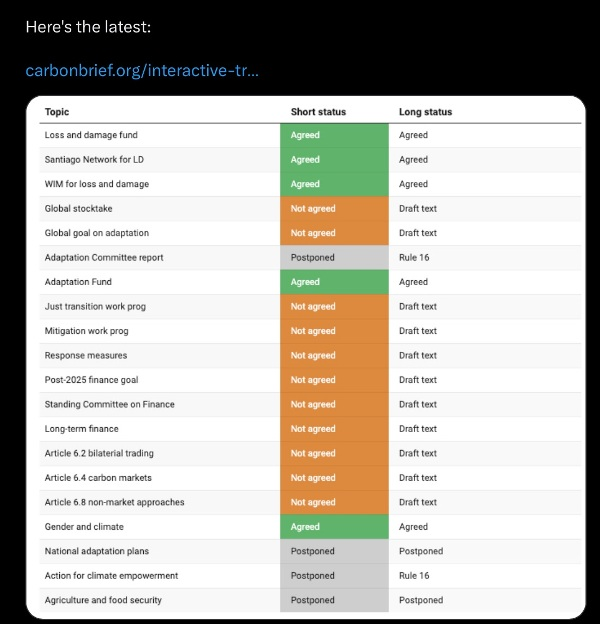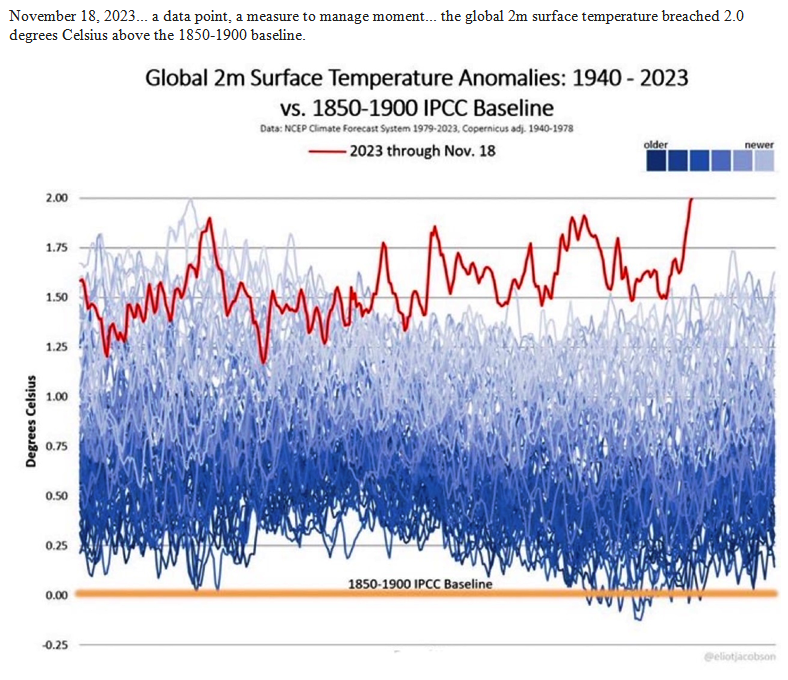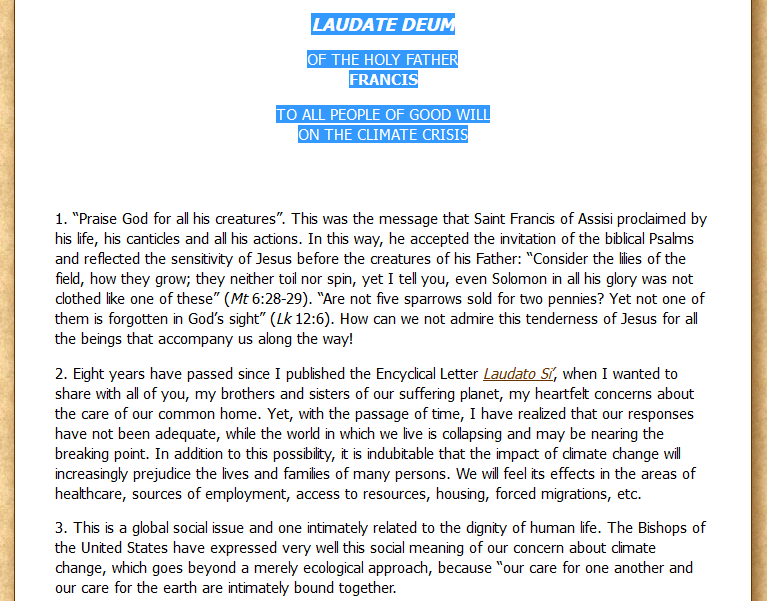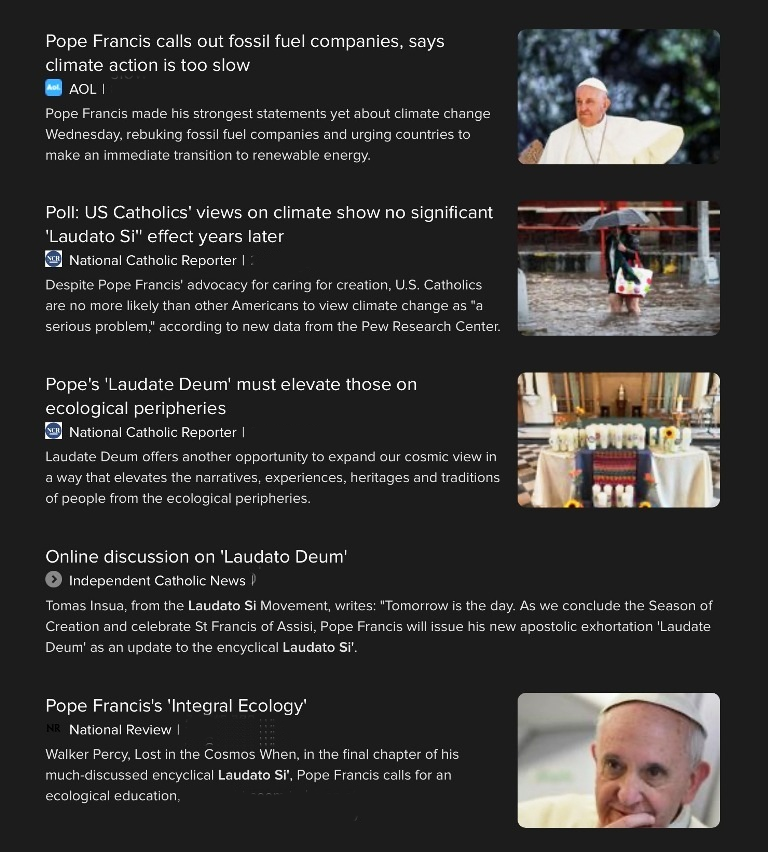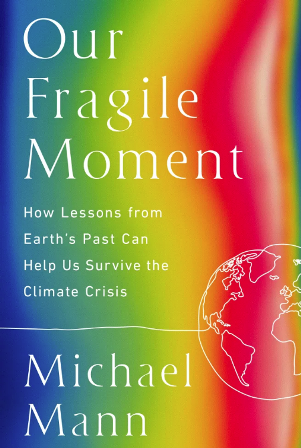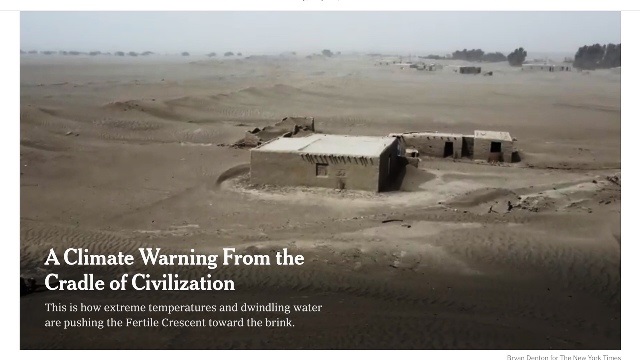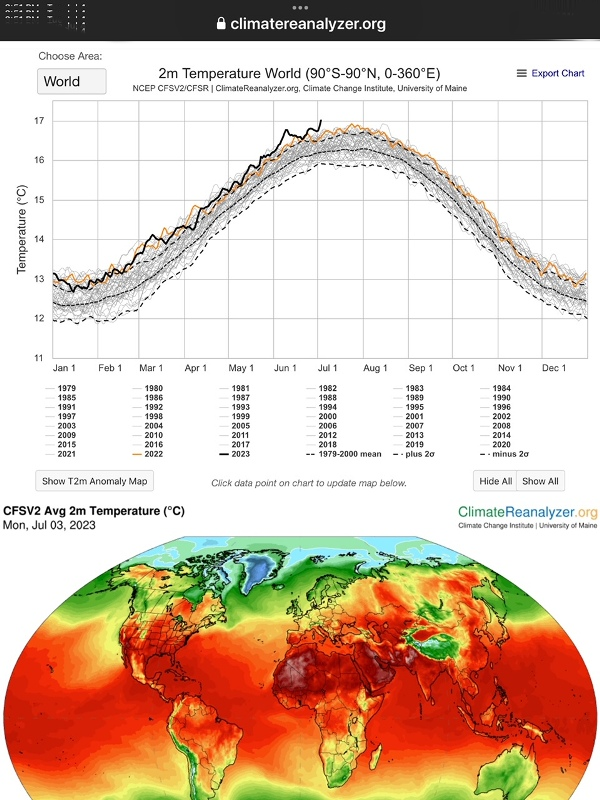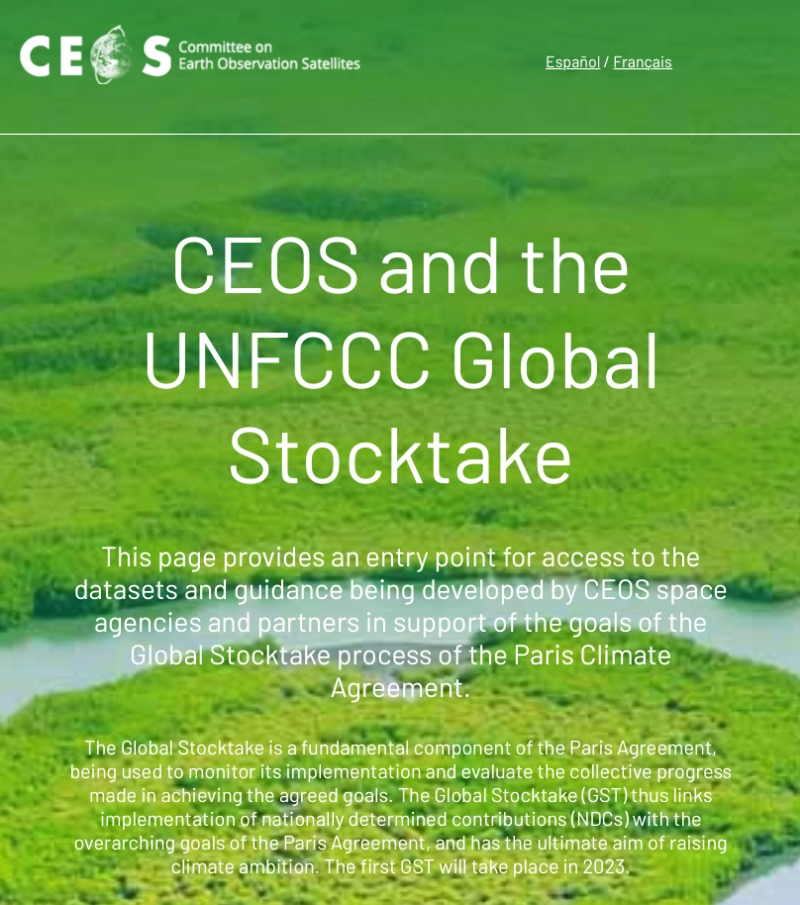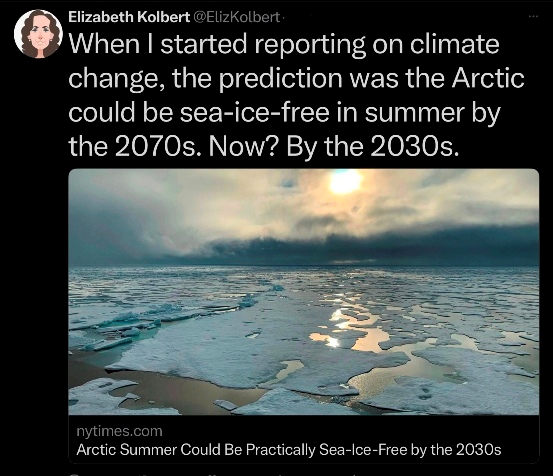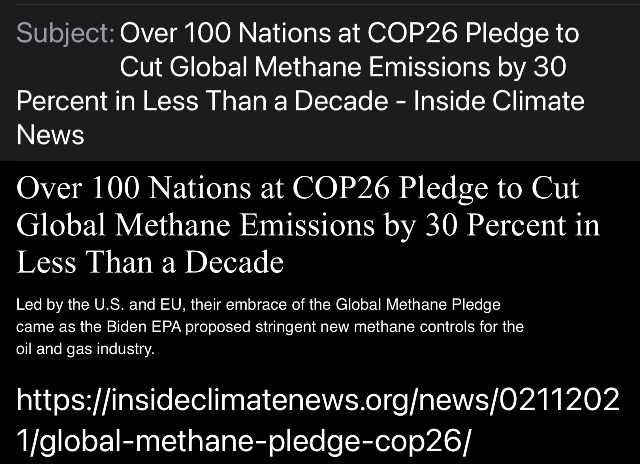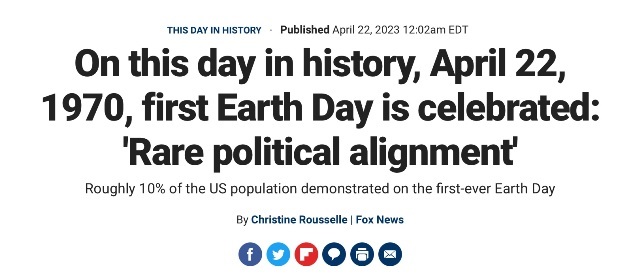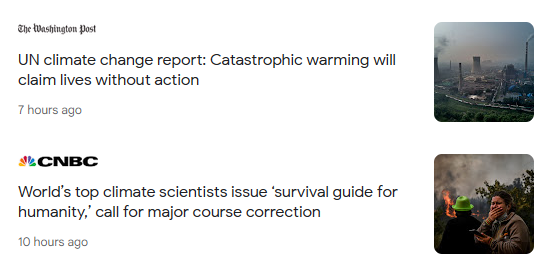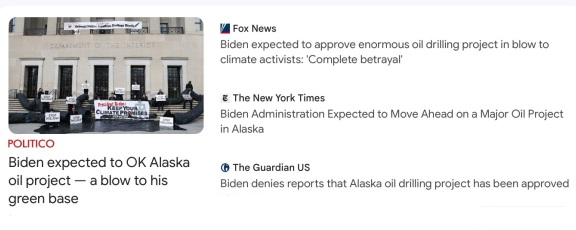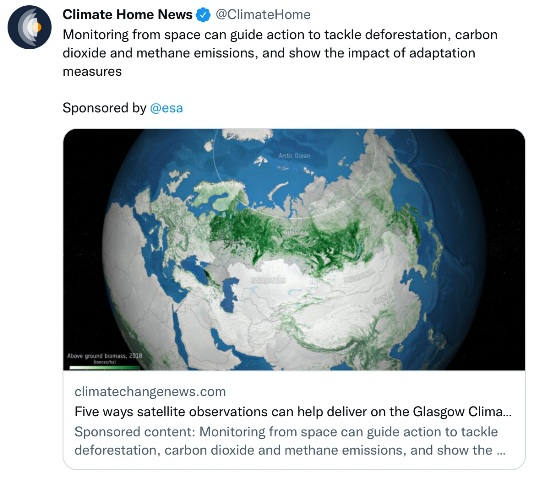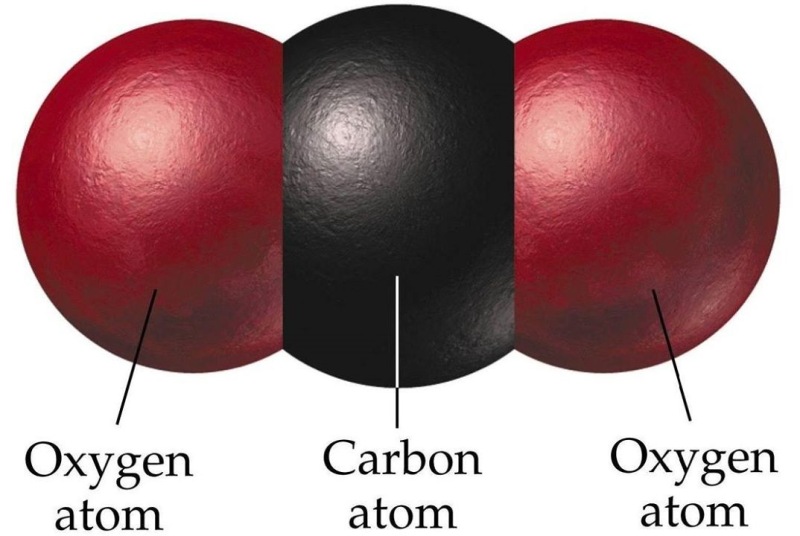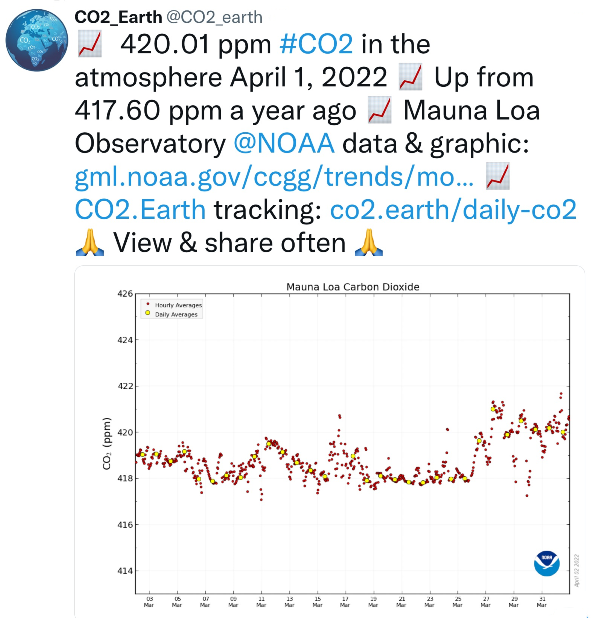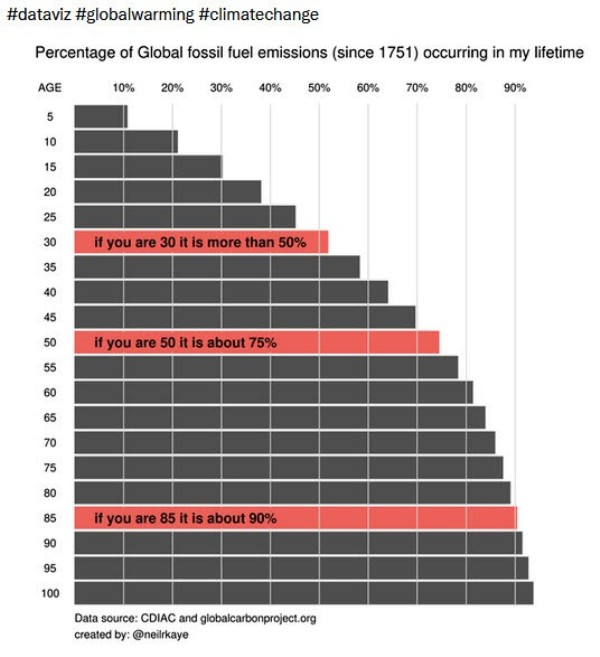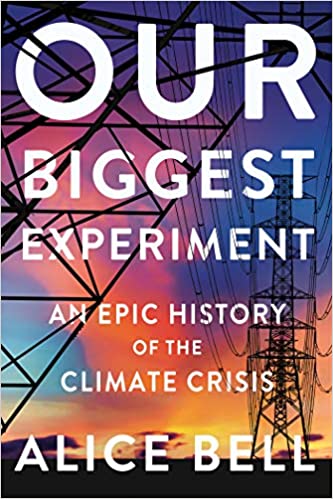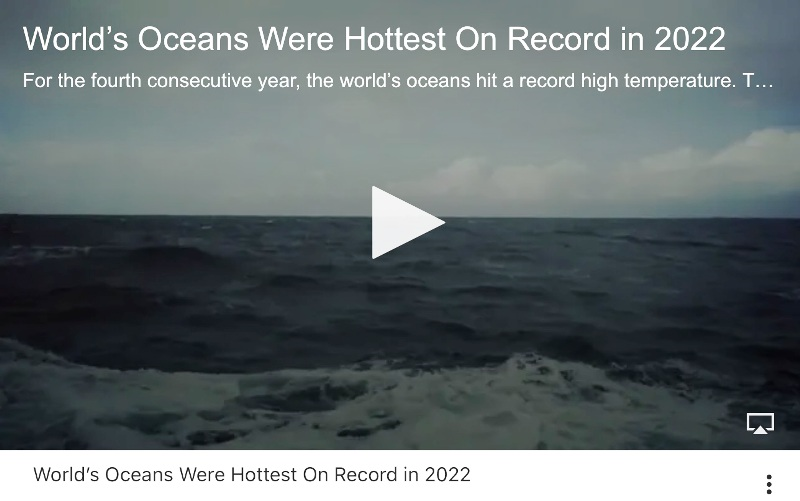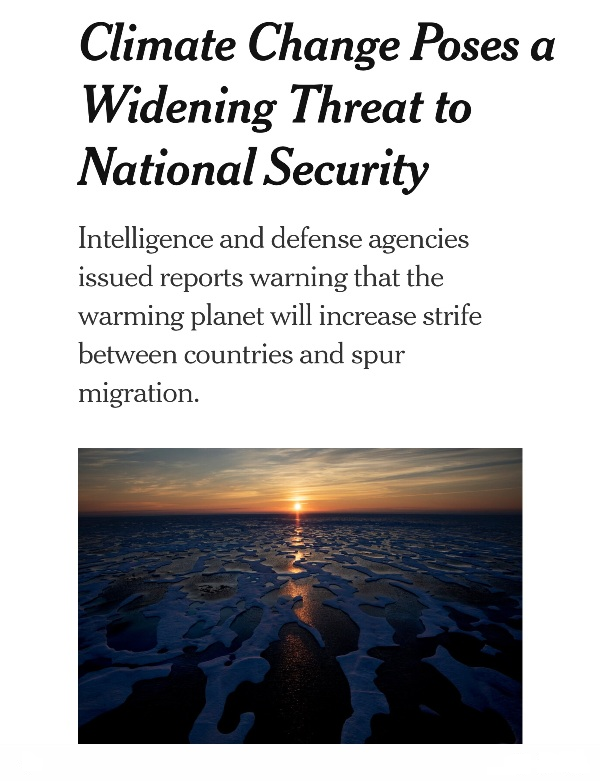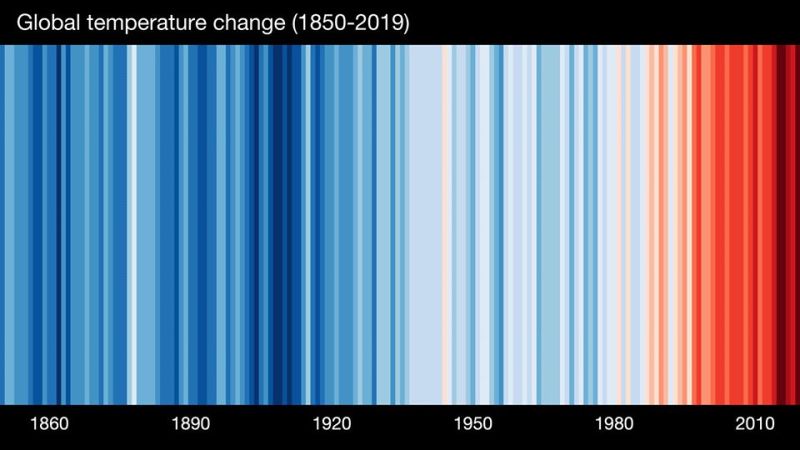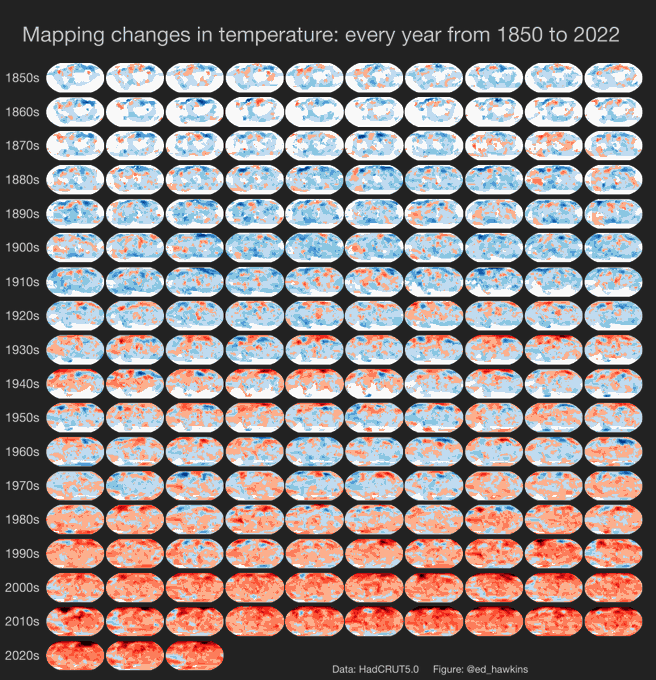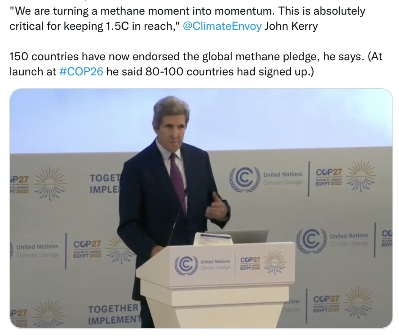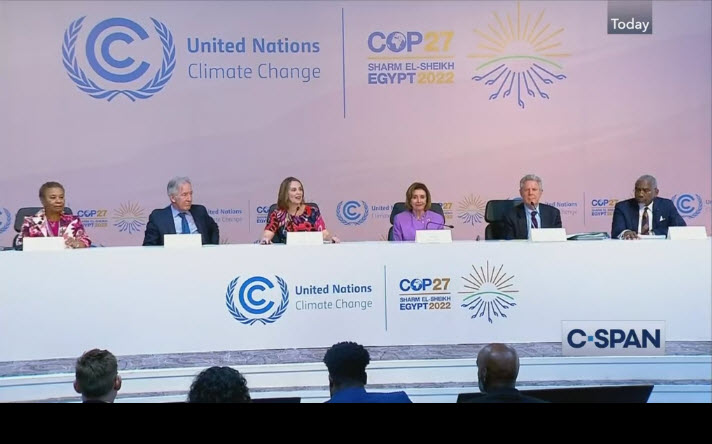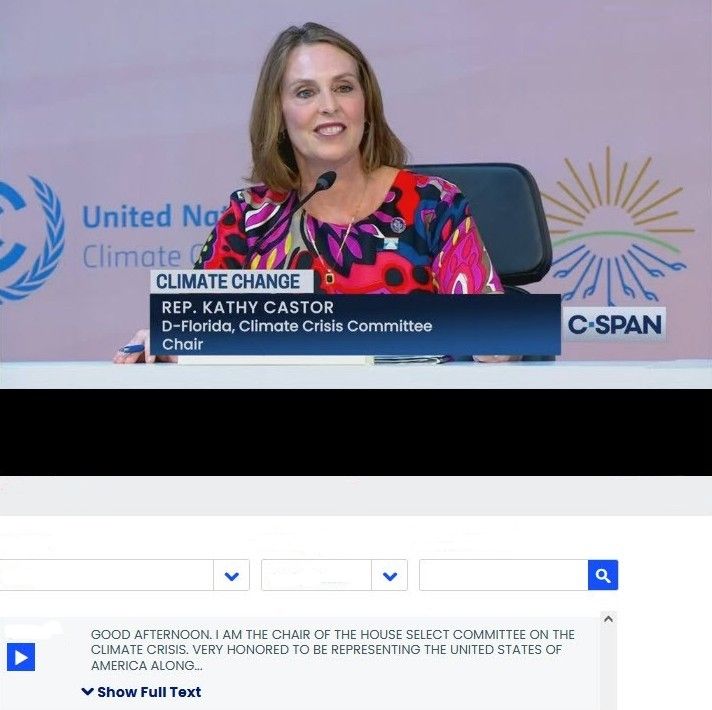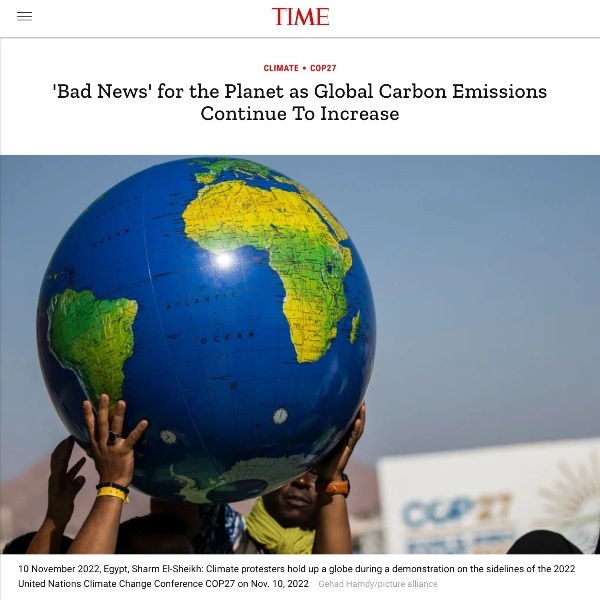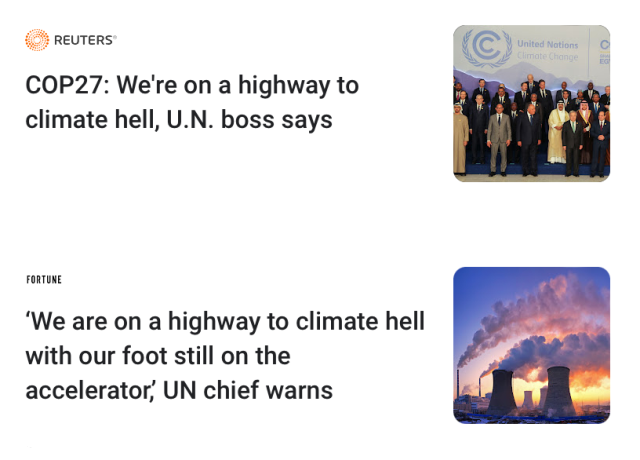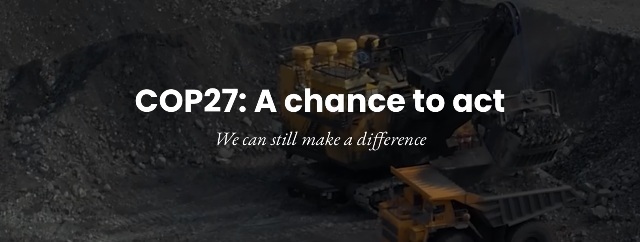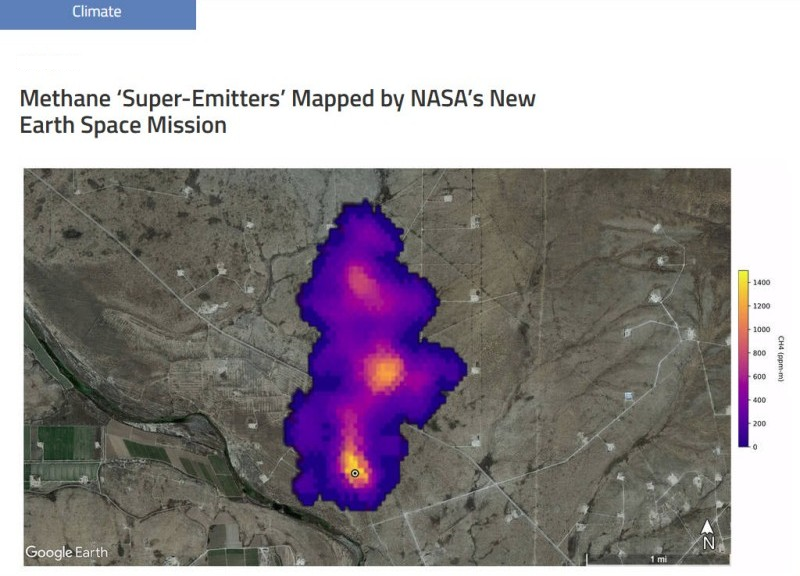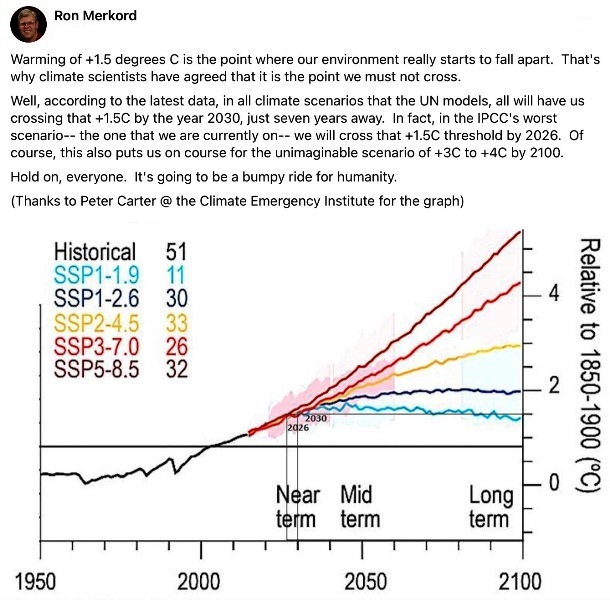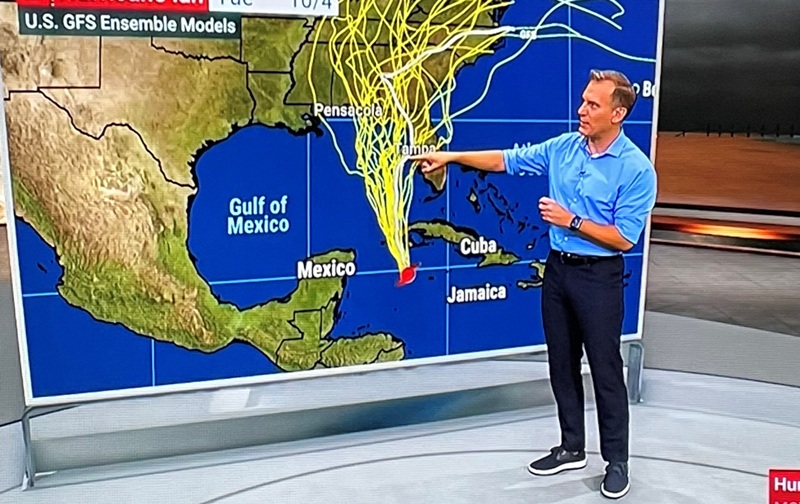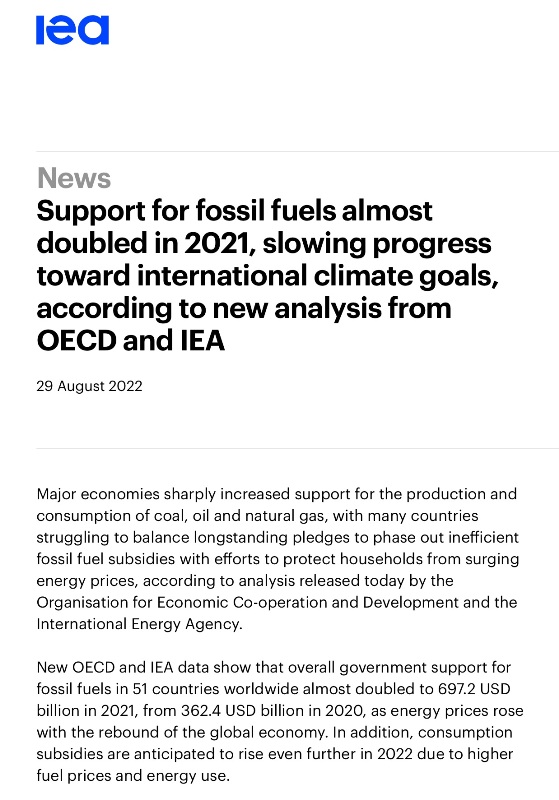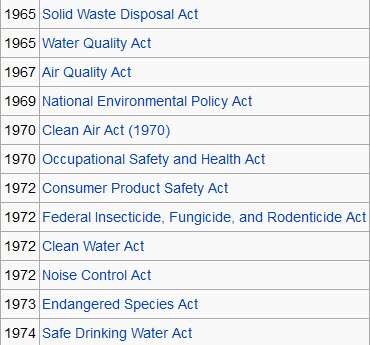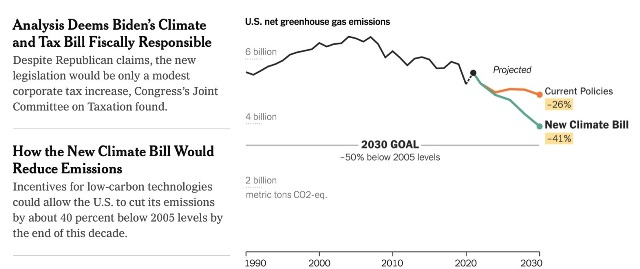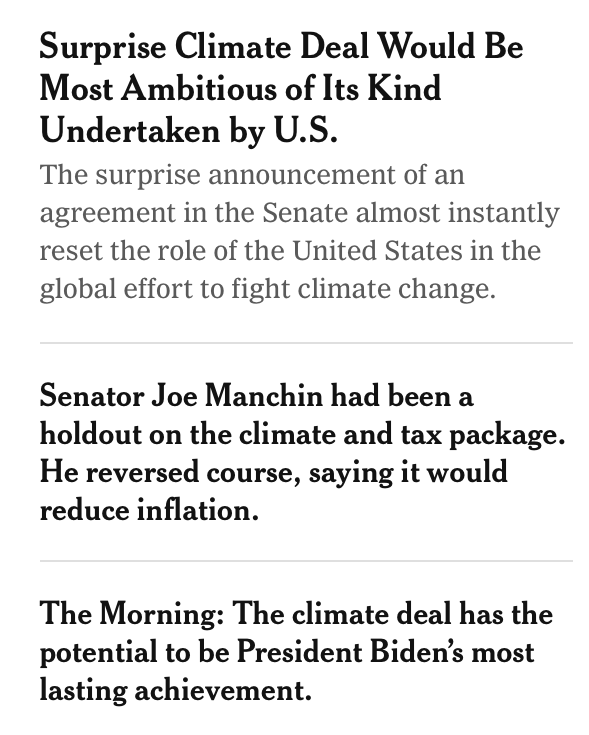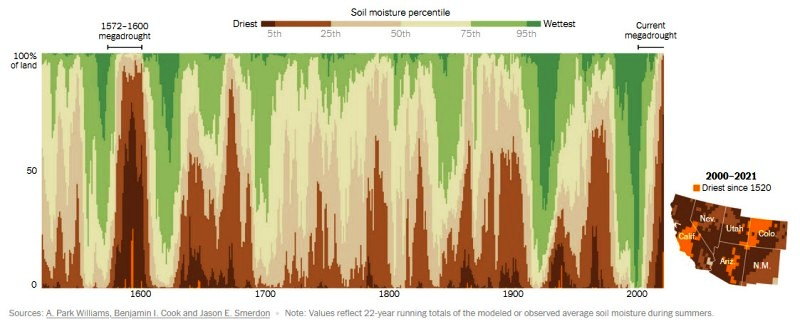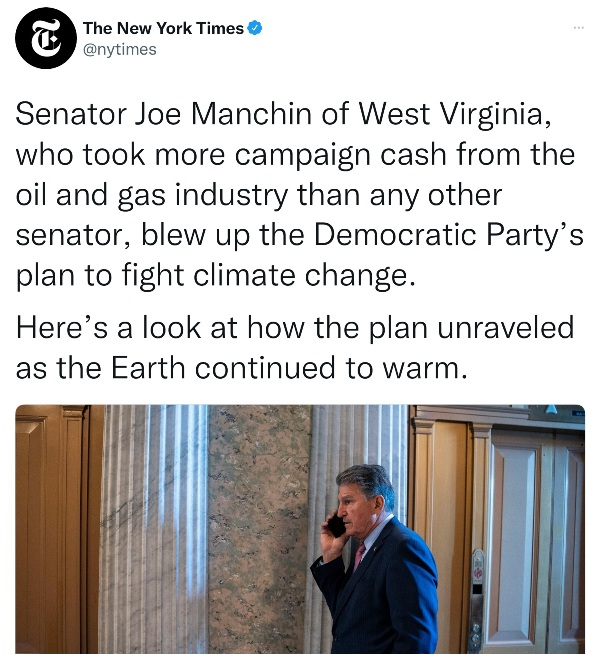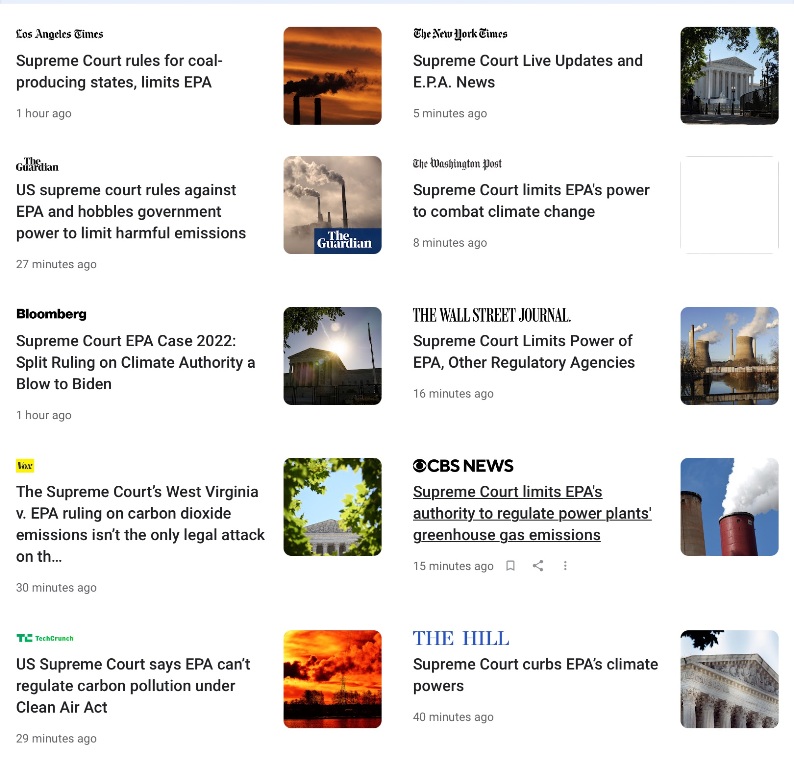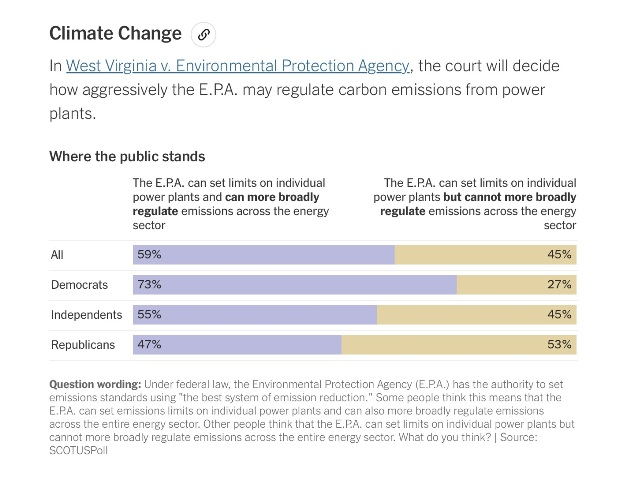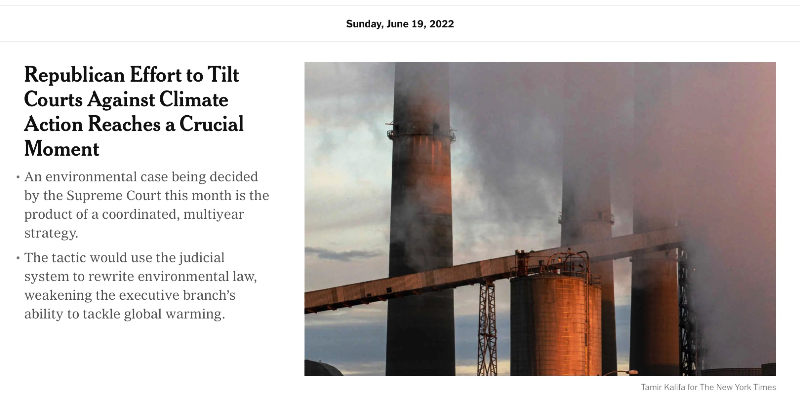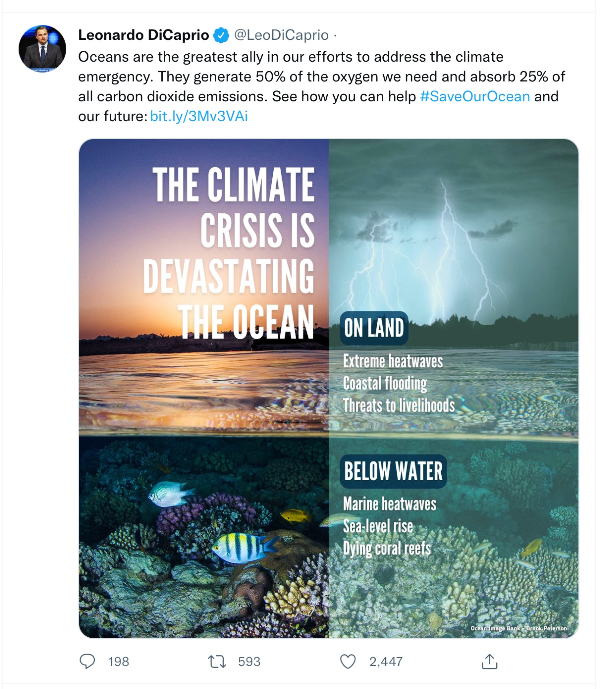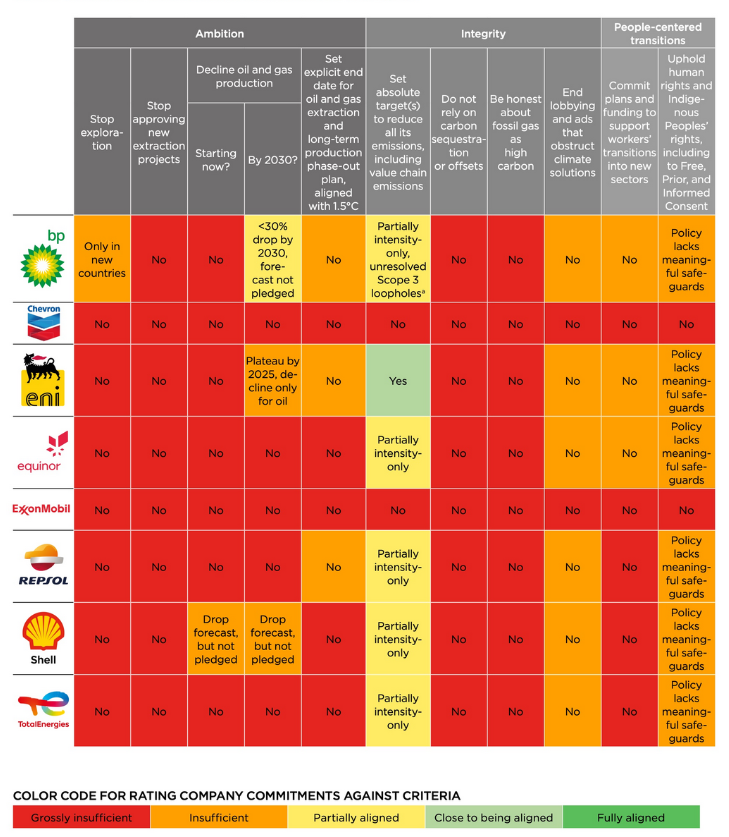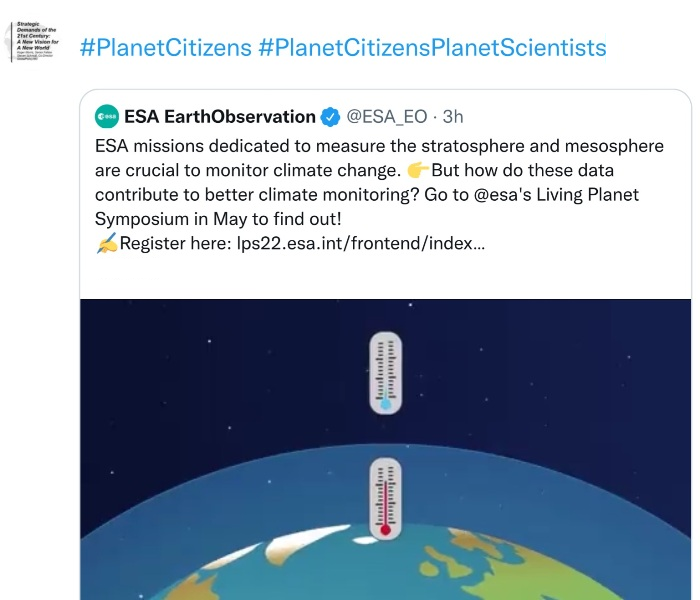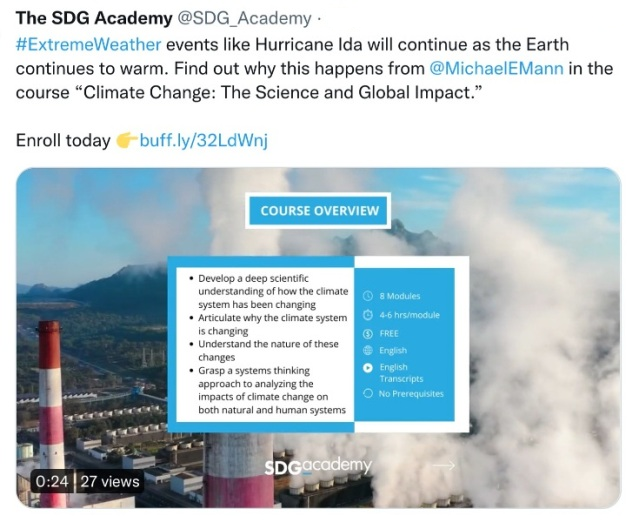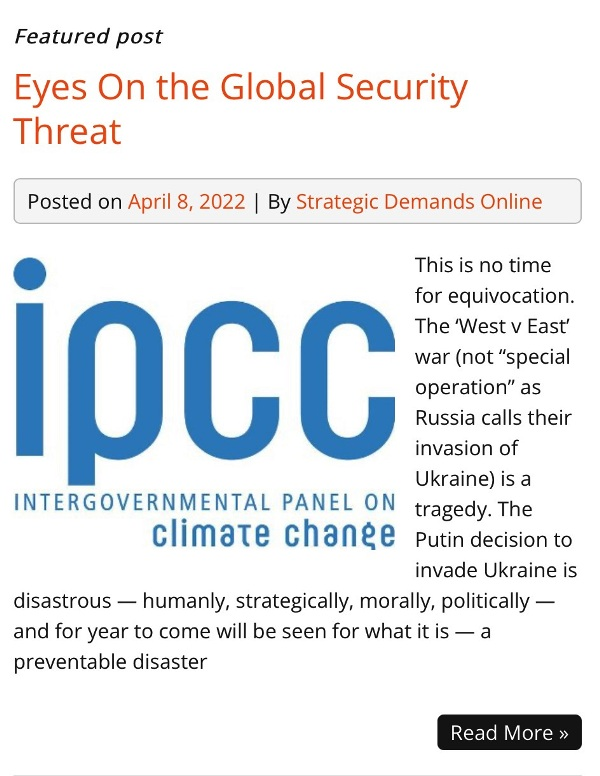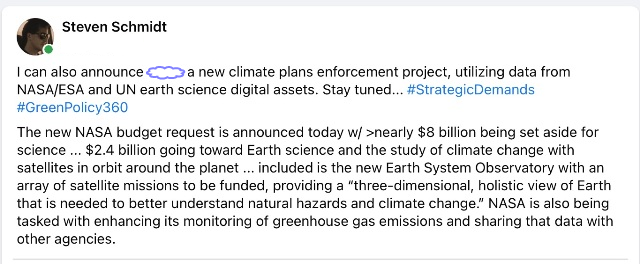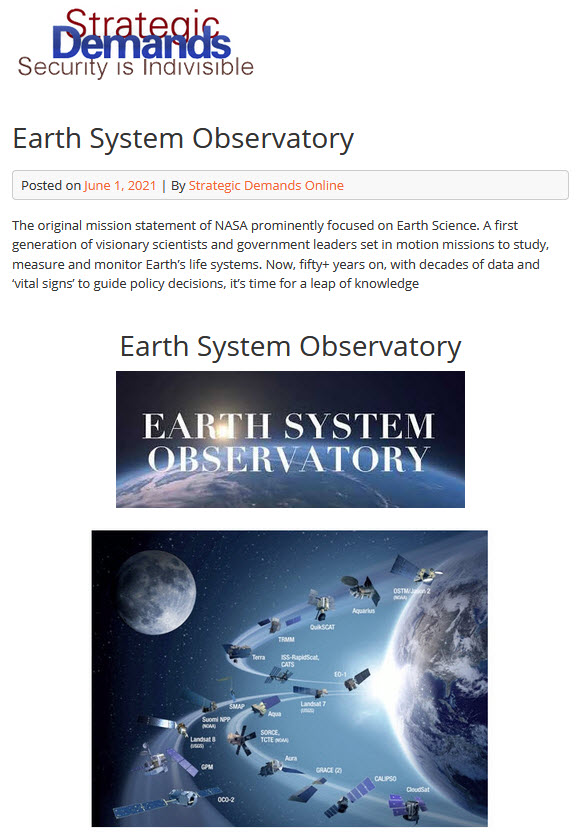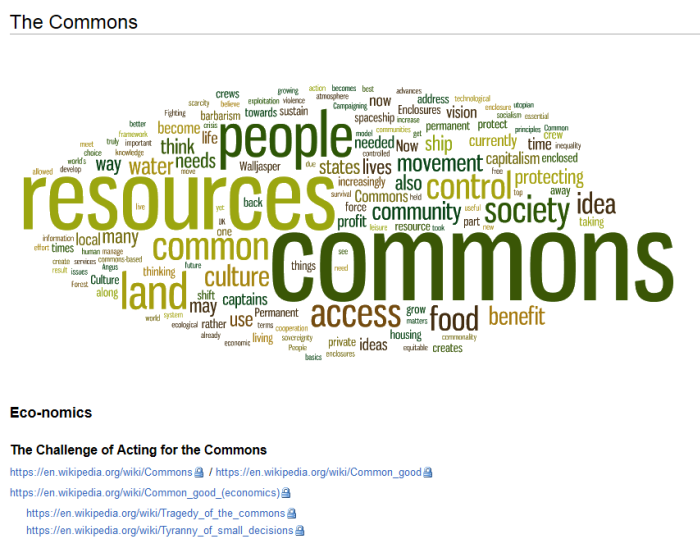Climate News: Difference between revisions
Siterunner (talk | contribs) No edit summary |
Siterunner (talk | contribs) No edit summary |
||
| Line 306: | Line 306: | ||
GreenPolicy360: '''No exaggeration to state, as the United States is about to vote for its president and government, that the fate of climate science, climate change, climate policies, and climate action -- the future of the state of the nation and planet -- is at stake...''' | GreenPolicy360: '''No exaggeration to state, as the United States is about to vote for its president and government, that the fate of climate science, climate change, climate policies, and climate action -- the future of the state of the nation and planet -- is at stake...''' | ||
<big><big>'''[[Generation Green]]'''</big></big> | |||
<big><big>'''The Day Before'''</big></big> | |||
: '''Tomorrow, November 5th, the US Votes''' | |||
::'''Your Future and Our Legacy IS on the Line''' | |||
'' “We are on the brink of an irreversible climate disaster,” begins a report published last month in the journal BioScience. “Much of the very fabric of life on Earth is imperiled... We are stepping into a critical and unpredictable new phase of the climate crisis.”'' | |||
-- Oxford Academic BioScience / Special 2024 Report | |||
''This is a global emergency beyond any doubt. Much of the very fabric of life on Earth is imperiled. We are stepping into a critical and unpredictable new phase of the climate crisis. For many years, scientists, including a group of more than 15,000, have sounded the alarm about the impending dangers of climate change driven by increasing greenhouse gas emissions and ecosystem change (Ripple et al. 2020). For half a century, global warming has been correctly predicted even before it was observed—and not only by independent academic scientists but also by fossil fuel companies (Supran et al. 2023). Despite these warnings, we are still moving in the wrong direction; fossil fuel emissions have increased to an all-time high, the 3 hottest days ever occurred in July of 2024 (Guterres 2024), and current policies have us on track for approximately 2.7 degrees Celsius (°C) peak warming by 2100 (UNEP 2023). Tragically, we are failing to avoid serious impacts, and we can now only hope to limit the extent of the damage. We are witnessing the grim reality of the forecasts as climate impacts escalate, bringing forth scenes of unprecedented disasters around the world and human and nonhuman suffering. We find ourselves amid an abrupt climate upheaval, a dire situation never before encountered in the annals of human existence. We have now brought the planet into climatic conditions never witnessed by us or our prehistoric relatives...'' | |||
* https://doi.org/10.1093/biosci/biae087 | |||
* https://academic.oup.com/bioscience/advance-article/doi/10.1093/biosci/biae087/7808595?login=false | |||
GreenPolicy360: | |||
'''Election Day in the United States, November 5th, approaches and the gathering winds of the future whistle ever closer...''' | |||
'''The decision made will have far reaching and long lasting consequences.''' | |||
'''Since the 1970s and first '[[Earth Day]]' and first [http://www.greenpolicy360.net/w/File:US_Public_Law_95-367.png 'National Climate Program Act'], Green Policy's founder-siterunner has spoken of the critical importance of protecting our [https://greenpolicy360.net/w/File:Earthrise_Planetary_Awareness.jpg 'living blue-green Earth']. Now, let us be clear-eyed about what we have to face in front of us. Tomorrow is a historic turning point, a day of reckoning. | |||
'''Here, let us consider a voice from America's southern states with words that need to resonate:''' | |||
''"Every existing global conflict, every human vulnerability and every form of social instability is already being exacerbated by climate calamities. There is no issue on the political table that will not be made exponentially worse if we allow the living earth to enter its death throes, and yet climate has rarely been part of the political discourse during this election year... Where planetary survival is concerned, it is too late to sit out an election on principle, or to cast a vote for a third-party candidate... This is the time to go to the polls and vote.'' | |||
''"The Democrats’ policies aren’t unassailable, but they are at least capable of keeping this planet alive long enough for the rest of the human race to come around to understanding how urgent is the danger we already face, how much worse it is going to get and how little time we have to hold off the unthinkable." -- Margaret Renki'' | |||
'''Let Margaret's words on protecting our [https://www.greenpolicy360.net/index.php?search=living+earth&title=Special%3ASearch&profile=advanced&fulltext=1&ns0=1 'Living Earth'] be a guide for decisions - and votes - in tomorrow's US election. Our generation's legacy, it must be said, is on the line.''' | |||
| |||
<big>'''October'''</big> | <big>'''October'''</big> | ||
Revision as of 15:10, 4 November 2024
Climate Security News & Events
Support Green Wings'
- Help to Power Up Our Green Work
"Now on We Go with a GreenPolicy360 Dali-esque climate warning"
- Even your news is hot ....
Earth Temperature Today 🌡️ Climate Change Institute -- https://climatereanalyzer.org/clim/t2_daily/
Climate Forecast System - https://cfs.ncep.noaa.gov/ | https://www.ncei.noaa.gov/products/weather-climate-models/climate-forecast-system
National Centers for Environmental Prediction - https://www.nco.ncep.noaa.gov/ | https://www.cpc.ncep.noaa.gov/
- The Keeling Curve
NASA - Astronaut Reid Wiseman
"Thin Blue Layer" @GreenPolicy360 - www.ThinBlueLayer.com
* https://greenpolicy360.net/images/Reid_Wiseman_thinbluelayer_m.jpg
* https://pbs.twimg.com/media/BuDZa8ZCEAAJzmd.jpg:large
Track Earth System Science back to its beginnings at NASA with its Planet Earth 'Mission Statement' --
- and a Congressperson who envisioned Earth Science as 'Big Science' over decades that followed...
With deep appreciation, a Tip of our GreenPolicy360 Hat to our Decades-long Friend and Colleague George E. Brown Jr
* https://greenpolicy360.net/w/File:EarthScience_Missions_via_the_EOS_-_2022.png
···················································
* https://www.greenpolicy360.net/w/Too_Hot
·························································································
New Ways to See & Experience Planet Earth
Visit GreenPolicy360's story of Earth Science research from our decades of research, eco-activism and #PlanetCitizens education.
Our eco operating system (eOS) includes:
ThinBlueLayer.com - Look at how thin our atmosphere is
New Definitions of National Security - Strategic Demands
Earth Science Research from Space
·····································
Flashback -- 1978, Climate Action Memories
Earth's First National Climate Act
- In 1978 the U.S. Congress led the way with Public Law 95-367
- A Congressman from East Lost Angeles, who was a trained in physics and an engineer, drafted a visionary program
- Representative George E. Brown was deeply involved in the earlier Clean Air Act, the establishment of the EPA, and NASA Earth Science start-up missions
- What was launched has led now to a deep database of Atmospheric/Earth Science and nearly every nation of the world developing National Climate Plans
GreenPolicy360 Siterunner / SJ Schmidt: The modern environmental era and Earth Science/Climate Science can be traced to the 1960s and 1970s. The U.S. National Academy of Sciences played a key role in laying a foundation of scientific reports and data.
Your GreenPolicy founder was involved, especially with the work of a Congressman who took the Academy of Science report and drafted the first National Climate Act. It was a follow on to Earth Day activism and was accompanied by a broad array of NASA research and Earth Science measuring and monitoring missions intended to guide climate policy and decision-making.
Energy and Climate Report, 1977, National Academy of Sciences / 175 pp. / PDF via GreenPolicy360
Rep. George Brown took the findings of the 1977 Energy and Climate Report from the Academy of Sciences and made the science actionable. In a historic moment, he proposed and drafted the legislation of the first U.S. National Climate Program and shepherded its passage in 1978.
This was the first federal program established to study and assess scientifically the issues and risks of human-caused climate change and was a foundation for comprehensive initiatives of NASA and NOAA, the EPA and USGS.
- ·························································································
1968-1970, a 'Whole Earth' Vision ("Earthrise") via NASA
- The First Earth Day and an Environmental Protection Movement Is Launched
- New Ways of Doing Business, Sustainable, Resilient, Forward-looking
Earth Day Memories on the 50th Anniversary
Congressman George Brown steps up and a long ride begins ...
- A Whole Earth Point of View -- http://www.greenpolicy360.net/w/Category:Whole_Earth
- Steven Schmidt, GreenPolicy360 Siterunner....
- DYK? Yes, we know, we remember the beginnings !
- 'Earthrise' and 'Earth Day'
A Life Affirming 'Earthrise'
"Earthrise" -- https://www.greenpolicy360.net/w/Apollo_8
Beginnings of the Modern Environmental Movement
* https://www.greenpolicy360.net/images/1969_beginnings_of_the_modern_environmental_movement.pdf
🌎
1992 -- The First International UN Earth Summit
- We (your GreenPolicy360 founder) reported 'deep into the first Earth Summit'...
- and in that early 90s year worked to draft a 1992 US presidential campaign platform 'deep on the green'
- Launch of the Annual International (UNFCCC) Climate Conferences
2024
November
November 4, 2024
The Business Community Speaks Up
There are many clear choices at stake in tomorrow’s Presidential election. One of the starkest is climate and it comes at a time when the planet is careening toward catastrophic levels of warming.
Vice President Kamala Harris has called climate change an “existential threat.” While she hasn’t detailed a climate plan, she’s widely expected to continue federal support for clean energy and electric vehicles in an ongoing effort to move the American economy away from fossil fuels. In 2022, she cast the tie-breaking vote for the Inflation Reduction Act and has pledged to fully implement it.
Meanwhile, former President Donald Trump has called climate change “one of the greatest scams of all time,” and vowed to end federal support for the clean energy transition, while ramping up drilling for oil and gas, including in the Arctic. He withdrew the U.S. from the Paris Accord during his first term and – after President Joe Biden quickly rejoined – has said that he’d do so again.
~
GreenPolicy360: No exaggeration to state, as the United States is about to vote for its president and government, that the fate of climate science, climate change, climate policies, and climate action -- the future of the state of the nation and planet -- is at stake...
The Day Before
- Tomorrow, November 5th, the US Votes
- Your Future and Our Legacy IS on the Line
“We are on the brink of an irreversible climate disaster,” begins a report published last month in the journal BioScience. “Much of the very fabric of life on Earth is imperiled... We are stepping into a critical and unpredictable new phase of the climate crisis.”
-- Oxford Academic BioScience / Special 2024 Report
This is a global emergency beyond any doubt. Much of the very fabric of life on Earth is imperiled. We are stepping into a critical and unpredictable new phase of the climate crisis. For many years, scientists, including a group of more than 15,000, have sounded the alarm about the impending dangers of climate change driven by increasing greenhouse gas emissions and ecosystem change (Ripple et al. 2020). For half a century, global warming has been correctly predicted even before it was observed—and not only by independent academic scientists but also by fossil fuel companies (Supran et al. 2023). Despite these warnings, we are still moving in the wrong direction; fossil fuel emissions have increased to an all-time high, the 3 hottest days ever occurred in July of 2024 (Guterres 2024), and current policies have us on track for approximately 2.7 degrees Celsius (°C) peak warming by 2100 (UNEP 2023). Tragically, we are failing to avoid serious impacts, and we can now only hope to limit the extent of the damage. We are witnessing the grim reality of the forecasts as climate impacts escalate, bringing forth scenes of unprecedented disasters around the world and human and nonhuman suffering. We find ourselves amid an abrupt climate upheaval, a dire situation never before encountered in the annals of human existence. We have now brought the planet into climatic conditions never witnessed by us or our prehistoric relatives...
GreenPolicy360:
Election Day in the United States, November 5th, approaches and the gathering winds of the future whistle ever closer...
The decision made will have far reaching and long lasting consequences.
Since the 1970s and first 'Earth Day' and first 'National Climate Program Act', Green Policy's founder-siterunner has spoken of the critical importance of protecting our 'living blue-green Earth'. Now, let us be clear-eyed about what we have to face in front of us. Tomorrow is a historic turning point, a day of reckoning.
Here, let us consider a voice from America's southern states with words that need to resonate:
"Every existing global conflict, every human vulnerability and every form of social instability is already being exacerbated by climate calamities. There is no issue on the political table that will not be made exponentially worse if we allow the living earth to enter its death throes, and yet climate has rarely been part of the political discourse during this election year... Where planetary survival is concerned, it is too late to sit out an election on principle, or to cast a vote for a third-party candidate... This is the time to go to the polls and vote.
"The Democrats’ policies aren’t unassailable, but they are at least capable of keeping this planet alive long enough for the rest of the human race to come around to understanding how urgent is the danger we already face, how much worse it is going to get and how little time we have to hold off the unthinkable." -- Margaret Renki
Let Margaret's words on protecting our 'Living Earth' be a guide for decisions - and votes - in tomorrow's US election. Our generation's legacy, it must be said, is on the line.
October
October 30
Clean Energy Is Booming in the U.S. The Election Could Change That
Over the last two years, a surge in clean energy manufacturing has helped push U.S. factory construction to the highest level in half a century. Solar power installations and electric car sales are breaking records. Even Republican-led states like Montana and Utah are writing climate plans to secure federal cash.
Yet the law driving this dizzying transformation of America’s energy landscape, the 2022 Inflation Reduction Act, is facing a highly uncertain future as next week’s election looms.
If he returns to the White House, former President Donald J. Trump has suggested he would gut the law, which is expected to pour as much as $1.2 trillion over the next decade into technologies to fight climate change such as wind turbines, solar panels, nuclear reactors, carbon capture and E.V.s, as well as the factories to supply them.
“My plan will terminate the Green New Deal, which I call the Green New Scam,” Mr. Trump said in September, using his catchall phrase for climate policies. “We will rescind all unspent funds under the misnamed Inflation Reduction Act.”
Read the Election 2024 article
🌎
GreenPolicy360: Today's October 28th opinion piece from The Guardian begins to paint a view of what will be rolled out in any Trump administration. One only has to look back to the time Trump held office from 2016 to 2020 to see how much damage was done.
Environmental Law, Rollbacks under Trump 2016-20
The plans of the ex-president to unravel environmental protections, health, safety and security are in place, they have been previewed and promised, they are more extreme than in the past.
Project 2025 impacts -- https://greenpolicy360.net/w/File:Republican_Party_2024_Climate_Strategy.png
In the event Donald Trump again takes the reins of presidential power there will be a sharp turn away from science and return to climate change denial, fossil fuel priorities -- and profound 'externalities' with generational costs, and a strategic demands threat horizon that will accelerate with overwhelming risks on multiple fronts.
Prepare for turbulent times and, however the US election is determined by vote, law, and politics, we urge a reasoned, values-driven response in the coming weeks and months. Be strong, and act to make a positive difference as facts 'on the ground' are presented.
Ours is a green ethic and platform for the future. Get ready for the next chapter in a story we are creating together, in many ways against the odds.
Five ways a Trump presidency would be disastrous for the climate
Via The Guardian
October 28, 2024
🌎
Historic Hurricane -- and Florida Is Directly in Its Path
- Described as a Monster, Hurricane Milton Intensified to a Category 5 in a Matter of Hours
October 9
The temperatures of Gulf of Mexico ocean water is trending warmer. High 80s and higher out there off the West Coast of Florida. Visitors to the coastline and barrier islands enjoy dipping into the warmness -- and so do tropical storms, cyclones, hurricanes...
GreenPolicy360: Historic Hurricanes, Weather 'Disturbances' that within Hours Intensify to Highest Categories of Destructive Storm Power
Here's a bit of Earth Science. A top of the news article via the Washington Post that puts Hurricane Milton in perspective...
Hurricanes require a lengthy recipe list to materialize, but scientists agree that one ingredient has been pushing these storms to new limits recently: ocean heat. Waters in the Gulf of Mexico started to break all-time temperature highs this summer, but recent weeks have seen an extra jolt of warmth — what scientists describe as a “marine heat wave”...
“Marine heat waves are like the monsters for the future,” said Soheil Radfar, a coastal hazards researcher at the University of Alabama at Tuscaloosa. “We should be prepared against this monster that is going to supercharge tropical cyclones and make them stronger.”
...scientists say, ocean heat has increased to record levels in recent decades due to human-caused climate change. The reason is simple: The oceans, which cover more than 70 percent of Earth’s surface, absorb most of the excess heat created by burning fossil fuels. Water also can absorb large amounts of heat with relatively little temperature change, making it a very efficient place to store all the trapped heat in the atmosphere.
Using computer models, an analysis from Climate Central said the record sea surface temperatures over the past two weeks were 400 to 800 times more likely as a result of climate change.
- Geo-Facts to Keep in Mind
As of 2021, about ten percent of the world's population,
approximately 770 million people, live on land less than 5 meters above the high tide line.
The first global elevation model derived from satellite LiDAR data in 2021... finds the worldwide land area less than 2 meters above mean sea level that is most vulnerable to Sea-Level Rise is 649,000 km2 ... 62% is in the tropics. Even assuming a low-end relative SLR of 1 meter by 2100 and a stable lowland population number and distribution, the 2020 population of 267 million on such land would increase to at least 410 million of which 72% is in the tropics and 59% in tropical Asia alone.
Sea-Level change over time... Satellites began measuring sea level precisely in 1992/1993.
Climate Change, Sea-Level Rise + Extreme Weather = 'Climate Migration'
Climate change is increasing the threat posed by hurricanes and cyclones in at least three ways. Rising sea levels mean more storm surge and flooding. Warmer sea surface temperatures increase the frequency and severity of the most intense and damaging storms. And a warmer atmosphere holds more moisture, which leads to elevated rainfall and extreme weather events...
For hundreds of millions living in high threat areas with limited resilience to extreme weather shocks and evacuations, the destruction of recurrent temporary displacement can lead to permanent displacement. For others the risks, costs, and danger of living in high risk coastal areas will produced 'managed retreat' to higher ground to reduce costs and threats. The future of coastline living will recall today's weather, climate, lifestyle decisions and changes producing good and/or damaging outcomes induced by humanity.
- Hurricane Population Displacement Risks
October 8
WARNING WARNING
Take this seriously Florida !!
Noah Bergren, Meteorologist, Orlando, Florida:
This is nothing short of astronomical. I am at a loss for words to meteorologically describe you the storms small eye and intensity. 897mb pressure with 180 MPH max sustained winds and gusts 200+ MPH. This is now the 4th strongest hurricane ever recorded by pressure on this side of the world. The eye is TINY at nearly 3.8 miles wide. This hurricane is nearing the mathematical limit of what Earth's atmosphere over this ocean water can produce.
Via Newsweek
Over the weekend, AccuWeather Chief Meteorologist Jonathan Porter described Milton as a "historic, once-in-a-lifetime storm for Floridians."
Another meteorologist choked back tears during an appearance on Florida NBC station WTVJ, with an emotional John Morales telling viewers on Monday: "It's just an incredible, incredible, incredible hurricane... this is just horrific. Maximum sustained winds are 160 miles per hour and, um, it is just gaining strength in the Gulf of Mexico."
"The seas are so incredibly, incredibly hot, record hot, as you might imagine," he added. "You know what's driving that — I don't need to tell you — global warming, climate change, [is] leading to this and becoming an increasing threat."
Florida's West Coast, Near Sea Level, and Vulnerable
(Associated Press) The Gulf of Mexico coastline of Florida is shallow with a gentle, sloping shelf. The higher ocean floor acts as a barrier that retains the storm’s outflow of water, forcing the ocean to surge onto shore. That’s the opposite of Florida’s east coast, where the ocean floor drops suddenly a few miles from the coast.
“You can have the same storm, the same intensity, the same everything, but very different surges."
A 2015 report from the Boston-based catastrophe modeling firm Karen Clark and Co. concluded that Tampa Bay is the most vulnerable place in the U.S. to storm surge flooding from a hurricane and stands to lose $175 billion in damage.
🌎
End of an Era
- Historic day in the UK, where the industrial revolution fired up. The end of coal generated power... #climatechange #GreenPolicy360
🌎
September
Scientists have captured Earth’s climate over the last 485 million years
A history of wild temperature shifts and offered a warning on the consequences of human-caused warming
Via the Washington Post
- https://wapo.st/4dc2CTV (gift article)
- https://www.washingtonpost.com/climate-environment/2024/09/19/earth-temperature-global-warming-planet/
(Science) What was Earth’s temperature tens to hundreds of millions of years ago? The planet has gone through different periods, some with extensive polar ice caps and others being completely ice-free. Estimating past global temperature is important for understanding the history of life on Earth, for predicting future climate, and more broadly, to inform the search for other habitable planets. ...
Judd et al. have brought a powerful new tool to this task: data assimilation. They combined a large set of climate model simulations at different global temperatures across the last 485 million years with the oxygen isotope dataset as well as with other less frequently sampled temperature indicators such as temperature-sensitive organic molecules. Joining the model and the geological data enabled the authors to account for regional variations in predicted temperature. For example, a sample from a polar region was compared to climate model predictions in the same region. This produces a more accurate estimate of the global average temperature of Earth over time.
September 19, 2024
{WaPo) An ambitious effort to understand the Earth’s climate over the past 485 million years has revealed a history of wild shifts and far hotter temperatures than scientists previously realized — offering a reminder of how much change the planet has already endured and a warning about the unprecedented rate of warming caused by humans.
The timeline, published Thursday in the journal Science, is the most rigorous reconstruction of Earth’s past temperatures ever produced, the authors say. Created by combining more than 150,000 pieces of fossil evidence with state-of-the-art climate models, it shows the intimate link between carbon dioxide and global temperatures and reveals that the world was in a much warmer state for most of the history of complex animal life.
At its hottest, the study suggests, the Earth’s average temperature reached 96.8 degrees Fahrenheit (36 degrees Celsius)... The revelations about Earth’s scorching past are further reason for concern about modern climate change, said Emily Judd, a researcher at University of Arizona and the Smithsonian specializing in ancient climates and the lead author of the study. The timeline illustrates how swift and dramatic temperature shifts were associated with many of the world’s worst moments — including a mass extinction that wiped out roughly 90 percent of all species and the asteroid strike that killed the dinosaurs.
“We know that these catastrophic events … shift the landscape of what life looks like,” Judd said. “When the environment warms that fast, animals and plants can’t keep pace with it.”
At no point in the nearly half-billion years that Judd and her colleagues analyzed did the Earth change as fast as it is changing now, she added: “In the same way as a massive asteroid hitting the Earth, what we’re doing now is unprecedented.”
🌎
How do Americans power their lives? Steve Ballmer breaks down the facts about US energy use, production, and environmental impact. Get the data right from US government sources.
Watch the Video and Read the 'Facts about US Energy' Transcript
About USAFacts
Steve Ballmer launched USAFacts.org in 2017, a not-for-profit organization whose goal is to allow people to understand U.S. government revenue, spending and societal impact. He is reported to have contributed $10 million to fund teams of researchers who populated the website's database with official data.
🌎
AI App, 'How Fast Is Renewable Energy Growing Statistically?'
"Grounding AI in reality with a little help from Data Commons"
🌎
Get Kids Out of Diesel-Powered School Buses
More Electric Buses than Ever Are Entering Public School District Fleets
Via Electrek
The Clean School Bus Program is part of the Bipartisan Infrastructure Law that provides a total of $5 billion over five years for electric school bus transportation across the US.
Britton Smith, president at Bus EV provider Blue Bird Corporation, explains, “Local, state, and federal funding for clean school buses remains at a historic high. Above all, we applaud the EPA’s Clean School Bus Program for accelerating the adoption of zero-emission student transportation nationwide and for helping to usher in an unprecedented era of technology innovation.”
August
Michael E. Keeps on Keeping on
Looking forward to the 3rd Edition of his classic textbook
Intro Climate Change Textbook
Also, Related (Free) Academic Course @SDG Academy
By Michael E. Mann
🌎
On the International Climate Front
IPCC meeting fails to agree on timeline for seventh assessment report
The Intergovernmental Panel on Climate Change (IPCC) saw more than 230 delegates from 195 member governments revisit an unresolved topic from the previous meeting in January – finalising the timeline for the IPCC’s seventh assessment report (AR7) cycle.
AR7 will be the IPCC’s latest round of reports summarizing the most recently published climate science.
First published in 1990, the assessment reports typically take 6-7 years to complete. The Sixth “summary climate report for policymakers” was published in March last year.
More re: the IPCC / UNFCCC conferences and National Climate Plans
- https://en.wikipedia.org/wiki/Intergovernmental_Panel_on_Climate_Change (IPCC - Via Wikipedia)
- https://www.greenpolicy360.net/w/File:Earth_Summit_1992.jpg (International Climate Conferences, Origins)
- https://www.greenpolicy360.net/w/IPCC_Report_Nov_2014 (Fifth IPCC Climate Report)
- https://en.wikipedia.org/wiki/IPCC_Sixth_Assessment_Report (Sixth Climate Report)
🌎
Governor Tim Walz from Mid-America, Minnesota, Is the New Vice President Candidate
- The American Heartland Sends One Its Own on a Quest for National Election
By Lucas Jackson/Reuters
Vice President Kamala Harris’ choice of Minnesota Gov. Tim Walz as her running mate elevates a politician with one of the strongest state-level records on clean energy in the US.
In 2023, Walz signed into law a target for Minnesota to get 100% of its power from zero-carbon sources, including nuclear, by 2040, and coal has fallen behind renewables and nuclear as the state’s top sources of power for the first time during his tenure. He set aside $2 billion in grants for clean energy projects in the state, a move likened to a local version of the federal Inflation Reduction Act. And in June, he signed legislation aimed at shaving a full year off the time it takes to get permits to build energy and grid transmission projects.
Earlier, as a member of Congress, he voted in favor of carbon-pricing legislation and pitched it to skeptical constituents in Minnesota as a new way to squeeze profit out of farmland.
🌎
Climate change deniers make up nearly a quarter of US Congress
Climate denialists – 23 in Senate and 100 in House – are all Republicans and make US an outlier internationally
🌎
Antarctica Spikes Up the Temperatures
Near record heatwave...
Ground temperatures across great swathes of the ice sheets of Antarctica have soared an average of 10C above normal over the past month, in what has been described as a near record heatwave.
While temperatures remain below zero on the polar land mass, which is shrouded in darkness at this time of year, the depths of southern hemisphere winter, temperatures have reportedly reached 28C above expectations on some days.
The Planet's Hot (the Numbers Are Talking, Scientists Are Warning)
The globe has experienced 12 months of record warmth, with temperatures consistently exceeding the 1.5C rise above preindustrial levels that has been touted as the limit to avoiding the worst of climate breakdown.
Antarctic temperatures soar 50 degrees above norm in long-lasting heat wave
Historic warm spell in East Antarctica is an ominous example of the temperature spikes this polar climate could experience more of in a warming world
July
July 23
Dr. Leah C. Stokes
@leahstokes
Vice President Kamala Harris has a long record on climate change and environmental justice you probably haven't heard enough about. I've been digging into her background and this woman is a climate champion. Can't wait for her to be PRESIDENT!
Here are the receipts... THREAD!
🌎
July 10
GreenPolicy360: We have often spoken of the importance of facts and science in decision making. We've talked of 'discussion, debate' and how, in a working democracy, the pros and cons, costs and benefits, pluses and minuses should be part of 'navigating' toward goals we have set. We have aimed at 'on the merits' decisions. So, with this in mind let's take under review a number of Comments that are responding the recent 'Chevron decision' and the U.S. Supreme Court (an arbiter expected to be reasonable and reasoned in its judgments).
We recognize that it's a rare thing to find a thread of Comments that are worth citing these days, but we think we have found an exception here. So, a thank you to media working to inform and elevate public discussion, debate and decision-making when it comes to the critical issues facing the body politic.
Now, without further ado, the link provided below is a free, no paywall view. We are quoting Comments as published by the Washington Post as is, which are followed by our article on the SCOTUS decision from this past week.
Regarding The Post’s June 29 front-page article “Court weakens authority of U.S. agencies”:
Chief Justice John G. Roberts Jr. famously described a modest role for the Supreme Court in his nomination hearings. But the decision to overrule the Chevron deference doctrine and to expand the role of courts is an extraordinary and self-aggrandizing claim of power and authority for the judicial branch.
Acceptable regulatory policy should be shaped by three considerations:
1. The wishes of the voters, expressed through an elected president, his or her appointees, and elected legislators who alone define and control agency power.
2. The weight of scientific and technical evidence about the issue.
3. The actual impacts on affected stakeholders — regulated parties and the publics they serve — whose views are collected through elaborate outreach efforts that both bring major players to the drafting table and involve thousands, sometimes hundreds of thousands, of public comments.
The role of the courts is to keep agencies within whatever boundaries Congress delineates. When Congress does not, cannot or will not identify those boundaries, Chevron teaches that reasonable agency — often by players “present at the creation” — are as close as we can get to actual legislative intent. Creating a more intrusive role for courts seems unwise, as courts do not participate in any of the three conditions for acceptable policy.
William R. Andersen, Seattle
Chief Justice John G. Roberts Jr. is wrong that the Chevron deference doctrine is “unworkable.” The process works! But like everything in a democracy, it is messy.
Congress provides wide discretion to federal agencies in writing and implementing rules required by legislation. That process is time-consuming and factually and analytically rigorous, and it includes numerous checks and balances. It takes years to write and promulgate a regulation, after which organizational or individual stakeholders have an opportunity to file a lawsuit — which they very often do. These lawsuits have to be addressed as part of the regulatory process. Many members of the public also have an opportunity to review and question the work of “bureaucrats,” many of whom are scientists, economists, engineers, epidemiologists and other subject-matter experts. As recently as last year, the White House Office of Information and Regulatory Affairs issued guidance aimed at making it easier for more people to participate in the federal rulemaking process.
The end result may be a regulation some group with a vested interest doesn’t like. But that’s life, especially in a democratic society. You win some and you lose some. The Supreme Court, in its infinite wisdom, has only mucked up the waters.
Josh Lowry, Silver Spring
In 1981, I joined the solicitor’s office at the Federal Energy Regulatory Commission, defending agency decisions before federal appellate courts. When the Chevron v. Natural Resources Defense Council decision was issued in 1984, I cited it in dozens of briefs and in oral argument. Overruling this significant precedent is a tragic mistake. Under Chevron, when a statute administered by an agency contained ambiguous terms, the reviewing courts would defer to the agency construction as long as that decision was rational.
The pretext advanced in the majority decision doing away with Chevron was that the 1984 case led to inconsistency because interpretations would often change when a new administration took power. During my appellate tenure, I recall only one time when an incoming administration attempted such a change. That circumstance occurred in 1981, before Chevron existed, when incoming Reagan administration commissioners tried to overturn a prior decision that had been upheld by the 11th Circuit.
In short, Chief Justice John G. Roberts Jr. is fixing a problem that does not exist. Even if it did exist, the simple solution would be to bar an agency that has been afforded deference for one interpretation from again claiming deference for a different construction of the same provision.
The real reason for the conservative assault on Chevron is to prevent an alleged “deep administrative state” with its “liberal bias” from imposing allegedly onerous regulations on business. Agency decisions at FERC are rendered by five commissioners appointed by the president and confirmed by the Senate. Only three can be from the same political party. To be sure, these commissioners collaborate with lawyers, economists, engineers and other regulatory specialists when reaching their decisions. During my four decades at FERC, political biases were checked at the door. The men and women I worked with were consummate professionals, always seeking the correct result. Sometimes, we got it wrong. In those cases, the agency was unable to show a logical connection between the facts adduced and the decision made. Accordingly, the appellate court either reversed or remanded the cases despite the grant of deference.
The ultimate folly in Chief Justice Roberts’s decision is his “belief” that all federal jurists are paragons of virtue without any biases whatsoever. I pity those federal agencies whose decisions are subject to review in federal district courts. The conservative rush to the district court in Amarillo, Tex., and Judge Matthew Kacsmaryk will be immediate.
Joel Cockrell, Damascus
Americans deserve consistency
As a former director of the Office of Enforcement and assistant general counsel for enforcement at the U.S. Nuclear Regulatory Commission, I am very concerned about the impact overturning the Chevron decision will have on radiation and nuclear reactor requirements. The impacts of nuclear accidents do not respect the boundaries of states or district courts. The American people deserve uniform requirements that equally protect all.
Yet now, U.S. courts will decide for themselves the reasonableness of NRC implementation of the Atomic Energy Act of 1954, which requires the commission to promulgate “standards and instructions to govern the possession and use of special nuclear material, source material, and byproduct material as the Commission may deem necessary or desirable to promote the common defense and security or to protect health or to minimize danger to life or property.”
Given the varying educations, experiences and perspectives of judges, despite their acting in good faith, the reversal of Chevron will no doubt create a “crazy quilt” of requirements resulting in varying levels of safety and protection in different districts, states and regions of our country. This will also result in confusion and costs to the nuclear industry.
Jim Lieberman, Silver Spring
...And expertise
The recent overturning of the “Chevron doctrine” by the Supreme Court will definitely affect Environmental Protection Agency’s ability to regulate toxic air pollutants. I had the honor of working for the Environmental Protection Agency for 30 years. My job was concerned with the Clean Air Act and the regulations developed to implement it.
The Clean Air Act is one of the most complicated environmental statutes, and the regulations promulgated under that statute are equally complicated because of the broad array of industrial processes they cover. Consequently, the EPA is often called upon to clarify both statutory and regulatory language and to explain whether or how those rules would apply to a particular configuration or modification of an industrial plant or process.
During my tenure at the agency, I wrote many of these policy memorandums that set legal precedent and enabled the EPA to effectively implement environmental regulations. These interpretation policies adhere strictly to a “plain-language reading” of the statutory and regulatory language, and they are scrutinized by legal staff to ensure the EPA does not overstep the intent of the original statutory or regulatory language. The clarifications are an integral part of the environmental regulatory implementation process.
EPA staff have spent decades writing and implementing these regulations and are uniquely qualified to make these interpretations. Removing this authority from regulatory agencies and placing it with the courts will severely limit the EPA’s ability to act in a timely and effective way to protect the environment from toxic pollutants. Without these years of expertise, the courts are not in a position to take over this responsibility, and the health and welfare of the public will suffer.
Scott Throwe, Bristol, R.I.
'Get Congress to work'
Karen Tumulty’s June 29 op-ed, “The Supreme Court just gave Congress more work. But is it up to the job?,” was well done.
From my own career of 30 years of legislative advocacy, I would add that if Congress is going to function in the way it will need to now that the Supreme Court has tasked lawmakers with writing much more detailed legislation, it is critical to restore congressional “regular order,” which has been eroding since Georgia Republican Newt Gingrich’s tenure as speaker of the House in the 1990s.
Regular order is simply the congressional process through which all legislation must be reported from a related committee to be considered on the floor of the House or Senate. The committee process itself encouraged legislative expertise, bipartisan behavior and cohesive, on-time policy results. The Congressional Budget and Impoundment Control Act of 1974 established a new congressional budget process and timetable, a budget committee in each house, a Congressional Budget Office, and congressional control over the impoundment of funds by the executive branch.
Yet today, the use of continuing resolutions has become common any time that Congress and the president do not reach agreement on spending levels and fail to enact regular appropriations by the start of the federal fiscal year beginning Oct. 1. Between fiscal years 2010 and 2022, 47 continuing resolutions passed, allowing Congress to delay its duties for as long as 176 days at a time. On three occasions, not even a continuing resolution was approved, resulting in a government shutdown.
This astonishing record of legislative failure is a direct result of not adhering to the important committee role, the fundamental precept of regular order. If Congress can’t even fund the government, how can it be expected to write detailed regulations?
Dan Flanagan, Annapolis, Md.
○
It's 'Ripe' for Individual Court-by-Court Judicial Rulings Following SCOTUS Abandonment of Decades under the 'Chevron Decision'
- The U.S. Supreme Court's Recent Term Ended with Multiple Precedents Overthrown and Severe Impacts on the Climate Crisis
The court is moving into new territory acting with its new majority to overturn 40 years of legal precedent
June 28 / 29
With the Loper Bright v. Raimondo decision the court is ushering in another era ...setting aside decades of admistrative decisions and law following the 1984 Chevron v. Natural Resources Defense Council decision. The 1984 decision had been a basis to a doctrine that requires judges to defer to federal agencies’ interpretations of statutes that they are charged with administering. The questions now are far reaching as to how Congress can meet the new standards set by the Supreme Coourt.
Background: In the new Loper Bright v. Raimondo decision, SCOTUS looks to courts as more suited than the EPA and Executive agencies following legislative language and intent in administrative law decisions.
Richard Wiles, president of the Center for Climate Integrity: “The sky’s the limit for industry now. No regulation is immune from challenge. As just one example, if the industry decides to challenge the E.P.A.’s underlying authority to regulate CO2, they might win and it would have an enormous impact on climate policy. The same could apply to all rules, mileage standards, power plant emissions, etc.”
Now come the after effects of the Supreme Court's decision. The Washingont Post, for example, asks how how the decision will impact Electric Vehicles incentives and Internal Combustion Vehicles emissions limits... Who knows? Does it depend on the Judge and whatever the Judge's opinions (and knowledge or lack of knowledge) of science factors effecting regulations are? What about Congressional intent? How about existing rules and data as to their efficacy in achiving legislative purposes?
(WaPo) Federal government help for electric vehicles — and a federal crackdown on emissions from gasoline-powered cars and trucks — may be in trouble.
The Biden administration’s most consequential climate rule could be newly vulnerable: The Environmental Protection Agency’s plan to boost sales of electric vehicles while slashing emissions from gasoline-powered cars and trucks.
Republican attorneys general from more than two dozen states had already sued the EPA over the Biden administration’s most consequential climate rule, a sweeping attempt to transform the U.S. auto market. The top trade association for the U.S. oil and gas industry, which could see demand for its products decline as consumers shift to EVs, has also challenged the regulations in the U.S. Court of Appeals for the D.C. Circuit. Opponents say the agency has overstepped its authority.
The EPA will need to convince the court that Congress empowered it to issue the rules, said Jeff Holmstead, a partner at the law and lobbying firm Bracewell LLP and a former top EPA official under President George W. Bush.
“The question is going to be, ‘Did Congress clearly intend to give EPA authority to force a fundamental shift in the transportation sector?’”
(Ed. note: An accompanying question is did Congress in its writing of these laws expect the judiciary to interpret them, technically? For example, nitrous oxide ("laughing gas" sedaative that dentists use) is different than nitric oxide and nitrogen dioxides (climate-damaging pollution emissions (and nitrous oxide that contributes to ozone depletion). Yet, Supreme Court Justice Gorsuch in the rendered Trump v. United States decision did not know the difference and miswrote the decision. In the past, Supreme Court judges have spoken of not being much interested in greenhouse gases, i.e., the atmospheric polluting emissions that science demonstrates cause climate change. Judges, bottom line, are not trained scientists who understand, and can fairly 'judge environmental protection regulations written and statutorily passed by Congress... Here come the judges, and a corollary, there's Congress attempting with popular support for laws now being directed by SCOTUS to write, and pass over filibuster, gerrymander, blocking maneuvers a new generation of precisely detailed, technically delineated statutes that will be, hypothetically, delivered out of legislative committee oversight and markup processes. Is this new system being pushed a workable fix? Is the re-do now delivered by SCOTUS intended to limit EPA regulatory roles and authorities, as well as Congressional intent? The questions must be asked now with increasing importance given to effective policy.
Corporate climate disclosure
Publicly traded companies are soon supposed to start sharing key details about their carbon footprints and how much of a threat climate changes poses to their bottom lines. But the Supreme Court’s decision may kill that requirement before it even takes effect.
The Securities and Exchange Commission, the country’s main Wall Street and banking regulator, approved that new requirement in March. The rule tests the powers of the federal government to compel companies to confront global warming, making it significantly harder for businesses to gloss over their role in higher emissions and their vulnerability to climate change. And it immediately came under legal assault; the SEC paused enforcement as soon as multiple lawsuits were filed.
Now the success of the rule could hinge on the SEC’s ability to convince judges that the policy is not intended to drive companies to lower their emissions, but merely to require they share information investors need, a key role of the regulator.
(Ed. Remembering Justice Scalia and administrative law: E&E... Scalia touted the so-called Chevron doctrine, that held if Congress has been silent or ambiguous about how to tackle an issue, the courts should defer to an agency’s reasonable interpretation of the law.
"Broad delegation to the executive is the hallmark of the modern administrative state; agency rulemaking powers are the rule rather than, as they once were, the exception; and as the sheer number of modern departments and agencies suggests, we are awash in agency ‘expertise,’" the Chief Justice said.
"In the long run, Chevron will endure and be given its full scope," he went on, because "it more accurately reflects the reality of government, and thus more adequately serves its needs."
The Chevron doctrine, which sprang from an environmental case decided before Scalia joined the court, is central to environmental law, where cases frequently center on whether agency regulations can be deemed reasonable interpretations of the law.
And also Scalia in full disclosure, with the question of judicial scientific knowledge in the air:
(2012) Justice Scalia was engaged in an onstage conversation with (Rensselaer Polytechnic Institute's) remarkable president, Shirley Ann Jackson, a physicist. She asked him to explain his dissent in the 2007 case in which the Supreme Court ruled that the Environmental Protection Agency had the authority to regulate carbon dioxide, the main greenhouse gas emitted by human activities, as a pollutant under the Clean Air Act.
“The issue was simply whether carbon was an environmental pollutant or not,” he said. “I did not think it was ever regarded as that. It is not the Atmospheric Protection Agency. It’s the Environmental Protection Agency. That was the basis for my dissent.”
Enough said about this Judge as to generational scientific knowledge. That his opinion was in the minority is more than fitting.
Note / Background:
June 2022
The U.S. Supreme Court on Thursday dealt a major blow to the Environmental Protection Agency's power to regulate carbon emissions that cause climate change. The decision by the conservative court majority sets the stage for further limitations on the regulatory power of other agencies as well.
By a vote of 6 to 3, the court said that any time an agency does something big and new – in this case addressing climate change – the regulation is presumptively invalid, unless Congress has specifically authorized regulating in this sphere.
"That's a very big deal because they're not going to get it from Congress because Congress is essentially dysfunctional," said Harvard law professor Richard Lazarus, an expert on environmental law.
"This could not have come at a worse time" because "the consequences of climate change are increasingly dire and we're running out of time to address it."
SCOTUS & the History of CO2 as an Air Pollutant
- From the Clean Air Act to the EPA (Dissent: Scalia, Roberts, Alito, Thomas)
The case: Massachusetts, 11 other states, and several environmental advocacy organizations petitioned the EPA requesting the regulation of carbon dioxide (CO2) as an air pollutant.
The issue: Did the EPA have legal authority under the Clean Air Act to regulate carbon dioxide emissions? Did the EPA have discretion not to regulate carbon dioxide emissions for policy reasons under the Clean Air Act?
The outcome: The Supreme Court ruled 5-4 that the EPA had to regulate carbon dioxide (CO2) emissions from motor vehicles if they were found to be endangering public health and welfare.
🥵
Via Zachary Labe / https://zacklabe.com/
June
Heat waves and climate change -- and have you noticed the cost of Olive Oil?!
The Washington Post
This year, the global price of olive oil hit an all-time high, according to data from the International Monetary Fund.
Experts say that benchmark is inextricably linked to another unwelcome superlative: 2023 was Europe’s second-hottest year on record.
In early 2023, warm winter conditions interfered with trees’ ability to set fruit. When summer brought temperatures of 110 degrees Fahrenheit, the few olives that grew dropped off the vine before ripening. Scorching air sapped moisture from vegetation and soils, plunging much of the continent into drought and causing plants to wither and die.
Such high temperatures — which in some cases would have been “virtually impossible” without human-caused climate change, studies show — helped cut the region’s olive oil production to almost half of typical levels, according to the U.S. Department of Agriculture. Because the European Union produces more than 60 percent of the world’s olive oil, that shortage made itself felt at grocery stores around the planet...
🥵
🥵
* https://www.greenpolicy360.net/w/File:Florida_and_climate_change_denial.png
Florida Gov. DeSantis signs bill that deletes climate change from state law
Florida Gov. Ron DeSantis this week signed legislation that erases most references to climate change from state law. The new law takes effect July 1.
(Interview Transcript / Excerpt)
STEVE INSKEEP: Florida did have goals to enhance renewable energy use. What happens to those goals now?
AMY GREEN: This law nullifies those goals, which were aimed at moving the state toward 100% clean energy by 2050, and that's a benchmark scientists say is necessary to avoid the worst consequences of climate change. Keep in mind that here in Florida, the primary energy source is natural gas. The renewable energy goals were implemented in 2022 after some 200 young Floridians, all under the age of 25, filed a petition for rulemaking calling for them. I talked with one of those young Floridians, Delaney Reynolds. She described the new policy as, in her words, despicable and actually infuriating to read about and follow.
INSKEEP: Although clearly, the Republican-led legislature in Florida had a different view.
GREEN: That's right. This law is also right in line with Governor Ron DeSantis' rhetoric on these issues. As governor, he's described himself as, quote, "not a global warming person," and he's focused the state's climate policy on the Resilient Florida Program, which his administration characterizes as a historic investment to prepare communities for rising seas, more intense storms and flooding, and that program is aimed at hardening the infrastructure here. As a former presidential candidate, he said he would expand American dominance in oil and gas, and went so far as to promise he would replace the words climate change with energy dominance in national security and foreign policy guidance, and you see that reflected in this state legislation.
INSKEEP: Does the legislation match with what Floridians want?
GREEN: Not really. A new survey out this week from Florida Atlantic University shows that 90% of Floridians think that climate change is happening, and that's compared with 72% of all Americans who believe the same.
More
- https://www.msn.com/en-us/news/us/desantis-rejects-climate-change-rationale-for-record-breaking-rain/ar-BB1ogM9L
- https://www.independent.co.uk/news/world/americas/us-politics/desantis-climate-change-bill-florida-b2546117.html
- https://www.wlrn.org/the-florida-roundup/2024-06-10/florida-tv-meteorologists-climate-change-forecasts
- https://en.wikipedia.org/wiki/Climate_change_in_Florida
○
Asia Society presents immersive photography and video exhibition visualizing the climate crisis
Bill McKibben
I think the single best collection of images of the climate crisis I’ve ever seen is the exhibit that will be up through early August at the Asia Society, on Park Avenue. (If that seems a parochial spot for a global exhibit, it is worth remembering that sixty per cent of the world’s population lives in Asia.)
Co-curated by the celebrated photographer Susan Meiselas and the exhibition designer Jeroen de Vries, and led by the Asia Society’s Orville Schell, the longtime China watcher and correspondent for The New Yorker (whose late brother Jonathan wrote “The Fate of the Earth, which first appeared in the magazine), “Coal + Ice” is an evolving project. The first version of it that I saw, several years ago, centered on some remarkable images from the mountain climber and cinematographer David Breashears, who died in March, at the age of sixty-eight. Beginning in 2007, he’d retraced the 1921 Mallory expedition to Everest, climbing to the same crags to photograph the same Rongbuk valley, to show the massive ice loss that had occurred in the intervening decades. Now those images, in this updated version of the exhibit, fill an entire wall: first you see historical photographs, some by George Mallory and others by the Italian photographer Vittorio Sella, and then the screen wipes right to left to bring up the modern image of the much diminished glacier. It’s mesmerizing, as are the video images on the opposite side of the room, of a titanic coal-mining machine scraping the side of a Chinese cliff...
NEW YORK — Climate change takes center stage at Asia Society with the presentation of COAL + ICE, an immersive photography and video exhibition taking place February 13 through August 11, 2024. The exhibition is accompanied by a multidisciplinary program series, with performances and activations throughout the city, designed to raise awareness and catalyze responses to the climate crisis.
Encompassing work by over 30 photographers and artists from around the world, the exhibition traces a photographic arc of climate change spanning the past century, from deep within coal mines, to the melting glaciers of the greater Himalaya.
Greenhouse gases are warming the high-altitude climate of the Tibetan Plateau, disturbing the great rivers of Asia and disrupting the lives of billions of people downstream. Rising sea levels and extreme weather events are highlighted in the exhibition by an immersive presentation of the video installation Deluge by Gideon Mendel, documenting flooding around the world.
COAL + ICE is a collaborative visual experience that calls attention to the urgent global issue of climate change. Through intimate portraits and vast, altered landscapes, the works on view document the consequences triggered by our continued reliance on fossil fuels, and bring to life the environmental and human costs of climate change, in Asia and around the world.
The exhibition is presented across four floors of Asia Society in a series of projects by photographers, artists, and designers who foreground a range of differently scaled solutions to the climate crisis.
Co-curated by Magnum photographer Susan Meiselas and exhibition designer Jeroen de Vries, and led by Orville Schell, Asia Society Vice President and Arthur Ross Director of the Center on U.S.-China Relations, the exhibition has evolved since its initial premiere in Beijing in 2011.
A growing set of works from around the world visualizes the human consequences of climate change, including droughts, floods, fires, and migration. Each photographer's commitment to capturing our changing environment and its human toll is reflected in imagery curated from their long-term, authored bodies of work.
Visitors to the exhibition at Asia Society are greeted by a two-story presentation of two large-scale photographs by artist Clifford Ross capturing the menacing waves of Nazaré, Portugal, which swell up to 100 feet high with increased hurricane and storm activity.
Artist Maya Lin has created an interactive presentation from What Is Missing?, a memorial to the places and species we are losing during this sixth mass extinction that highlights memory, action, and hope, and shares new pathways toward a more livable planet.
Leveraging behavioral science, world-building, and storytelling, Jake Barton’s Accelerator 2050 features a time machine that invites visitors to text with an AI-derived version of their future self about the positive impact of the climate actions they will take now and in years to come.
Participating artists and photographers include
Jake Barton Bernd and Hilla Becher Daniel Beltrá Noah Berger Matt Black David Breashears Jimmy Chin Bruce Davidson Cameron Davidson John Davies Willem Diepraam Anna Filipova Geng Yunsheng Lewis Hine Jane Hirshfield Joris Ivens Dolf Kruger Meridith Kohut Maya Lin Dana Lixenberg George Mallory Gideon Mendel Niu Guozheng Darcy Padilla Gordon Parks Clifford Ross Camille Seaman Vittorio Sella Nichole Sobecki Song Chao Jamey Stillings Henri Storck Superflux Peter van Agtmael Major E. O. Wheeler Witho Worms Yu Haibo
Climate Action Partners
Asia Society has partnered with over 30 arts, culture, educational, environmental, and community organizations across the city to highlight the breadth of climate-related activities occurring in all five boroughs. Our Climate Action Partners include: American Museum of Natural History, Billion Oyster Project, Bronx River Alliance, Brooklyn Academy of Music (BAM), Brooklyn Grange, Children’s Environmental Literacy Foundation, City of Water Day, Climate Fresk, Climate Film Festival New York, The Climate Museum, Dysturb, Fotografiska New York, French Institute Alliance Française, Hudson River Foundation/NY NJ Harbor & Estuary Program, Hunter College NYC Food Policy Center, International Center of Photography (ICP), LA MAMA, Lincoln Center, Magnum Foundation, Melting Metropolis, National Sawdust, New York Botanical Garden, New York Public Library, New York WILD Film Festival, NYU Gallatin WetLab, Park Avenue Armory, THE POINT Community Development Corporation, Queens Public Library, Staten Island Museum, The Trust for Governors Island, Waterfront Alliance, and Working & Learning Together Electronics (WALTER).
Support
COAL + ICE is funded by the generous contributions of The Schmidt Family Foundation, Janet Ross, Bloomberg Philanthropies, Frank and Susan Brown, Adobe, Jerome Dodson, Stephanie Hui, Laumont Editions, and many kind donors who wish to remain anonymous.
🌎
May
Louisiana’s coast is sinking. Advocates say the governor is undermining efforts to save it
May 25
For the past decade, Louisiana’s program for coastal protection has been hailed as one of the best in the country, after the devastation from Hurricanes Katrina and Rita pushed the state to shore up coastlines, repair levees and protect natural habitats.
But now, environmental advocates and experts say the state’s new Republican governor is undermining its coastal protection agency — the state’s first and strongest line of defense against climate change-induced sea level rise. In an open letter published this week and signed by more than 200 business leaders, environmental advocates and other experts, various groups warned against Gov. Jeff Landry’s plans to transform the state’s Coastal Protection and Restoration Authority.
“The very future of our state is at stake,” the letter read.
Environmentalists say that the new governor’s actions could hobble the agency just as its work is most needed.
The moves come as other right-leaning states are also cutting back on climate goals and even references to climate change. This month, Florida Gov. Ron DeSantis (R) signed a bill erasing most mentions of climate change from state law. DeSantis is also poised to nullify the state’s targets for 100 percent renewable energy by 2050.
Since 2005, when Louisiana was devastated by two hurricanes, the coastal restoration agency has built or revamped over 300 miles of levees that hold back floodwaters, and restored dozens of miles of barrier islands that can absorb the pressure of waves and rising seas. The agency works to shore up these defenses in the face of future, stronger storms and higher seas.
Its work is critical, experts say: Louisiana is losing coastline at a dramatic rate.
In the past century, the state has lost over 2,000 square miles of land; it could lose 2,000 more in the next 50 years, scientists predict. As sea level rise has accelerated, so has the loss of land. Wetlands are “drowning” in many areas of the state — covered by sea level rise faster than they can grow.
In the coming decades, scientists say, the state could lose up to 75 percent of its natural buffer against hurricanes and storms.
- ······························································································
- 🥵
- May 9 - Washington Post
·························
2021 Flashback -- 23 Environmental Rules Rolled Back in Trump’s First 100 Days
Environmental Rules Rolled Back
* https://www.greenpolicy360.net/w/Environmental_Rules_Rolled_Back
🌎
What Happens When NASA Loses 'Eyes in the Sky' Satellite Missions Viewing Earth?
- Earth Observing Systems (EOS) are critical elements of data-gathering Earth Science
Three long-running satellites to be switched off, forcing scientists to figure out how to adjust their views of our changing planet.
Sometime in the next few years — no one knows exactly when — three NASA satellites, each one as heavy as an elephant, will go dark.
Already they are drifting, losing height bit by bit. They have been gazing down at the planet for over two decades, far longer than anyone expected, helping us forecast the weather, manage wildfires, monitor oil spills and more. But age is catching up to them, and soon they will send their last transmissions and begin their slow, final fall to Earth.
It’s a moment scientists are dreading.
When the three orbiters — Terra, Aqua and Aura — are powered down, much of the data they’ve been collecting will end with them, and newer satellites won’t pick up all of the slack. Researchers will either have to rely on alternate sources that might not meet their exact needs or seek workarounds to allow their records to continue.
With some of the data these satellites gather, the situation is even worse: No other instruments will keep collecting it. In a few short years, the fine features they reveal about our world will become much fuzzier.
“Losing this irreplaceable data is simply tragic,” said Susan Solomon, an atmospheric chemist at the Massachusetts Institute of Technology. “Just when the planet most needs for us to focus on understanding how we are affected by it, and how we are affecting it, we seem to be disastrously asleep at the wheel.”
The main area we’re losing eyes on is the stratosphere, the all-important home of the ozone layer.
...
To scientists who study our changing planet, the difference between the same data and almost the same data can be vast. They might think they understand how something is evolving. But only by monitoring it continuously, in an unchanging way, over a long stretch of time, can they be confident about what’s going on.
Even a short break in the records can create problems.
...
The end of Terra and Aqua will affect the way we monitor another important driver of our climate: how much solar radiation the planet receives, absorbs and bounces back to space. The balance between these amounts — or, really, the imbalance — determines how much Earth warms or cools. And to understand it, scientists rely on the instruments of NASA’s Clouds and the Earth’s Radiant Energy System, or CERES.
Right now, four satellites are flying with CERES instruments: Terra, Aqua, plus two newer ones that are also nearing their end. Yet only one replacement is in the works. Its life expectancy? Five years.
“Within the next 10 years, we’re going to go from four missions down to one, and the one remaining will be past its prime,” said Norman G. Loeb, the NASA scientist who leads CERES. “To me, that’s really sobering.”
🌎
April 22, 2024
Personal Memories on the Road to the First Earth Day
- By Steve Schmidt / GreenPolicy360 Founder-Siterunner
PlanetCitizen.org / Earth System Science / Measuring "Vital Signs"
🥵
Climate change damage could cost $38 trillion per year by 2050, study finds
World economy already committed to income reduction of 19 % due to climate change
- https://www.reuters.com/business/environment/climate-change-damage-could-cost-38-trillion-per-year-by-2050-study-finds-2024-04-17/
- https://www.pik-potsdam.de/en/news/latest-news/38-trillion-dollars-in-damages-each-year-world-economy-already-committed-to-income-reduction-of-19-due-to-climate-change
April 17 (Reuters) - Damage to farming, infrastructure, productivity, and health from climate change will cost an estimated $38 trillion per year by 2050, German government-backed research finds, a figure almost certain to rise as human activity emits more greenhouse gases...
(The) study from the Potsdam Institute for Climate Impact Research (PIK), which is backed by the German government, stands out for the severity of its findings. It calculates climate change will shave 17% off the global economy's GDP by the middle of the century.
"The world population is poorer than it would be without climate change," Potsdam climate data researcher Leonie Wenz, a co-author on the study, said. "It costs us much less to protect the climate than not to."
At an estimated $6 trillion, the cost of measures to limit global warming to within 2 degrees Celsius (3.6F) of pre-industrial temperatures by 2050 would be less than a sixth of the cost of the estimated damage caused by allowing warming to exceed that level, the report said.
For the study, the researchers looked at temperature data and rainfall for more than 1,600 regions over the last 40 years, and considered which of these events were costly. They then used that damage assessment, along with climate model projections, to estimate future damage.
If emissions continue at today's rate - and the average global temperature climbs beyond 4C - the estimated economic toll after 2050 amounts to a 60% income loss by 2100, the findings suggest. Limiting the rise in temperatures to 2C would contain those losses at an average of 20%.
Carbon Brief Predicts Huge Spike in Emissions if Trump Re-elected
“We have more liquid gold under our feet than any other country by far. We are a nation that has the opportunity to make an absolute fortune with its energy.” -- Donald Trump, 2024
Analysis: Trump election win in 2024 could add 4bn tonnes to US emissions by 2030.
This extra 4bn tonnes of carbon dioxide equivalent (GtCO2e) by 2030 would cause global climate damages worth more than $900bn, based on the latest US government valuations.
For context, 4GtCO2e is equivalent to the combined annual emissions of the EU and Japan, or the combined annual total of the world’s 140 lowest-emitting countries.
Put another way, the extra 4GtCO2e from a second Trump term would negate – twice over – all of the savings from deploying wind, solar and other clean technologies around the world over the past five years...
Look back at the ex-president's climate record - 2017-2021
Trump Era Environmental Rollbacks
- https://www.brookings.edu/interactives/tracking-deregulation-in-the-trump-era/ | Brookings - Deregulatory Tracker
- https://www.brookings.edu/blog/up-front/2020/12/15/the-trump-administrations-major-environmental-deregulations/ | Brookings on Trump's Environmental Dereg. Record
- https://www.greenpolicy360.net/w/File:Climate_Change_Litigation_Databases_Climate_Law.png | Climate Litigation Database
- http://columbiaclimatelaw.com/resources/climate-deregulation-tracker | Climate Deregulation Tracker
- http://blogs.law.columbia.edu/climatechange/ | Columbia Law School - Climate Change Blog
- https://climate.law.columbia.edu/content/energy-law | Columbia Law - Energy Law
- https://climate.law.columbia.edu/content/environmental-land-use-law | Columbia Law - Environmental, Land Use Law
- http://columbiaclimatelaw.com/resources/silencing-science-tracker/ | Columbia Law - 'Silencing Science' Tracker
- https://eelp.law.harvard.edu/2018/07/tracking-the-trackers/ | Harvard Law - List of Organizations Tracking US Environmental 2016-2020 Rollbacks
- https://www.nytimes.com/interactive/2020/climate/trump-environment-rollbacks-list.html | NYT - Trump Envir Rollbacks
🌎
Enough to send alarms across the US insurance industry --
and here's to those tracking trends, costs, risks, insurance rates and home affordability
Via Associated Press hard-running, and constantly-working environmental reporter, Seth Borenstein
🌎
An Educational Prompt and Request, as forwarded by Michael E. Mann
🥵
March
Climate models can’t explain 2023’s huge heat anomaly — we could be in uncharted territory
Taking into account all known factors, the planet warmed 0.2 °C more last year than climate scientists expected. More and better data are urgently needed.
Schmidt heads NASA's Goddard Institute for Space Studies.[5] He was named for the director position in June 2014 as its then deputy director, becoming to the third person to hold this post, which had been vacant after the retirement of James E. Hansen
When I took over as the director of NASA’s Goddard Institute for Space Studies, I inherited a project that tracks temperature changes since 1880. Using this trove of data, I’ve made climate predictions at the start of every year since 2016. It’s humbling, and a bit worrying, to admit that no year has confounded climate scientists’ predictive capabilities more than 2023 has.
For the past nine months, mean land and sea surface temperatures have overshot previous records each month by up to 0.2 °C — a huge margin at the planetary scale. A general warming trend is expected because of rising greenhouse-gas emissions, but this sudden heat spike greatly exceeds predictions made by statistical climate models that rely on past observations. Many reasons for this discrepancy have been proposed but, as yet, no combination of them has been able to reconcile our theories with what has happened.
For a start, prevalent global climate conditions one year ago would have suggested that a spell of record-setting warmth was unlikely. Early last year, the tropical Pacific Ocean was coming out of a three-year period of La Niña, a climate phenomenon associated with the relative cooling of the central and eastern Pacific Ocean. Drawing on precedents when similar conditions prevailed at the beginning of a year, several climate scientists, including me, put the odds of 2023 turning out to be a record warm year at just one in five.
El Niño — the inverse of La Niña — causes the eastern tropical Pacific Ocean to warm up. This weather pattern set in only in the second half of the year, and the current spell is milder than similar events in 1997–98 and 2015–16.
However, starting last March, sea surface temperatures in the North Atlantic Ocean began to shoot up. By June, the extent of sea ice around Antarctica was by far the lowest on record. Compared with the average ice cover between 1981 and 2010, a patch of sea ice roughly the size of Alaska was missing. The observed temperature anomaly has not only been much larger than expected, but also started showing up several months before the onset of El Niño....
Better, more nimble data-collection systems are clearly needed. NASA’s PACE mission, which launched in February, is a step in the right direction. In a few months, the satellite should start providing a global assessment of the composition of various aerosol particles in the atmosphere. The data will be invaluable for reducing the substantial aerosol-related uncertainty in climate models. Hindcasts, informed by new data, could also provide insights into last year’s climate events.
But it seems unlikely that aerosol effects provide anything close to a full answer. In general, the 2023 temperature anomaly has come out of the blue, revealing an unprecedented knowledge gap perhaps for the first time since about 40 years ago, when satellite data began offering modellers an unparalleled, real-time view of Earth’s climate system. If the anomaly does not stabilize by August — a reasonable expectation based on previous El Niño events — then the world will be in uncharted territory. It could imply that a warming planet is already fundamentally altering how the climate system operates, much sooner than scientists had anticipated. It could also mean that statistical inferences based on past events are less reliable than we thought, adding more uncertainty to seasonal predictions of droughts and rainfall patterns.
Read more at Nature:
🥵
"Disquieting"
Why is the sea so hot?
By Elizabeth Kolbert
Via The New Yorker
In early 2023, climate scientists — and anyone else paying attention to the data — started to notice something strange. At the beginning of March, sea-surface temperatures began to rise. By April, they’d set a new record: the average temperature at the surface of the world’s oceans, excluding those at the poles, was just a shade under seventy degrees. Typically, the highest sea-surface temperatures of the year are observed in March, toward the end of the Southern Hemisphere’s summer. Last year, temperatures remained abnormally high through the Southern Hemisphere’s autumn and beyond, breaking the monthly records for May, June, July, and other months.
The North Atlantic was particularly bathtub-like; in the words of Copernicus, an arm of the European Union’s space service, temperatures in the basin were “off the charts.” ... “We don’t really know what’s going on,” Gavin Schmidt, the director of NASA’s Goddard Institute for Space Studies, told me. “And we haven’t really known what’s going on since about March of last year.” He called the situation “disquieting.”
··············································································
New Methods for Tracking Methane
- GRN360 Climate Plans Enforcement Casts a Spotlight on Methods to Effectively Cut Emissions
- Documenting the 'Super-Emitters' from Above as Part of Green Planning, Monitoring, and Management
American oil and natural gas wells, pipelines and compressors are spewing three times the amount of the potent heat-trapping gas methane as the government thinks, causing $9.3 billion in yearly climate damage, a new comprehensive study calculates.
(M)ore than half of these methane emissions are coming from a tiny number of oil and gas sites, 1% or less, this means the problem is both worse than the government thought but also fairly fixable, said the lead author of a study in Wednesday's journal 'Nature'.
Large methane emissions events around the world detected by satellites grew 50% in 2023 compared to 2022 with more than 5 million metric tons spotted in major fossil fuel leaks, the International Energy Agency reported Wednesday in their Global Methane Tracker 2024. World methane emissions rose slightly in 2023 to 120 million metric tons, the report said.
“This is really an opportunity to cut emissions quite rapidly with targeted efforts at these highest emitting sites,” said lead author Evan Sherwin, an energy and policy analyst at the U.S. Department of Energy's Lawrence Berkeley National Lab who wrote the study while at Stanford University. “If we can get this roughly 1% of sites under control, then we're halfway there because that's about half of the emissions in most cases.”
* https://ngid9.sites.stanford.edu/sites/g/files/sbiybj22011/files/media/file/ngi_brief_2020-06_r3.pdf
On March 4, 2024, MethaneSAT detached from the SpaceX Transporter-10 rocket that carried the emissions-monitor into space.
The groundbreaking satellite is designed to help protect the Earth’s climate by accelerating reductions of this powerful greenhouse pollutant, focusing on oil and gas operations, a major source of methane.
MethaneSAT data will become available, it has been announced, for download in the Google Earth Engine database...
MethaneSAT is the first satellite developed by an environmental non-profit and enables emissions tracking and business accountability. The net result -- faster reductions of methane gas.
Climate Action Plans 360
In 2020/21 GreenPolicy360 first put forward a strategic initiative for "climate plans enforcement" developed and presented by nearly all nations of the world at climate summits. The Paris conference in 2015 was the first reveal of this plans and since then many promises for action have been made by nations and their political representatives -- but with sporadic follow up and performance.
We saw a pressing need to, as we put it, 'turn national climate plans and pledges into reality'. The plans/pledges/promises made on paper had to translate to action on the ground and, as we said, in the skies above. The INDCs (Intended Nationally Determined Contributions) had to bring in facts and data, and as we pointed to, the data was there in the form of satellite missions capable of surveying and reporting emissions, hot spots, 'code red' vital signs.
In other words, as we have said for many years, science could be and should be used. 'Measure-to-manage' was a call to action for climate plans enforcement.
The use of Earth Imaging systems via satellite programs was high on our list, as our GreenPolicy360 founder has been involved in Earth Science research from space since its beginnings in the 1970s.
Now, with the launch of MethaneSAT, the vision of data that can be used for enforcement, to reduce methane emissions as a potent source of global warming, is now becoming a reality. Read on...
Distributing the data is the next step ...
GRN360: Climate Plans Enforcement Initiative
GRN3360: Methods to Enforce Climate Plan Pledges
First satellite developed by an environmental non-profit will see methane emissions others can’t, paving the way for heightened accountability and faster reductions
- MethaneSAT Media Kit
🌎
February
What Happens When a Wind Farm Comes to a Coal Town?
- Ask the Mining Folks in Small-Town West Virginia What They Think
················································································
February / Climate change comes to European mountain communities
Via the Copernicus, EU satellite system, post from Ron Merkord, a graduate of CalTech whose work includes state-of-the-art laser imaging.
Our GreenPolicy360, Planet Citizens community is proud to call Ron a friend.
Dreaming of Global Open Source Earth Imaging
- A 'Before & After' Story
Siterunner/GreenPolicy360:
In the 1960s, as the environmental movement came into the imagination of many young people across the United States, in East Los Angeles, my new Congressman and friend, Representative George E. Brown first told me of his dream to bring Earth Science, especially via Earth imaging/observation programs, to the world. He spoke of 'open science', and new digital imaging. At GreenPolicy36 we have written about this period and brought into the light a woman who literally invented the first multispectral imaging scanner for satellite viewing of the Earth. Rep Brown was a central figure in the start-up of the NASA Earth Science programs (and went on to shepherd them along as flocks of satellites became what we have today, a constellation of Earth Observing satellites and systems.
Back in the day before there were any Earth Science satellites, there was a dream, a dream of Earth Science satellites and a dream expressed off and on to a young high school student in the Congressman's district. As I look at the image of the Pyrenees and the effects of climate, taken by a spectral system in a Earth imaging and mnonitoring satellite above, I think it is a good time to look back and recall a Congressman's dream.
I was at Cantwell High when I first met George Brown, and I was beseeching (yes we used words like beseeching in the olden days) to help me by giving me insight into the government's policies that were threatening life on Earth. Nuclear proliferation was that early 60s debate topic in California schools. This was soon after the Cuban Missile Crisis and the 'close call' where kids were 'ducking under desks' as 'sirens blared' in prep for a nuclear missile attack. The missile crisis was narrowly averted, as history later how near the world came to the precipice and, as students, we debated how to deal with the threats.
George Brown was, soon after entering Congress, a leader in space and technology. He was a trained in physics, and an engineer who entered politics to make a difference. His district/our district extended into the San Gabriel Valley and, listening to George as I complained about the Jesuit students at Loyola High being my debate nemesis, George talked about Pasadena, where Loyola was located. He talked about how Pasadena, and Loyola, and CalTech and JPL. The California Institute of Technology and Jet Propulsion Laboratory were new to me and he explained how they were among the best higher education, science and applied engineering hubs in the nation, and world. He also explained how they were going to be the core of his dream to bring Earth Science via science, technology and new NASA Earth Science programs into reality. Considering he now had the ways and means to do so, with his position in Congress, I believed him and, for 30+ years was a young friend and later colleague as he went about the business of proposing, developing, launching and managing a first generation of Earth imaging/observation programs that became a foundation for all.
Today, George Brown is known by some for his work to get the Landsat program going, a first of its kind in Earth Science, a program now in its fifth decade, a program that has uniquely captured a vast, dynamic/taken over time, invaluable data set of Earth images. The Landsat program has, as George pushed to engineer, developed an increasingly capable scanning system circling our Planet Earth.
Let's look closer. George was right about the money invested in CalTech and JPL, stars in a NASA public/private partnership, as some of the most famed and awarded scientists, teachers, graduate students, engineers, and visiting professors brought state-of-the-art science to people of the wsorld. George was pushing 'open source' before the Internet was talking and developing 'open source' code. He was prescient in seeing the value proposition of the tools we were developing as enablers of environmental protection, and a gift for future generations. He had to argue constantly with the military, who attempted to keep many of these tools and systems confidential for security reasons. but in many cases George prevailed... and the systems were released into the public arena, and scientists and educators and students everywhere saw with new eyes the beauty and challenges we were experiencing as 'Generation Green' as the Whole Earth came into view.
Take, for example, the scanning and consider how it developed, version by version to today from the original Landsat multispectral system.
Spectral Imaging
Multispectral imaging to Hyperspectral imaging (spectral imaging / imaging spectroscopy) to Full Spectral Imaging (improving Earth remote sensing capabilities)
- https://en.wikipedia.org/wiki/Spectral_imaging
- https://en.wikipedia.org/wiki/Multispectral_imaging#Applications
- https://en.wikipedia.org/wiki/Hyperspectral_imaging
- https://en.wikipedia.org/wiki/Full_spectral_imaging
Now let's look at how these systems, designs, com systems, digital imaging, analysis (measuring and monitoring capabilities were (and are being) shared with and employed by European space science, especially as the nations of the world deal with Climate Change and now continually gather facts and data with which to utilize to make wise decisions. The data is needed George said, we have to go get the information we need to have. George Brown then drafted the first US National Climate Act back in the 1970s. His dream was to give us the tools to build on, a foundation of 'Big Science' to put to work to help future generations community-by-community, nation-by-nation.
Even with the pressing challenges we face in these times, I think George would be pleased if he were still here in person.
In a way George E. Brown is still here. 'Eyes on Earth' science, EOS missions data shared with all, carries on the mission.
······························································································
NASA Continues with Its Original Mission Statement --
- "To understand and protect our home planet..."
- PACE: Joining the EOS Mission
EOS l Earth Observing System
- The NASA/Earth Observation-Earth Science Mission Statement
·································································
Get with the Action Planet Citizens
···················································
After the 28th Int'l Climate Summit in 2023 in Dubai, Azerbaijan names a former oil executive to lead 2024 climate talks
2023
A Best Book of 2023
Our Fragile Moment: How Lessons from Earth's Past Can Help Us Survive the Climate Crisis
Thank you Michael -- https://earth.sas.upenn.edu/people/michael-mann
December
December 26, 2023
GreenPolicy360: We are reading this morning's Washington Post front-of-the-news online, and thinking how our story arc as planet citizens, planet scientists (as we've come to call eco activists like us) has a parallel to the WaPo climate news as 2023 comes to a close.
Let's pull a few quotes from the article, a wrap up review of climate and global warming this year, and predictions by three scientists and related commentary about that the numbers could be telling all of us about our common future.
One line stands out in particular -- The record shows that the pace of warming clearly sped up around the year 1970.
1970 was the year your GreenPolicy360 founder-siterunner was working to set up the first Earth day alongside a science-trained new Congressperson, George E. Brown. Together we were also attempting to bring 'Big Science', especially coordinated EarthPOV-Earth Science and Atmospheric Science into view, the data needed to make informed policy decisions which the Representative was leading and enabling with legislative initiatives, including the First National Climate Act.
Today, some 50+ years on, in a democratically debating world with databases and data resulting from all these years of science, observation, research, study and expertise at work, we as a species, globally connected humanity, are attempting how best to apply our Earth System Science knowledge base. The goal of having the necessary data and science informing us of Earth's dynamic, changing, living systems has been achieved to a significant degree.
We can say Earth is now in our hands. The question of questions is how will we act?
WaPo: Now, after what is poised to be the hottest year in recorded history, the same experts believe that it is already happening.
In a paper published last month, climate scientist James E. Hansen and a group of colleagues argued that the pace of global warming is poised to increase by 50 percent in the coming decades, with an accompanying escalation of impacts.
According to the scientists, an increased amount of heat energy trapped within the planet’s system — known as the planet’s “energy imbalance” — will accelerate warming. “If there’s more energy coming in than going out, you get warmer, and if you double that imbalance, you’re going to get warmer faster,” Hansen said in a phone interview.
Zeke Hausfather, a climate scientist with Berkeley Earth, has similarly called the last few months of temperatures “absolutely gobsmackingly bananas” and noted, “there is increasing evidence that global warming has accelerated over the past 15 years.”
But not everyone agrees. University of Pennsylvania climate scientist Michael Mann has argued that no acceleration is visible yet: “The truth is bad enough,” he wrote in a blog post.
GreenPolicy360:
As followers of Climate reporting at GreenPolicy360 might recall, the scientific work and writing of Michael E. Mann have a special attention. A recent commentary by longtime eco-writer Andy Revkin is of special interest as Michael Mann and James Hansen et al debate the extent of the Climate Crisis ...
In whatever perspective our readers see and experience human-induced climate change/global warming, and respond to environmental protection and climate challenges, we can say that our initial goal of recognizing a crisis-in-the-making and a new vision and changes to make informed decisions was set in motion over decades, from 1970 and first Earth Day on to today.
Here we are.... What comes next in our story?
It's almost 2024. Time to keep on with the work planet citizens.
🌎
December 13, 2023
A Dubai Surprise
With Multiple Caveats
CNBC
The latest proposal published by the UAE early on Wednesday. Dec. 13, calls for “transitioning away from fossil fuels in energy systems, in a just, orderly and equitable manner, accelerating action in this critical decade, so as to achieve net zero by 2050 in keeping with the science.”
Economist
The COP28 deal might be historic, but there are many caveats...'
Reuters
Representatives from nearly 200 countries agreed at the COP28 climate summit on Wednesday to begin reducing global consumption of fossil fuels to avert the worst of climate change, signalling the eventual end of the oil age.
The deal struck in Dubai after two weeks of hard-fought negotiations was meant to send a powerful message to investors and policy-makers that the world is united in its desire to break with fossil fuels, something scientists say is the last best hope to stave off climate catastrophe.
COP28 President Sultan al-Jaber called the deal "historic" but added that its true success would be in its implementation.
"We are what we do, not what we say," he told the crowded plenary at the summit. "We must take the steps necessary to turn this agreement into tangible actions."
Several countries cheered the deal for accomplishing something that until now eluded decades of climate talks.
"It is the first time that the world unites around such a clear text on the need to transition away from fossil fuels," Norway's Minister of Foreign Affairs Espen Barth Eide said.
More than 100 countries had lobbied hard for strong language in the COP28 agreement to "phase out" oil, gas and coal use, but came up against powerful opposition from the Saudi Arabia-led oil producer group OPEC, which said the world can cut emissions without shunning specific fuels.
That battle pushed the summit a full day into overtime on Wednesday, and had some observers worried the negotiations would end at an impasse...
Financial Times
COP28 is better than feared, but less than needed
Call to move away from fossil fuels lacks deadlines to phase them out...
NY Times
Two Words That Could Change the World
An unlikely breakthrough on fossil fuels at COP28
They are just two little words. They appear on just one page of an 11,000 word document.
But the inclusion of the phrase “fossil fuels” in the final agreement from COP28 marks a potentially trajectory-altering moment in the fight against climate change. The global pact calls for “transitioning away from fossil fuels in energy systems, in a just, orderly and equitable manner.”
For almost 30 years, negotiators representing nations from around the world had struggled and failed to reach an obvious consensus: that the burning of fossil fuels like coal, oil and gas should be wound down to avoid further catastrophic global warming.
But overnight, representatives from more than 170 countries arrived at a surprising deal, in Dubai of all places.
The text is not as clear as many leaders, activists and scientists had hoped. It includes caveats and wiggle room, and is nonbinding. Nevertheless, the inclusion of explicit language calling for a move away from coal, oil and gas is being hailed as a major breakthrough...
~
The US delegation that officially traveled to Dubai included a number of Republicans. Their points of view were expressed in a wide-ranging E&E article ... Many House Republicans — who said repeatedly they were only going to COP28 to tout U.S. leadership on domestic emissions reductions, not explore how their country can join the international fight against climate change more broadly — used face time with Kerry to, among other things, blast proposed EPA regulations to crack down on tailpipe emissions and incentivize a switch to electric vehicles. In interviews with reporters, other GOP members derided the Biden administration’s “rush to green” agenda...
John Kerry, US special representative on the climate acknowledged the difficulty of negotiations:
“I think everybody here should be pleased that in a world of Ukraine and the Middle East war and all the other challenges of a planet that is foundering, this is a moment where multilateralism has actually come together and people have taken individual interests and attempted to define the common good. That is hard. That is the hardest thing in diplomacy, the hardest thing in politics.”
🌎
December 12
Carbon Brief reports as the COP28 draws to a close...
- - "Rule 16" looms... (postponements, no action, roll overs to COP29)
Tracking negotiating texts at COP28 climate summit
COP28 climate talks in Dubai, United Arab Emirates
Negotiation are the core legal process at the summit
The nations deal-making process is difficult to observe... and as the international climate conference comes to a conclusion remember there are promises that need now to become on-the-ground / in-the-air realities...
Carbon Brief:
"The (climate conferences) process often fades into the background, hidden from sight in closed-door negotiating rooms and late-night sessions, where diplomats – and then ministers – hash out their disagreements.
"However, COP28 will culminate in a set of legal decisions, under the UN Framework Convention on Climate Change (UNFCCC) and its associated Kyoto Protocol and Paris Agreement.
"This set of legal texts lies at the heart of COP28 – and every other UN climate summit.
GreenPolicy360: Focus on the agreements, pledges/promises, results and .... keeping in mind that each nation subsequently has to return to their individual country to turn their climate summit agreements, pledges/promises into *Results
At the International Climate Summmit (COP28, Conference of the Parties)
Today, Dec. 12, is the scheduled final day of the gathering of nations
Tracking Negotiating Texts, Tracking News on the Dubai 2023 Int'l Climate Summit
December 12, 2023
Read updates from Carbon Brief:
Daily Briefing December 12. 2023 | 10:00am
Oil states face outrage as fossil fuel phaseout dropped from COP draft
The COP28 presidency has presented a draft agreement that drops references to the phaseout of fossil fuels, reports a frontpage Financial Times story. It says the latest draft document only sets out a range of actions that countries “could” take to cut emissions to net-zero by 2050. It says that “negotiators and ministers from countries around the world at the weekend accused Saudi Arabia of piling pressure on Sultan Al Jaber, COP28 president and head of the Abu Dhabi National Oil Company, to shift the focus of any agreement away from fossil fuels”. The draft text talks of “reducing both consumption and production of fossil fuels, in a just, orderly and equitable manner, so as to achieve net-zero by, before or around 2050, in keeping with the science”, the Guardian reports on its frontpage, under the headline: “COP28 draft climate deal criticised as ‘grossly insufficient’ and ‘incoherent’.” Crucially, however, this is framed as optional, the paper says, with the text calling on countries to “take actions that could include” reducing fossil fuels. It adds: “The text put forward by the summit presidency after 10 days of wrangling was received with concern and anger by many climate experts and politicians, though others welcomed elements of the draft including the first mention in a COP text of reducing fossil fuel production.” BBC News says the phrase “phase out” was included in a previous draft of the text, but has since been removed. It adds: “All 198 countries at the summit must agree or there is no deal.” Reuters reports that a coalition of more than 80 countries, including the EU, US and small island states, are pushing for the agreement to include language around a “phase out”. However it says they are coming up against “strong opposition”, led by Saudi Arabia. Bloomberg notes that if adopted, the text would be the first UN treaty “specifically calling for reduced use of all fossil fuels, including oil and gas”. It adds that COP president Sultan Al Jaber delayed the publication of the draft text by almost ten hours on Monday while he “sought compromise”. Axios notes that the text is not final, and says that “many countries are expected to vigorously oppose this draft during what is expected to be a long night in Dubai and a contentious day on Tuesday”.
A spokesperson for Sultan Al Jaber, the Emirati oil executive who is leading the talks in Dubai, United Arab Emirates, said in a statement that the draft was “a huge step forward”, according to the New York Times. Elsewhere, Al Jazeera quotes Simon Stiell, executive secretary of the UNFCCC, who called for countries to “clear the unnecessary tactical blockades out of the way”. According to the outlet, Stiell said: “I urge negotiators to reject incrementalism. Each step back from the highest ambition will cost countless millions of lives.” The Washington Post quotes John Silk, minister of natural resources and commerce for the Marshall Islands saying: “The Republic of the Marshall Islands did not come here to sign our death warrant. We came to fight for 1.5C and for the only way to achieve that: a fossil fuel phase out.” The Times quotes Wopke Hoekstra, the EU’s climate commissioner, who said that the latest version was “disappointing” and “not adequate to addressing the problem” of climate change. According to the paper, he added: “Scientists are crystal clear about what is needed. And on the top of that list is phasing out fossil fuel.” Germany’s foreign minister Annalena Baerbock called key elements of the text “unacceptable”, according to the Independent. The Guardian adds: “The Australian climate change minister, Chris Bowen, has declared phasing out fossil fuels globally is central to Australia’s push to become a renewable energy superpower, and named Saudi Arabia as a block to agreement on the issue at the COP28 climate summit in Dubai.” Politico says: “The draft ‘really doesn’t meet the expectations of this COP in terms of the urgently needed transition to clean sources of energy and the phaseout of fossil fuels,’ US climate envoy John Kerry said during a fractious, closed-door meeting late Monday night and early Tuesday, which Politico listened to via an unsanctioned feed.” It adds that in the early hours of Tuesday morning, protesters stood outside chanting “this text is bullshit”. The Press Association reports that “Ireland’s environment minister Eamon Ryan, who is a lead EU negotiator on climate finance, has said the first draft text from the COP28 Presidency is unacceptable and that the EU could walk away from the talks if it is not improved”. Climate Home News quotes ex-US vice president Al Gore, who said “this obsequious draft reads as if Opec dictated it word for word”. The New Scientist, City AM, the Hill, BusinessGreen, Nikkei Asia, the i newspaper, the Wall Street Journal, the Hindu, Bangkok Post, Le Monde, and Forbes also cover the story.
~
Reuters question -- Explainer - Why does OPEC oppose the idea of a fossil fuel phase-out at COP28?
Reuters answer -- Why does it matter for OPEC?
(The international news service of Reuters answers in 'simple English' here...)
Members of the Organization of the Petroleum Exporting Countries together control nearly 80% of the world's proven oil reserves and about a third of global daily oil production.
OPEC+, which includes allies such as Russia and Kazakhstan, controls an even bigger share of global crude reserves and production at about 90% and 40% respectively.
The members rely heavily on oil and gas revenues as their main source of income.
Oil revenues averaged 75% of total budget revenues of OPEC's leader Saudi Arabia since 2010 and represent around 40-45% of its GDP.
For other OPEC+ members the share of oil and gas in the GDP varies between 16% and 50%. OPEC's net oil export revenue stood at $888 billion in 2022, a 43% rise vs 2021.
Hence, any language that calls for the phasing out of fossil fuels threatens the model on which these oil- and gas-producing countries' economies are built.
Saudi Arabia Is Trying to Block a Global Deal to End Fossil Fuels, Negotiators Say
December 10 / NYT International
Saudi Arabia, the world’s leading exporter of oil, has become the biggest obstacle to an agreement at the United Nations climate summit in Dubai, where countries are debating whether to call for a phaseout of fossil fuels in order to fight global warming, negotiators and other officials said.
The Saudi delegation has flatly opposed any language in a deal that would even mention fossil fuels — the oil, gas and coal that, when burned, create emissions that are dangerously heating the planet. Saudi negotiators have also objected to a provision, endorsed by at least 118 countries, aimed at tripling global renewable energy capacity by 2030.
Saudi diplomats have been particularly skillful at blocking discussions and slowing the talks, according to interviews with a dozen people who have been inside closed-door negotiations. Tactics include inserting words into draft agreements that are considered poison pills by other countries; slow-walking a provision meant to help vulnerable countries adapt to climate change; staging a walkout in a side meeting; and refusing to sit down with negotiators pressing for a phaseout of fossil fuels.
At COP28, pageantry is over and negotiations get intense to save a planet in peril
Associated Press
December 8
In a letter dated Dec. 6, Haitham Al-Ghais, secretary general of the Organization of the Petroleum Exporting Countries, warned all members that there was rising pressure at the summit to target fossil fuels. He called those plans “politically motivated campaigns” against oil-rich nations that put “our people’s prosperity and future at risk.” ...
A draft of (the summit agreement) negotiating text made public by COP28 officials on Friday included several options for final language, ranging from a call to phaseout fossil fuels “in line with the best available science,” to no mention at all of the future of oil, gas and coal.
The possibilities also included a phaseout of “unabated” fossil fuels, a vague term that suggests that oil, gas and coal could continue to be used as long there was technology to capture and store the resulting carbon emissions. No such technology currently exists at the scale that scientists say is required.
The OPEC letter sets up a potential showdown in the remaining days of the summit between the group’s member states and other nations, including the United States, that want world economies to transition away from fossil fuels.
···················································
Ideas Emanating from the Global Climate Conference in the United Arab Emirates Range Far 'n Wide
Here's one GHG approach that the oil/gas industry is pushing - CDR, Carbon Dioxide Removal
GreenPolicy360: How realistic, viable, eco-nomic is this just announced CO2 removal project of Frontier?
Enhanced Rock Weathering Carbon Removal Techniques
December 7
Enhanced weathering describes a variety of approaches to accelerate the natural absorption and storage of carbon in rocks. When exposed to rain, wind, or seawater, alkaline rocks slowly break down, or “weather.” During this process, the worn-down rocks absorb carbon dioxide from the atmosphere and turn it into bicarbonate, which eventually makes its way into the ocean through groundwater for permanent storage. This process normally takes hundreds or thousands of years, but by grinding up alkaline rocks like basalt or olivine to increase their surface area, and spreading them on fields to increase their exposure to ambient CO₂, the effect can be achieved in just a few years. Enhanced weathering approaches could account for 2–4 gigatons of carbon removal per year by 2050, which would be 40% of the projected global carbon removal portfolio.
Zeke Hausfather: Basalt dissolves when interacting with acidity in rainwater, and the calcium and other cations form bicarbonate. Bicarbonate washes off the field into rivers and is stored in the oceans for millennia before precipitating to the ocean floor as carbonate.
As far as permanent CDR pathways go, its got a lot of advantages: • Low energy use, particularly when using abundant waste fines from basalt quarries • Significant co-benefits in terms of soil pH management, N2O emissions reductions, and crop yields: https://arxiv.org/abs/2307.05343
Then there carbon captures techniques... mitigation results are unimpressive to date ...
Carbon capture and storage (CCS) is an expensive and unproven technology that distracts from global decarbonization efforts while allowing the oil and gas industry to conduct business as usual.
Even if realized at its full announced potential, CCS will only account for about 2.4% of the world’s carbon mitigation by 2030, according to the Intergovernmental Panel on Climate Change (IPCC). It’s worth noting that not one single CCS project has ever reached its target CO2 capture rate. An IEEFA study has reviewed the capacity and performance of 13 flagship projects and found that 10 of the 13 failed or underperformed against their designed capacities, mostly by large margins.
·································
Controversy & More in Dubai at the 28th International Climate Conference
- December 4, 2023 / The Climate News Heats Up
Open secret at global climate talks: The top temperature goal is mostly gone
- Researchers injected a sobering finding into global climate negotiations Sunday by saying the world will likely fail its most important warming test
🌎
November
They're here...
On 30 November, some 75,000 delegates including politicians, ministers, representatives from civil society, the private sector, international organisations and media organisations (including Energy Monitor) will descend on Expo City, Dubai
Organizers of COP28 have plans: Leaked briefing documents reveal plans to discuss fossil fuel deals with 15 nations
The Climate Summit, the 28th International Climate Gathering Is Opening
- The News Isn't Good
November 27
COP28 President Lobbied on Fossil Fuel at Climate Meetings, BBC Reports
Sultan Al Jaber allegedly planned to use meetings with foreign governments about the upcoming UN climate summit to push forward the oil and gas agenda, according to the BBC
Cop28 host UAE planned to promote oil deals during climate talks
Leaked briefing documents for meetings with governments contained ‘asks’ from state oil firm
According to British Broadcasting, The United Arab Emirates planned to use its role as the host of UN climate talks as an opportunity to strike oil and gas deals
The documents - obtained by independent journalists at the Centre for Climate Reporting working alongside the BBC - were prepared by the UAE's COP28 team for meetings with at least 27 foreign governments ahead of the COP28 summit, which starts on 30 November.
They included proposed "talking points", such as one for China which says Adnoc, the UAE's state oil company, is "willing to jointly evaluate international LNG [liquefied natural gas] opportunities" in Mozambique, Canada and Australia.
The documents suggest telling a Colombian minister that Adnoc "stands ready" to support Colombia to develop its fossil fuel resources.
There are talking points for 13 other countries, including Germany and Egypt, which suggest telling them Adnoc wants to work with their governments to develop fossil fuel projects...
🌎
Is it too late to keep global warming below 1.5 °C?
These 7 charts reveal the challenge
'When representatives from 197 countries arrive in Dubai this month for the latest round of climate negotiations, they will have to confront a basic question: are nations meeting the goal they set of limiting global warming to 1.5 °C above pre-industrial levels?
This will be the first time that humanity formally assesses its progress under the 2015 Paris climate agreement. The goal of this mandatory ‘global stocktake’ is to ensure that political leaders face the facts every five years... Countries must follow up with new climate commitments in 2025...
November 2023: "If governments deliver in full on their national energy and climate pledges, then oil and gas demand would be 45% below today's level by 2050 and the temperature rise could be limited to 1.7 °C. If governments successfully pursue a 1.5 °C trajectory, and emissions from the global energy sector reach net zero by mid-century, oil and gas use would fall by 75% to 2050."
Sixth Annual Report / International Assessment on Climate Change
Fifth Annual Report / United States Assessment on Climate Change
What About the Pledges and Promises Made by Nations at International Climate Summits?
Nations keep upping fossil-fuel production despite climate pledges
“World leaders pledged in 2015 to reduce emissions in a combined effort to limit climate change. Now they are stepping up production of oil, gas and coal, which will have the opposite effect. The top-20 energy-producing nations intend by 2030 to extract double the amount of fossil fuels that would be consistent with the threshold needed to keep warming in check,” the Wall Street Journal’s Eric Niiler
- https://www.wsj.com/science/environment/fossil-fuel-emissions-pledge-climate-warming-united-nations-0334b862
- https://www.nytimes.com/2023/11/08/climate/fossil-fuels-expanding.html
- https://www.greenpolicy360.net/w/File:Methods_to_enforce_climate_pledges-NDCs_-_Dec_2021.png
- https://www.greenpolicy360.net/w/Climate_Plans_Enforcement_-_Resources
Why many scientists are now saying climate change is an all-out ‘emergency’
Via the Washington Post
... In 2018, Bill Ripple saw pictures of a town called Paradise, Calif., completely destroyed by wildfire. Houses had disappeared in the blaze; all that remained were twisted hunks of metal and glass. Ripple started writing a new academic paper. He called it: “World Scientists’ Warning of a Climate Emergency.” He sent it to colleagues to see if anyone wanted to sign on. By the time the paper was published in the journal Bioscience in 2019, it had 11,000 signatures from scientists around the world — it now has more than 15,000. ...
Last week, he published a new paper on the state of the climate system. It was called “Entering Uncharted Territory.” “Scientists are more willing to speak out,” Ripple said. “As a group, we’ve been pretty hesitant, historically.” But, he added, “I feel like scientists have a moral obligation to warn humanity.”
... climate scientists — who once refrained from entering the public fray — are now using strident language to describe the warming planet. References to “climate emergency” and “climate crisis,” once used primarily by activist groups like the U.K.-based Extinction Rebellion or the U.S.-based Sunrise Movement, are spiking in the academic literature. Meanwhile, scientists’ communication to the media and the public has gotten more exasperated — and more desperate... As recently as 2015, only 32 papers in the Web of Science research database included the term “climate emergency.” In 2022, 862 papers contained the phrase.
‘Uncharted territory’ imperils life on Earth
Climate Reports with Vital Signs in "BioScience", Global, Academic, Peer-Reviewed Publication
CORVALLIS, Ore. – An international coalition of climate scientists says in a paper published today that the Earth’s vital signs have worsened beyond anything humans have yet seen, to the point that life on the planet is imperiled.
William Ripple, a distinguished professor in the Oregon State University College of Forestry, and former OSU postdoctoral researcher Christopher Wolf are the lead authors of the report, and 10 other U.S. and global scientists are co-authors.
“Without actions that address the root problem of humanity taking more from the Earth than it can safely give, we’re on our way to the potential collapse of natural and socioeconomic systems and a world with unbearable heat and shortages of food and freshwater,” Wolf said.
Published in BioScience, “The 2023 State of the climate report: Entering uncharted territory” notes that 20 of 35 planetary vital signs the authors use to track climate change are at record extremes...
🌎
Position on Climate Change and Energy Policy of the Newly Elected Speaker of the US House of Representatives
Via E&E News / October 26
A spokesperson for Speaker Mike Johnson (R-Louisiana) did not respond to a request for comment about the congressman’s current views on climate change.
In his former role as chair of the Republican Study Committee, Johnson was aggressive in messaging against the Green New Deal, producing a 13-page memo decrying the progressive platform as a “Greedy New Steal” and sponsoring an anti-Green New Deal resolution.
Advocates in the conservative energy arena — including Mike McKenna, a veteran energy lobbyist who worked in the Trump White House — said they don’t see much difference between Johnson and most fellow conservatives when it comes to their views on energy policy.
Even Johnson’s 2 percent lifetime rating with the League of Conservation Voters, which scores lawmakers on their environmental votes in Congress, isn’t that much of an outlier: He shares that score with 23 other Republicans, and 24 Republicans have scores of 1 or zero percent.
New House Speaker Champions Fossil Fuels and Dismisses Climate Concerns
Representative Mike Johnson comes from Louisiana oil country and has said he does not believe burning fossil fuels is changing the climate
A Pew Research Center survey released Tuesday found that a vast majority of Democrats polled — 85 percent — said that climate change is an extremely or very serious problem, while 47 percent of Republicans viewed climate change as not too serious or not a problem at all....
···················································
U.S. oil production hits all-time high, conflicting with efforts to curb climate change
Via PBS
··································································································
··························
September
Don't Be a Doomer, or Denier...
Stop the doom. We failed to prevent climate change – but we will decide how bad it'll get
Both doom and denial can lead us down a path of disengagement, which is so convenient to fossil fuel interests that profit from climate inaction
By Michael E. Mann / September 27, 2023
Michael E. Mann is a Presidential Distinguished Professor and director of the Penn Center for Science, Sustainability & the Media at the University of Pennsylvania. He's the author of the new book "Our Fragile Moment: How Lessons from Earth's Past Can Help Us Survive the Climate Crisis."
Are we finally seeing meaningful action on climate? If you’re an optimist, you might be encouraged by the climate provisions of the Inflation Reduction Act, signed into law last year by President Joe Biden, which are starting to bear fruit.
And among other developments, California – the world’s fifth largest economy – is now flexing its climate action muscle, bringing a lawsuit against carbon polluters for the damage they have caused.
But these developments are long overdue. More than three decades ago, the nations of the world entered into an agreement to prevent “dangerous human interference” with the climate. Thanks to this past summer, we can see that the danger's already here and we know what it looks like.
It looks like the Hawaiian paradise of Maui set ablaze in a deadly inferno born of extreme drought. It looks like the orange tinge of my home city of Philadelphia shrouded in choking Canadian wildfire smoke. Or the faces of grief-stricken families in nearby Bucks County who lost loved ones to a “wall of water” from an epic flash flood. It looks like the flooded streets and homes of quintessential New England towns. And the scalded feet of toddlers in Phoenix who made the mistake of walking out onto toaster oven-hot pavement.
Dangerous climate change is a shape-shifting beast, but we've just seen it in all its forms.
The few remaining climate change dismissives respond with their usual refrain “that’s just weather.” But there is a larger context here, the context provided by Earth’s longer-time climate history, that tells us otherwise. An array of paleoclimate evidence – from ice cores, tree rings and corals to ocean sediments, stalactites and stalagmites – indicates that we might well have just experienced the warmest days of the warmest month in at least 100,000 years. Hardly just some fluke roll of the weather dice.
That realization might seem daunting and disquieting, because it speaks to the fragility of this moment. We are, after all, rapidly exiting the range of climate conditions that prevailed during the roughly 6,000-year period in which human civilization arose. Does this mean that our civilization is now threatened? That it’s too late to act? Are we – in essence – doomed?
Is 2023 the hottest summer on record? What to know to understand our changing climate.
Both climate deniers and 'doomers' can lead to inaction...
You might think so while doomscrolling on social media, where we’re now bombarded with selective factoids and graphics leading us to believe that Earth’s climate is spinning out of control, that runaway warming is propelling us past a tipping point, plunging us down a planetary death spiral.
Might as well just bid goodbye to your loved ones now.
We’re told by climate “doomers” that scientists who insist there’s still time to act are lying to the public, hiding the inevitability of our collective demise. These accusations mimic those of years and decades past from climate dismissives. Both doom and denial can lead us down a path of disengagement, which is so convenient to fossil fuel interests that profit from climate inaction.
Climate doom goes viral on TikTok:The spread of 'climate doom' on social media is hurting the climate justice movement – and Gen Z...
The reality is that global temperatures are almost where models decades ago predicted they would be at this point given ongoing fossil fuel burning. No runaway warming, but steady heating that will continue as long as we emit carbon pollution. The truth is bad enough – it’s reason enough for dramatic action.
And Earth’s climate history reveals the truth, offering not just thousands but billions of years' worth of lessons.
Let’s begin 4 billion years ago, when life emerged from the primordial ooze. The sun then was roughly 30% dimmer than today. Calculations indicate that, all else being equal, Earth should have been a frozen, lifeless planet. Yet we know it wasn’t. Life abounded.
The solution to this paradox, first offered by scientist Carl Sagan, was that the planet-warming greenhouse effect must have been even stronger then. Moreover, as the sun gradually grew brighter over the ensuing billions of years, Earth’s greenhouse effect grew weaker.
Earth appears to have a natural “thermostat” that keeps the planet within habitable bounds and life itself – including the global carbon cycle that helps regulate the concentration of carbon dioxide, a critical greenhouse gas – plays a critical role. This is the “Gaia hypothesis,” named after the Greek Earth goddess, first formulated by scientists James Lovelock and Lynn Margulis in the early 1970s. There is now substantial evidence to back it up.
So we can relax then? The natural stabilizing mechanisms of Earth’s climate will bail us out?
How do you deal with climate doom? The antidote is doing.
.... Yes, we have failed to prevent dangerous climate change. It is here. But it’s up to us as to how bad it will get.
A Montana court ruling in August 2023 sided with young plaintiffs who claimed state policies used to evaluate requests for fossil fuel projects are unconstitutional because they don't allow for agencies to consider the effects of greenhouse gas emissions.
Today we are generating carbon dioxide more than 10 times faster than in any of these past episodes. If we do not dramatically reduce carbon emissions, the paleoclimate record tells us we will, in a matter of decades, exceed levels of warmth not seen in millions of years. It is the unprecedented rate of change today that poses a monumental challenge to life on this planet.
A window of opportunity still remains for averting a catastrophic warming of the planet by 3 degrees Fahrenheit, where we’ll see far worse consequences. But that window is closing, and we’re not yet making enough progress.
Will voters care? [In U.S. polls] Climate change isn't a top issue for Democrats or Republicans. [Yet] We're at a tipping point on planet Earth.
We must not give in to despair. The antidote to doom is doing.
We are seeing meaningful progress. And we should be especially inspired by youth climate activists...
Climate Problems, Climate Solutions
Our Fragile Moment: How Lessons from Earth's Past Can Help Us Survive the Climate Crisis
Thank you Michael -- https://earth.sas.upenn.edu/people/michael-mann
Publisher's Description:
In this sweeping work of science and history, the renowned climate scientist and author of The New Climate War shows us the conditions on Earth that allowed humans not only to exist but thrive, and how they are imperiled if we veer off course.
Michael E. Mann speaks of his newly published book -- "Our Fragile Moment"
‘Our Fragile Moment’ finds modern lessons in Earth's history of climate
Fragile Moment / Publisher's Weekly announcement
···································································
Wanted: 20,000 Young Americans to Fight Climate Change
Announcement to create an “American Climate Corps” that would train thousands of young people for green jobs
··························································
··················································································
August
Wealthy oil nation lays groundwork for ‘eye-popping’ climate fund
The United Arab Emirates has drawn a backlash from climate advocates for its role hosting the global climate talks, but the massive fund it’s considering would help countries green their economies
Via Politico
A G-7 government official said envoys from the oil-rich Mideast nation had privately mentioned the idea of a fund of at least $25 billion.
Creation of the fund would be one of the largest ever state-sponsored financial efforts to help countries fight climate change. And it comes as the UAE and Sultan al-Jaber, the CEO of the Abu Dhabi National Oil Co. who is leading the climate talks, have drawn criticism from environmental advocates and some U.S. and European lawmakers for hosting the international gathering despite being one of the world’s largest contributors of greenhouse gases.
In Washington, Republicans in Congress have vowed to block any U.S. effort to fulfill President Joe Biden’s promise to contribute $11 billion annually to international climate finance efforts...
The summit, known as COP28, starts on Nov. 30
Read More:
🌎
Judge rules in favor of Montana youths in landmark climate decision
‘This is a monumental decision,’ said a lawyer for the young plaintiffs, and could influence how judges handle similar cases in other states
In the first ruling of its kind nationwide, a Montana state court decided Monday in favor of young people who alleged the state violated their right to a “clean and healthful environment” by promoting the use of fossil fuels...
The Decision:
August 14, 2023
RIKKI HELD, et al., Plaintiff, V. STATE OF MONTANA, et al., Defendant
🌎
A Republican Party 2024 Climate Strategy: More Drilling, Less Clean Energy
- The New York Times asked the leading Republican presidential candidates whether they support the Project 2025 strategy but none of the campaigns responded
♦
Project2025
- A 920-page Republican Party Political Plan
Politico.com has published an advance outline of climate and environment related policies that a next US president, if Republican Party, would be urged to adopt. The goals of the groups who contributed to the plan, led by the Heritage Foundation, are described as a 'battle plan'.
“Project 2025 is not a white paper. We are not tinkering at the edges. We are writing a battle plan, and we are marshaling our forces,” said Paul Dans, director of Project 2025 at the Heritage Foundation, which compiled the plan as a road map for the first 180 days of the next GOP administration. “Never before has the whole conservative movement banded together to systematically prepare to take power day one and deconstruct the administrative state.”
As described in Politico:
The initiative has previously drawn attention for its efforts to prepare a systematic conservative takeover of the federal bureaucracy, in contrast to the perceptions of chaos that marked much of former President Donald Trump’s term. Those include plans to assemble a database of as many as 20,000 people who could serve in the next administration — “a right-wing LinkedIn,” as The New York Times described it in April — and proposals to impose sweeping Oval Office control over spending decisions, civil service employees and independent federal agencies.
(I)ts implications for U.S. climate policy — at a time of record heat waves sweeping the globe — have drawn far less attention.
The comprehensive plan covers virtually all operations of the federal government, not just energy and climate programs.
It’s much more ambitious than the pledges that all the Republican presidential primary candidates have made so far to roll back Biden’s signature climate law. It also wouldn’t simply nullify Biden’s climate executive orders, something that a Republican president could easily do just after taking office.
(T)he ideas laid out in Project 2025 show that conservative organizations want to achieve a more fundamental shift — moving federal agencies away from public health protections and environmental regulations in order to help the industries they have been tasked with overseeing, said Andrew Rosenberg (a former senior official at the National Oceanic and Atmospheric Administration.) ...
Preventing the expansion of the electric grid would slow down renewable energy projects, threatening U.S. climate goals while cooling the sector’s economic growth, said Mike O’Boyle, a senior director at the nonpartisan policy firm Energy Innovation and head of its electricity program.
“If we totally step away from the role of the federal government, our economy is going to miss out in a big way because the rest of the world is moving on climate, so they’re poised to reap the benefits both for their energy consumers but also in terms of manufacturing.” ...
(An) increase in state power wouldn’t apply to California, which has a history of setting more aggressive environmental standards than those of the federal government under a Clean Air Act waiver. The Project 2025 plan would “ensure that other states can adopt California’s standards only for traditional/criteria pollutants, not greenhouse gasses.”
Another key goal is to restructure how EPA uses science, particularly research that supports regulations by showing risks to public health from industrial pollution.
♦
July
Civilization and 'Cradles'... the 'Fertile Crescent'... with Much More to Consider over the Past Few Millennia
- Human-impact on Planet Earth
🌎
We used to call climate change "global warming" back in the 1970s
1978
- 1988
Update, decades later
July 19, 2023, via The Guardian
······································································
Reuters
World registers hottest day ever recorded on July 3
Hot, Hot
NCEP @NOAA has placed Earth's average temperature yesterday (July 3rd) as the hottest single day thus far measured by humans.
This is driven by the combination of El Niño on top of global warming, and we may well see a few even warmer days over the next 6 weeks.
···························
Extreme Climate Impacts, Extreme Insurance Numbers on the Way
As climate crisis intensifies, insurers will likely reshape where people live — leaving desperate homeowners in the lurch
Homeowners insurance is becoming more expensive in the US with the average premium jumping 11% this year to $1,700, according to the Insurance Information Institute. Florida residents pay much more: $6,000 a year on average, doubling over the past three years. The trade group forecast that the state's property-insurance rates could surge by 40% or more this year.
In Florida, some two dozen private companies have declared insolvency, stopped issuing policies, or withdrawn from the state since February 2022. The Insurance Information Institute said the main cause was high levels of litigation that saddle Florida insurers with legal costs, combined with billions of dollars in losses from Hurricane Ian and other storms in recent years.
Climate Change, Global Warming, Urban Heat Islands, Mosquitoes -- and Disease
The deadliest animal in the world is smaller than a pencil eraser and weighs around two-thousandths of a gram — less than the weight of a single raindrop. Every year, it kills an estimated 700,000 people by partaking in what scientists grimly call a “blood meal.”
It’s the mosquito — and, increasingly, it’s on the move.
These global shifts, which will only accelerate as the planet warms, have sparked concern that the diseases mosquitoes carry will exact an even higher toll in the months and years to come.
June
'Live in Paris' event -- twenty thousand activists, global south leaders, and artists gather to demand justice on behalf of cliamate-vulnerable countries.
PARIS, June 22, 2023 / via PRNewswire -- A night that united the Global North and Global South, 'Power Our Planet: Live in Paris' lit up the iconic Champ de Mars this evening, as climate activists, Heads of State, many famed names in music, and twenty thousand global citizens gathered to call for justice on behalf of the world's climate-vulnerable countries. Hosted by international advocacy organization Global Citizen, the event was broadcast and streamed live around the world, rallying the people everywhere to hold to account the leaders gathering in Paris for the Summit for a New Global Financial Pact.
🌎
Himalayan glaciers could lose 80% of their volume
Via Associated Press, June 20, 2023
Glaciers are melting at unprecedented rates across the Hindu Kush Himalayan mountain ranges and could lose up to 80% of their volume this century if greenhouse gas emissions aren’t sharply reduced, according to a new report.
The report Tuesday from Kathmandu-based International Centre for Integrated Mountain Development warned that flash floods and avalanches would grow more likely in coming years, and that the availability of fresh water could be curtailed for nearly 2 billion people who live downstream of 12 rivers that originate in the mountains.
Ice and snow in the Hindu Kush Himalayan ranges are an important source of water for those rivers, which flow through 16 countries in Asia and provide fresh water to 240 million people in the mountains and another 1.65 billion downstream.
“The people living in these mountains who have contributed next to nothing to global warming are at high risk due to climate change,” said Amina Maharjan, a migration specialist and one of the report’s authors. “Current adaptation efforts are wholly insufficient, and we are extremely concerned that without greater support, these communities will be unable to cope.”
Read the Hindu Kush - Himalayan report from the International Centre for Integrated Mountain Development
Snow and ice in the Hindu Kush Himalaya are fast disappearing, with grave implications for people and nature
🌎
Earth Science Open-Access Database Being Made Available to the World Community
- Planet Citizens, Planet Scientists, Now Is the Time for Knowing and Acting to Make a Difference While There's Still Time
The UNFCCC Subsidiary Bodies meetings represent the last big milestone in climate negotiations before the culmination of the first Global Stocktake underthe Paris Agreement at COP 28 in Dubai, United Arab Emirates. It will provide an opportunity to collectively reflect on where the world stands in terms of addressing climate change.
GreenPolicy360 welcomes the arrival of a global science mission, a "Global Stocktake", a collection of earth science data to be made available to the community of nations, to planet citizen activists and scientists, educational institutions, non-profits, NGOs, young and old to become tools for legal enforcement of national climate plans & pledges.
Planet Citizen Action | Climate Problems, Climate Solutions
🌎
Arctic 'Amplifications'
Over the past four decades, the far north has already been warming four times as quickly as the global average, a phenomenon that scientists call Arctic amplification...
May
A Supreme Court Ruling the Fossil-Fuel Industry Doesn’t Like
Communities can now sue in state courts for compensation for the costs of climate change—something oil companies have fought against for years
- https://www.newyorker.com/news/daily-comment/a-supreme-court-ruling-the-fossil-fuel-industry-doesnt-like
- https://www.nbcnews.com/politics/supreme-court/supreme-court-rejects-oil-companies-appeals-climate-change-disputes-rcna49823
- https://news.yahoo.com/fossil-fuel-influence-us-supreme-110009095.html
- https://www.motherjones.com/politics/2023/04/supreme-court-fossil-fuel-industry-climate-lawsuits-ruling/
- https://www.theguardian.com/environment/2023/apr/25/experts-hail-decision-us-climate-lawsuits-advance
🌎
Background
Methane is a powerful greenhouse gas and air pollutant and is responsible for approximately a third of current global warming. It comes from a wide range of sectors, including agriculture, waste and energy, which are responsible respectively for 53%, 26% and 19% of EU methane emissions according to the European Environment Agency. Today, methane emissions are covered under the targets in the EU’s Effort Sharing Regulation.
The EU has signed up to the Global Methane Pledge, which aims to reduce global methane emissions by at least 30% from 2020 levels by 2030, which could eliminate over 0.2˚C warming by 2050.
Since it launched at COP26's international climate summit, the Global Methane Pledge has generated unprecedented momentum for methane action. Country endorsements of the GMP have grown from just over 100 last year to 150, more than 50 countries have developed national methane action plans or are in the process of doing so, substantial new financial resources are being directed to methane action, and partners have launched “pathways” of policies and initiatives to drive methane reductions in key methane-emitting sectors – a GMP Energy Pathway launched at the June 2022 Major Economies Forum on Energy and Climate and a GMP Food and Agriculture Pathway and GMP Waste Pathway, both launched at COP27.
Environmental Law & Enforcement
- https://www.greenpolicy360.net/w/Category:Environmental_Laws
- https://www.greenpolicy360.net/w/Climate_Plans_Enforcement_-_Resources
- https://www.greenpolicy360.net/w/File:Methods_to_enforce_climate_pledges-NDCs_-_Dec_2021.png
Global Methane Pledge
- https://www.globalmethanepledge.org/
- https://www.iea.org/reports/global-methane-tracker-2022/the-global-methane-pledge
- https://www.reuters.com/business/cop/cop27-more-countries-join-methane-pact-focus-turns-farms-waste-2022-11-17/
- https://www.state.gov/global-methane-pledge-from-moment-to-momentum/
- https://www.globalcitizen.org/en/content/the-global-methane-pledge-cop26-explainer/ (@COP26)
🌎
April
D.C. Politics: Threats to Ax the Historic Clean Energy, Climate Legislation
House Republicans’ proposal for averting a breach of the federal debt limitseeks to relitigate one of the most consequential congressional debates of last year — by taking an ax to President Joe Biden’s signature climate law.
The White House’s counterargument: Gutting the law would wipe out tens of thousands of jobs that the law is creating in Republican-held states.
The proposal that Speaker Kevin McCarthy unveiled Wednesday would raise the federal debt limit while repealing the host of green energy tax incentives established under Democrats’ Inflation Reduction Act.
🌎
On Earth Day 2023, Fox News Finds Its Way to Report the Top of the News
Recalling the Story of Earth Day with GreenPolicy360
- Youthful activism can bring positive change to our world
- 'Teach-ins and the First Earth Day remembered
🌎
GreenPolicy360 Remembers and Celebrates the Life of the Woman 'Who Brought Us the World'
- She Fought 'The Man', 'The MIC', and She Won
- The Pentagon-favored military contractors and their big-money video spying systems lost out to the vision and talent of Virginal Norwood
- Tower Norwood's digital scanning instrument, initially rejected and opposed by 'Top Brass' Pentagon generals, proved its value and prevailed
Virginia Tower Norwood, ‘Mother’ of Satellite Imaging Systems, Dies at 96
- A pioneer in aerospace, she invented a technology that has enabled scientists to map and study the earth for more than 50 years
Beginning with Virginia's 'Invention', Five Decades+ of Unique Earth Science Imaging from Space
- From Landsat to today's Earth Observing Missions, the Multispectral Scanning System Continues to Gathers Essential Earth Science Data
- A Profoundly Vital Resource of Digital Data Mapping Earth's Systems, Providing the Dynamic Observations for Science and Policy Decisions
LANDSAT and Virginia Tower Norwood
50th + Anniversary of Landsat
http://www.greenpolicy360.net/mw/images/Landsat8DataUsersHandbook.pdf
Envisioned as an Intergenerational Science Mission
The first land-focused Earth-observation satellite, Landsat 1 (initially called the 'Earth Resources Technology Satellite-1 / ERTS-1) is launched to Earth orbit from Vandenberg, CA.
Beginnings of Earth Science from Space #RemoteSensing #AtmosphericScience #EarthScience #OceanScience
EOS
Earth Observing System
Originating with a NASA 'Mission Statement' and visionary Earth Science leaders in the U.S. Congress, a whole earth research mission, environmental protection movement is launched...
GreenPolicy360 siterunner, Steven Schmidt, recalls the origins of earth science missions and visionary leaders:
The Original Mission Statement of NASA (1958) provided Congressional intent and guidance to the first generation of space programs. US Congressman George Brown, if he were here, would've done I am certain everything within his power to continue the original 'our' part of the mission statement... 'to understand and protect our home planet'...
“To understand and protect our home planet; to explore the universe and search for life; to inspire the next generation of explorers ... as only NASA can.”
The NASA programs to understand and protect can be traced to the 1960s when a monumental new technology was invented and, with a fortuitous shift in U.S. remote imaging capabilities from to digital, 'multispectral' scanning, the Landsat program took off and the data that began coming back from near-orbit Landsat satellites forever changed how we see, study and interact with our home planet.
George E. Brown Jr | LANDSAT and Virginia Tower Norwood | "Generation Green"
GreenPolicy360's archive of the 1960s/70s earth science, an environmental era start up that your GreenPolicy360 Siterunner experienced personally, includes memories that reveal rarely discussed highlights of the Landsat and first earth observation satellites, the beginnings of the Earth Observing System (EOS), a platform of digital earth system science missions now continuing in a fifth decade of vital science.
Landat's digital imaging scanner created unique digital technology enabling scientists to monitor earth's living systems and our changing environment. Zoom in on the Multispectral Scanner and "The Woman Who Brought Us the World" -- Virginia Tower Norwood. We are witnessing digital data begins to flow into databases for science around our world as NASA's original mission statement -- “To understand and protect our home planet..." becomes mission reality.
Virginia Tower Norwood's Vision
Here we focus on the amazing story of Virginia Tower Norwood who invented technology that made LANDSAT's digital spectral imaging possible. Her talent, her vision forever changed the field of earth science. In many ways, while inventing and convincing the reluctant aerospace men around her that digital imaging was the way to go, she was also continuing to be a first mover, graduating from MIT and creating a path of success for a next generation of women as scientists and engineers who would change the world.
The Landsat mission was a proverbial 'game-changing moment. A mission -- "To understand and protect our home planet" -- was turned into reality. A Congressman versed in physics and trained as a engineer, and a scientist-engineer, a woman who had to convince the power-that-be, leaders of the military-industrial-complex who were unsupportive of her new digital Mulitspectral 'thing', to go forward digitally, that 'digital was the future, that databases from digital imaging were 'gold'. George Brown was an 'environmentalist' before the term became familiar, a man who was among the first to recognize the serious threat of global warming (before the term "climate change" became familiar.) Virgini Tower Norwood was a force to be reckoned with though surrounded by corporate bosses and uniformed generals. Together, George and Virginia changed our world. Landsat, not video but digital, was a profound moment, a beginning of humanity attempting to point digital imaging toward earth's living system and measure...
We, at GreenPolicy360, are remembering, up close, first-generation Earth Science...
The Earth Observing System (EOS)
GreenPolicy360: The mission of the Earth Observing System that became a core element of the ongoing NASA earth science programs was first envisioned in the 1970s. The constellation of satellites that now comprise a connected matrix of ongoing earth digital imaging programs came about as the U.S. Congress realized in the years following NASA's establishment that Planet Earth was central to NASA's work. The initial NASA mission statement spoke of this study of Planet Earth as a key goal of NASA programs. A new science, space and technology Congressional Committee was created to envision and oversee these programs and one of the first realizations about the need for earth science came about through the LANDSAT program (see here). A historic moment brought into existence digital mapping, that is, multi-spectral imaging of earth from an orbiting satellite in space, envisioned and designed to collect and 'save' data of earth's living systems. This databank was considered to be essential by committee member George E. Brown who, as a physicist and engineer, began his three-decade + career in Congress. George eventually became known for his "big science" initiatives. What few knew back then at the beginning was how essential this data would become as climate science came into the light (in 1977 and '78 with George's work central to the drafting and passage of the first National Climate Act.)
In the 1980s, the Earth Observing System (EOS) work began in earnest.
NASA's Project Science Office years later described its beginning with this statement:
>Results from early missions shed light on critical components of the Earth system while prompting further, more advanced investigations. The NASA Earth Observing System (EOS) program was conceived in the 1980s and began to take shape in the early 1990s. EOS is comprised of a series of coordinated polar-orbiting satellites designed to monitor and understand key components of the climate system and their interactions through long-term global observations. The EOS missions focus on the following climate science areas: radiation, clouds, water vapor, and precipitation; the oceans; greenhouse gases; land-surface hydrology and ecosystem processes; glaciers, sea ice, and ice sheets; ozone and stratospheric chemistry; and natural and anthropogenic aerosols.
NASA's Earth Observing System (EOS) Reference Handbook
In June 1992, the National Space Policy Council issued a National Space Policy Directive and EOS became part of a global change observation system.
- NASA Earth Science Missions continuing to extend decades of earth system science missions
·················
March
What happens in Antarctica doesn't stay in the Antarctic
Melting Antarctic ice predicted to cause rapid slowdown of deep ocean current by 2050
New research by Australian scientists suggests 40% slowdown in just three decades could alter world’s climate for centuries
Abyssal ocean overturning slowdown and warming driven by Antarctic meltwater
The abyssal ocean circulation is a key component of the global meridional overturning circulation, cycling heat, carbon, oxygen and nutrients throughout the world ocean. The strongest historical trend observed in the abyssal ocean is warming at high southern latitudes, yet it is unclear what processes have driven this warming, and whether this warming is linked to a slowdown in the ocean’s overturning circulation. Furthermore, attributing change to specific drivers is difficult owing to limited measurements, and because coupled climate models exhibit biases in the region. In addition, future change remains uncertain, with the latest coordinated climate model projections not accounting for dynamic ice-sheet melt. Here we use a transient forced high-resolution coupled ocean–sea-ice model to show that under a high-emissions scenario, abyssal warming is set to accelerate over the next 30 years. We find that meltwater input around Antarctica drives a contraction of Antarctic Bottom Water (AABW), opening a pathway that allows warm Circumpolar Deep Water greater access to the continental shelf. The reduction in AABW formation results in warming and ageing of the abyssal ocean, consistent with recent measurements. In contrast, projected wind and thermal forcing has little impact on the properties, age and volume of AABW. These results highlight the critical importance of Antarctic meltwater in setting the abyssal ocean overturning, with implications for global ocean biogeochemistry and climate that could last for centuries.
If greenhouse gas emissions continue at today’s levels, the current in the deepest parts of the ocean could slow down by 40% in only three decades.
This, the scientists said, could generate a cascade of impacts that could push up sea levels, alter weather patterns and starve marine life of a vital source of nutrients.
Antarctic ice melt could disrupt the world’s oceans ...
The Antarctic overturning circulation is part of a global network of currents that shift heat, oxygen and nutrients around the globe
Global warming is accelerating the melting of ice in Antarctica, and the increased amount of fresh water flooding into the ocean is disrupting the flow of the Antarctic overturning circulation
- https://www.straitstimes.com/world/antarctic-ice-melt-could-disrupt-the-world-s-oceans-study
- https://www.straitstimes.com/world/europe/monster-iceberg-released-billions-of-tonnes-of-fresh-water-into-ocean
····························································
'Synthesis': Another IPCC Report, Another IPCC Warning: “In the near term, every region in the world is projected to face further increases in climate hazards (medium to high confidence, depending on region and hazard), increasing multiple risks to ecosystems and humans (very high confidence). Hazards and associated risks expected in the near-term include an increase in heat-related human mortality and morbidity (high confidence), food-borne, water-borne, and vector-borne diseases (high confidence), mental health challenges (very high confidence), flooding in coastal and other low-lying cities and regions (high confidence), biodiversity loss in land, freshwater and ocean ecosystems (medium to very high confidence, depending on ecosystem), and a decrease in food production in some regions (high confidence).”
GreenPolicy360: A Sad Song of Science, over and over, and over... 50+ years of earth science data
- The global scientific community is speaking out, again
'Deja vu' time, an old story, a generational story from the first climate studies and environmental actions in the 1970s following on the first 'Earth Day' in 1970 and continuing on to today in 2023 ...
- Call us Planet Citizens venturing on to make a #PlanetCitizen difference
🌎
March 13, 2023
Political Challenges, Fossil Fuels, Energy Infrastructure
- ··················································································································
Spreadsheet: The Oil & Gas Industry Is Making History
- Profit-taking in a Historically Profitable Year
- Saudi oil giant Aramco posts record $161.1 billion profit for 2022
- Four oil companies had total sales of $1 trillion last year
- Chevron, ConocoPhillips, Exxon and Shell all reported record profits in 2022
Oil giant Saudi Aramco has reported earning $161bn last year, claiming the highest-ever recorded annual profit by a publicly listed company and drawing immediate criticism from activists.
The monster profit by the firm, known formally as the Saudi Arabian Oil Co., came off the back of energy prices rising after Russia launched its war on Ukraine in February 2022, with sanctions limiting the sale of Moscow’s oil and natural gas in Western markets.
CERAWeek
The Industry Celebrates: The Oil & Gas Annual Global Conference
February 2023
Fox News/Opinion / February 24, 2023
Retirement savings of millions of Americans could go to companies worried about climate change
Biden's ESG investment rules threaten your retirement savings
GOP to Vote 'anti-woke'
○
The E.S.G. Fight Looms Ahead
GreenPolicy360's position -- 'Yes, properly, intelligently, appropriately, wisely, pick your word for smart investing. Our word is an acronym. ESG, and ESG investing's time is now'
Kentucky passed a law targeting banks and their climate policies. Bankers sued the attorney general. Whose definition of investment risk should prevail?
Environment, social, and governance (ESG) factors have boomed in recent years
Bloomberg projects that ESG investments may surpass $41 trillion worldwide by the end of 2022, up from $22.8 trillion in 2016. In the US alone, sustainable investments grew to $17.1 trillion in 2020, which accounts for a third of US assets under management according to the US Forum for Sustainable and Responsible Investment.
As interest in ESG investing grows, there is considerable variation in how fund managers define ESG and how funds approach ESG investing. For example, some funds may exclude certain polluting investments like oil and gas, while other funds may include some oil and gas companies based on their stated commitment to decarbonization. There is also variation in the utility of the ESG label to investors: researchers have found high levels of misleading claims among ESG funds.
Regulators and investors are questioning the approach and impact of many ESG funds. Given the lack of relevant reporting requirements, it’s difficult for investors to understand how a fund accounts for ESG factors in investment decisions and what impacts those investments have on the issues they claim to address.
ESG Factors
Real Money, Big Investment Money Begins to Shift Direction
Environmental, social, and governance investing
Business Intelligence (BI) @Work
ESG Creates Value
Deloitte Insight into ESG
🌎
Planet Citizens & Global 360 Challenges
- GreenPolicy360: Act Now:
Onward: Earth Science Travels from 1970 to 2023 with GreenPolicy360's Siterunner
GreenPolicy360 in Action
GreenPolicy360's Climate Plans Enforcement Project
'Measure, Monitor & Manage Emissions'... 'Turning National Climate Plans, Pledges & Promises into Reality'
- https://www.greenpolicy360.net/w/Climate_Plans_Enforcement_-_Resources
- https://www.greenpolicy360.net/w/File:Methods_to_enforce_climate_pledges-NDCs_-_Dec_2021.png
- https://www.greenpolicy360.net/w/Category:INDC
- https://www.greenpolicy360.net/w/Category:Environmental_Laws
- https://www.greenpolicy360.net/w/Glasgow_Climate_Summit_-_Pledges,_Promises,_Declarations_-_What%27s_Next_Up
- ···········································································
GreenPolicy360
Climate Action Plans 360
GrnPolicy360: Climate Plans Enforcement Initiative
- https://www.greenpolicy360.net/w/File:Methods_to_enforce_climate_pledges-NDCs_-_Dec_2021.png
- https://www.greenpolicy360.net/w/Category:INDC
- https://www.greenpolicy360.net/w/File:Global_Stocktake,_the_first_GST.jpg
- https://www.greenpolicy360.net/w/Category:Environmental_Laws
- https://www.greenpolicy360.net/w/Glasgow_Climate_Summit_-_Pledges,_Promises,_Declarations_-_What%27s_Next_Up
How to turn each nation's climate pledges into 'effective climate action'
- Promises of international climate summits in Paris (2015) & Glasgow (2021) require 'follow through'
- Measuring & monitoring greenhouse gas (GHG) emissions with satellite missions is becoming a 'GreenPolicy360 climate tool working nation-by-nation. Smart science applied and put into action by planet citizens.
Critical local/national/global policy, planning, and action: creating, curating, and developing climate data that underlies the U.S. National Climate Assessments
- ······································································
Atmospheric Science / Earth Science @GreenPolicy360
······················································
Climate Change - NASA
- https://climate.nasa.gov/vital-signs/ | Vital Signs
Climate Change - MIT
- https://climateprimer.mit.edu/ | Climate Science, a Primer
Climate Change - Metrics
- https://www.bloomberg.com/graphics/climate-change-data-green/ | Bloomberg Green Climate Data-Dashboard Intel
Global temperature spiral (1850-2020)
Visit the Global Temperature GIF animation, updated thru 2020
"We have to identify the problem, then act in many ways to solve the problem. Global warming is the threat of our times."
"We’re going to need to use every tool in the toolbox if we’re going to solve this problem."
Climate Central Online Dashboard
Online tools to help meteorologists and journalists cover connections between weather, news, and climate in real time, and to alert public and private organizations and individuals about particular local conditions related to climate change, its impacts, or its solutions.
Nations are aiming to limit global temperature rise to 1.5 degrees Celsius but even if all nations achieve the targets set for themselves at the 2015 Paris Agreement and (intended and nationally determined climate goals), our average global temperatures are on track to rise by 2.7 degrees Celsius by the end of the century
Watch the Curve
- Keeling's Curve has been called one of the most important scientific works of the 20th century
🌎
GreenPolicy360 and Strategic Demands:
New Definitions of National Security
🌎
GreenPolicy360: PlanetCitizens, Planet Scientists confront the climate change crisis and chart the data and physics of change.
We must act now, each of us, to make a positive difference.
GENEVA (AP) — Much of the Alps just don’t look right for this time of year. Sparse snowfall and unseasonably warm winter weather in Europe’s central mountains are allowing grass to blanket hillsides across the region...
The dearth of snow has revived concerns about temperature upheaval linked to climate change.
The start to 2023 picked up where many countries had already left off: Last year was the hottest on record in both Switzerland and France. More broadly, the United Nations’ World Meteorological Organization says the past eight years are on track to be the eight warmest on record. Its final tally on global temperature figures for 2022 will be released in mid-January.
Germany too has seen unusually springlike temperatures — as high as 16 degrees Celsius (61 Fahrenheit) in parts of the country on Monday. New Year’s Eve is believed to have been the warmest since reliable records began. The German Weather Service reported readings of 20 Celsius (68 Fahrenheit) and just above at four weather stations in southern Germany, news agency dpa reported.
🌎
GreenPolicy360 and Strategic Demands Continue Decades of Advocacy for 'New Definitions of National Security'
- As Planet Citizens, we continue working to rethink and redefine the orthodox definitions that nations in the past have used to project power and 'spheres of influence'
- 'Hard (military) power' and 'soft (diplomatic) power' have limits (think of nuclear weapons)
- Real, overarching security demands a new vision, a mutual security, a new strategic understanding
- GreenPolicy360 & Strategic Demands are envisioning 'whole earth' strategic security solutions
2022
December 2022
GreenPolicy360: As we all approach 2023 the message we carry, and how best to carry it, deepens in importance
Onward Planet Citizens !
🌎
Will the Climate Action Pledges Be Honored?
UN Climate Change Executive Secretary speaking at the COP27 closing plenary
Friends, we came here to Sharm el-Sheikh to launch a new phase of our collective process. The secretariat will help parties and future presidents to navigate this path to the new phase of implementation. I will take this responsibility seriously. I will listen carefully to all parties and other stakeholders in the coming months. I intend to share my views with parties on the margins of the June sessions on the operation of this inter-governmental process. As custodian of this process, I'm gaining a much clearer vision of how we do things differently.
I see the following. Firstly, accountability on the commitments that are made by nations, sectors, businesses and institutions. There is absolutely no point putting ourselves through all that we've just gone through if we're going to participate in an exercise of collective amnesia the moment the cameras move on. The numbers on our NDCs just don't add up. The transparency of commitments from countries, businesses and institutions will be a priority of the Secretariat. The Secretary General asked the Secretariat to come up with a plan early next year on how we'll ensure transparency and accountability with non-state actors, that have been critical in getting us to where we are today. They are critical in getting us to where we need to be. Civil society should take significant credit for helping us get to this point. Without the voices of individuals, whether they're activists, researchers, scientists, youth or indigenous peoples, we would not have gotten this far.
Secondly, I've been humbled thinking about the millions of people around the world who've been following our challenges and progress here at COP 27. This is a joint human endeavor like no other. To protect our collective future. Your voices at home have an immediate impact on policymakers and what they feel is demanded and what they feel is possible. Your voices have a direct impact on how we find our way forward at the multilateral level. You can help us deliver transformations in global systems that are needed if we are able to deal with this crisis. And finally, our global financial system must be pushed and multilateral development banks reformed to be able to harness their financial power, technical expertise and leverage further private finance. The cost of inaction is far, far greater than the cost of action.
We now have only seven COP sessions ahead of us before 2030. We must focus on 2030 and then work back from there. We have a series of milestones ahead. We must pull together with resolve through all processes, may they be national, regional or others such as the G20. Every single milestone matters and builds momentum. Keep your eye on 2030. That is our horizon...
GreenPolicy360:
🌎
Global Summit Ends: 35,000+ participants leave for their home nations and territories
The Global Climate Summit (COP27) Website
In a 2,020-word statement, Special Presidential Envoy for the Climate John Kerry said the nations of the world lag far behind on the pledges they had promised under the Paris accords he helped broker in 2015...
Almost two years ago this very week, President-elect Biden asked me to be his special envoy for climate. It was a perilous moment. The world was rushing toward climate chaos. Any hope of limiting warming to 1.5 degrees Celsius was slipping further and further away.
We’ve been sprinting to make up for lost time ever since – starting on day one, when President Biden rejoined the Paris Agreement, and with our updated nationally determined contribution. It’s been full steam ahead to confront the climate crisis – both at home, and in partnership around the world.
One year ago, we left COP26 in Glasgow with nations representing 65 percent of global GDP committed to 2030 targets in line with 1.5℃. The International Energy Agency calculated that if all the commitments and initiatives put forward by Glasgow were fully implemented, we could limit warming to 1.8 degrees.
One year later, as we depart Sharm el-Sheikh, the IEA now tells us that if the new commitments and actions announced here are fully implemented, we can limit warming to 1.7 degrees. That’s a journey – from well over 2 degrees to 1.8 to now 1.7 – that we can be proud of, even as we recognize we are just getting started. But make no mistake: we have kept the hope of 1.5 alive. How? By implementing real projects and deploying real dollars to accelerate the energy transition, which enables us to further enhance global ambition...
We are partnering with nations on an array of initiatives to drive action in this critical decade.
150 countries – fully three-quarters of the nations of the world – have now joined us in the Global Methane Pledge, to slash global methane emissions 30 percent by 2030. Over 95 percent of countries will include methane in their 2030 NDC targets. Tackling methane is the fastest, most effective way to reduce near-term warming and keep 1.5℃ within reach.
Contributor countries and public funds can’t do the job alone. We need a massive infusion of private capital.
That is why the United States, the Rockefeller Foundation, and the Bezos Earth Fund have introduced the concept of an Energy Transition Accelerator to catalyze private capital that will speed the transition from dirty to clean power in developing countries. Over the coming year, we’ll engage with governments, companies, and civil society – all the relevant stakeholders – to build in strong guardrails ensuring both a just transition and full environmental integrity.
As we work to reduce emissions and avert the consequences of runaway warming, we also must help vulnerable countries cope with the impacts they are experiencing today and will in the future.
○
Activists and some national leaders say they are becoming disillusioned with the COP summits
State Department releases official U.S. positions on the Global Climte Summit (COP27)
Climate change poses an existential threat to people and our planet. It is already threatening lives and livelihoods as families and communities are being displaced by natural disasters and water scarcity. Recognizing the urgency of addressing the climate crisis, we have engaged in a whole-of-government effort to mitigate the output of dangerous greenhouse gases, to increase other nations’ climate ambitions, and to strengthen the United States’ and the world’s capacity to adapt to the planet’s changing environment.
○
November 20, 2022
GreenPolicy360: As the global climate conference in Egypt ends, and the results are announced and published, agreements and non-agreements, progress and missed opportunity, it becomes apparent that the Conference of the Parties, COP27, didn't accomplish what was needed and necessary #ClimateAction #StrategicDemands
Via The Guardian
Key Outcomes of COP27
🌎
What Happened at COP27 After EU Threatened to Walk Out
By Bloomberg Green
🌎
U.S. Climate Representative Focuses In On Methane Mitigation and Cuts Pledge
- GreenPolicy360 Pushes for 'Climate Plans Enforcement', 'Moving from Promises & Pledges to Action & Verification'
🌎
An Insider Listing with Analysis of the Documents and Agreements Being Discussed, Debated and Decided at the Global Climate Summit
Via CarbonBrief
🌎
Global Methane Pledge
○
Kathy Castor, (D-Tampa, Florida), Chair, Select Committee on the Climate Crisis
Watch the presentation of the U.S. Delegation at the Global Climate Change Conference - COP27
- View the Closed Caption Remarks and Complete Text Compiled by C-Span
November 11, 2022
🌎
Time for Planet Citizen Action and a "CEOS", a Committee on Earth Observation Satellites
GreenPolicy360 welcomes the arrival of a global science mission, a "Global Stocktake", a collection of earth science data to be made available to the community of nations, to planet citizen activists and scientists, educational institutions, non-profits, NGOs, young and old to become tools for legal enforcement of national climate plans & pledges
View GreenPolicy360's 'National Climate Plans Enforcement' Project
GreenPolicy360's Campaign to 'Turn National Climate Promises & Pledges into Reality'
- Our Climate Plans Enforcement Initiative continues as the next Global Climate Conference approaches, November's Conference of the Parties (COP27)
- Drawing from the database of Earth Science resulting from decades of space-based missions designed to provide us with actionable 'Earth-system and Climate-related data'
- Measuring and Monitoring to better manage Earth's Living, Dynamic and Changing Systems, Local, National and Global
Methods to Enforce Climate Plan Pledges
GreenPolicy360: Climate Plans Enforcement Initiative
Pressuring Nations to Step Up, Cooperate, and Act Now
Environmental Laws, Regs, Rules... Lawsuits & Legal Actions
Glasgow (2021) & Paris (2015) Summits: Int'l Climate Plan Pledges & Promises (INDCs-NDCs)
"Earth Observing System": Decades of Earth Science/Climate Science Data Accessible for Planet Citizen Action
🌎
Climate Summit / COP27 Updates - November 11, 2022
Via NY Times Reporters/Live - On Location
Transcript of President Biden's Speech at the 27th International Climate Conference
More from the Global Climate Conference
COP27: Biden says the climate crisis is about ‘very life of the planet’
🌎
SHARM EL-SHEIKH, EGYPT, Nov 7 (Reuters) - United Nations Secretary General Antonio Guterres told countries gathered at the start of the COP27 summit in Egypt on Monday they face a stark choice: work together now to cut emissions or condemn future generations to climate catastrophe.
The speech set an urgent tone as governments sit down for two weeks of talks on how to avert the worst of climate change, even as they are distracted by Russia’s war in Ukraine, rampant consumer inflation and energy shortages.
COP27
- Time for Planet Citizen Action
🌎
GreenPolicy360: Methane hot spots we're coming to find you, identify you, act to stop you and enforce climate laws.
- "Super emitters", we have a message for you, you can't hide....
🌎
October
Climate Pledges Are Falling Short, and a Chaotic Future Looks More Like Reality
With an annual summit next month, the United Nations assessed progress on countries’ past emissions commitments. Severe disruption would be hard to avoid on the current trajectory
Via NY Times / Oct 26
Countries around the world are failing to live up to their commitments to fight climate change, pointing Earth toward a future marked by more intense flooding, wildfires, drought, heat waves and species extinction, according to a report issued Wednesday by the United Nations.
Just 26 of 193 countries that agreed last year to step up their climate actions have followed through with more ambitious plans. The world’s top two polluters, China and the United States, have taken some action but have not pledged more this year, and climate negotiations between the two have been frozen for months.
Without drastic reductions in greenhouse gas emissions, the report said, the planet is on track to warm by an average of 2.1 to 2.9 degrees Celsius, compared with preindustrial levels, by 2100.
That’s far higher than the goal of 1.5 degrees Celsius (2.7 degrees Fahrenheit) set by the landmark Paris agreement in 2015, and it crosses the threshold beyond which scientists say the likelihood of catastrophic climate impacts significantly increases.
·······························································································
Interview: Chomsky and Pollin: Pushing a Viable Climate Project Around COP27
Via Truthout
Will COP27 end up as yet another failure on the part of world leaders to slow or stop global warming? Noam Chomsky and Robert Pollin share their thoughts and insights on the climate crisis conundrum by dissecting the current state of affairs and what ought to be done to stop humanity’s march to the climate precipice...
The 27th session of the Conference of the Parties (COP27) to the United Nations Framework Convention on Climate Change (UNFCCC) will take place in Egypt from November 6-18, 2022. Nearly 200 countries will come together in yet another attempt to tackle climate breakdown. COP26, held in Glasgow about the same time last year had been hailed as “our last best hope,” but it did not achieve much as too many compromises were made. The hope for COP27 is that the world will set more stringent greenhouse gas emissions reduction requirements considering the ever-clearer consequences of global warming. Noam, is this a significant climate meeting? Can we expect a breakthrough, or will it end up yet another futile international effort to reverse climate change? Indeed, what’s standing on the way of governments’ failure to slow or even reverse global warming? Isn’t the evidence already overwhelming that the world stands on a climate precipice? What prevent us from stepping back from the abyss?
September
Hurricane Ian Hits Florida with Historic Force
- The Fast 'Intensification' of Ian
- Hurricane Ian -- Close to Cat5 -- Jim Cantore reporting
🌎
Climate-induced, warm water in the Gulf of Mexico is a feeder of intensity
🌎
Destructive Surges with Hurricanes, Extreme Weather Events
Florida, we're pointing at Gulf Waters heating up and 'inducing' more powerful storms
Hurricane Ian, September 26, the 'spaghetti plot lines' warn of a historic Gulf Hurricane on the way...
There are 'no easy fixes' in Florida. But could Hurricane Ian's havoc bring a call for better planning?
Via USA Today
Researchers who study flooding, development and climate change were horrified by the emerging images but not surprised. For years, they have warned that sprawling development in Florida and other coastal states wasn't sustainable, especially with the warming climate supercharging hurricane rainfall.
"This is kind of what we had expected for days in advance, and it's still heartbreaking to see so many people stranded," said Kevin Reed, associate professor in atmospheric science at Stony Brook University...
"None of this is surprising," said Linda Shi, an assistant professor in Cornell University's city and regional planning department. "How much does it take for us to want to make a change? Our policies and our choices have led us to this point."
Reed and colleagues recently published a study looking at all hurricanes during the 2020 season and concluded climate change was adding up to 10% more rain to today's hurricanes. On Thursday, they used the same models to compare Ian's rainfall and concluded it was at least 10% higher than it would have been without the warming climate.
"This is one of the clearest indicators of how climate change is impacting storms," Reed said. It may not seem like a lot, but 2 inches on top of an already large amount of rainfall makes an enormous impact.
What can Florida learn from Hurricane Ian?
"Mother Nature keeps telling us homes don't belong where we built them, yet we continue to build homes where they don't belong."
"We can’t stop cyclone events or stop the rain from falling, but we can build communities that are better able to withstand these events,” says John Dickson, president of the national Aon Edge Insurance Company. "We need to think about more resilient structure, and we need to make a plan to handle the water and move it away from our people and our families and our property.
Whether a storm water system is designed for rain that could occur once every 25 years or a rainfall event every 100 years, the system probably would be overwhelmed with rain like Ian's, said Chad Berginnis, executive director for the Association of State Floodplain Managers.
The state may have to accept the fact that developers will have to build at higher elevations.
···················································································
Re: Florida's Flood and Property Insurance Crisis
TAMPA, Fla. (WFLA) — As hurricane season approaches, it’s not an understatement to say that water is heading to Florida. However, in addition to the rain and storms coming to the Sunshine State, residents are also likely to see higher flood insurance costs in 2022.
Florida has 8,436 miles (13,576 km) of coastline, according to the National Oceanic and Atmospheric Administration, the second highest number of shore miles in the U.S. by distance.
~ The terms “coastline” and “shoreline” are often used interchangeably, but they have different meanings. The coastline of a place is defined as the boundary between the coast and the shore. In other words, a coastline is a big-picture view of the approximate line between the land and the sea. A shoreline is an ever-changing line that marks the specific place where the water and shore meet...
TAMPA, Fla. (WFLA) — Halloween isn’t the only scary thing coming up in October for Florida residents. More immediately, the state is going to see rate hikes on flood insurance as the Federal Emergency Management Agency implements a new risk rating system on Oct. 1.
Flood insurance is a yearly cost to homeowners who use it, and it covers homes in danger of water damage, particularly during storms. For Florida, that’s all year but particularly in hurricane season.
Starting on Oct. 1, FEMA is implementing a program update it calls Risk Rating 2.0, which will change the way that flood insurance rates are calculated and charged and could lead to price increases for thousands of homeowners with waterfront properties. The changes coming through the system update are part of FEMA’s 2018-2022 Strategic Plan.
Ian threatens Florida's already unstable insurance market
Six Florida property insurance companies were declared insolvent this year, and others are canceling or not renewing policies
···········
More:
A new federal summary of the globe's climate last year takes bits and pieces of grim news from the past 18 months and rolls it into a sobering report on the world's warming climate.
Long-term warming trends continue worldwide, even when interrupted by temporary cooler weather phenomena, such as the lingering La Nina in the Pacific, concluded the 2021 "State of the Climate" report released Wednesday (Sept. 28).
"The data presented in this report are clear – we continue to see more compelling scientific evidence that climate change has global impacts and shows no sign of slowing,” said Rick Spinrad, administrator of the National Oceanic and Atmospheric Administration. The report is prepared by NOAA's National Centers for Environmental Information, with contributions from scientists around the world.
~ The Intergovernmental Panel on Climate Change's 6th IPCC report is a "dire warning about the consequences of inaction" on climate change.
~ It's not just ecosystems and weather being affected by warming: People are suffering and dying, experts say.
~ In North America, human life, safety and livelihood will be at risk from sea-level rise, severe storms and hurricanes, especially in coastal areas.
🌎
Fueling the Climate Crisis: Examining Big Oil’s Prices, Profits, and Pledges
- The hearing convened in room 2154 of the Rayburn House Office Building and over Zoom
- Date: Thursday, September 15, 2022 - 9:30am
On Thursday, September 15, 2022, at 9:30 a.m. ET, Rep. Carolyn B. Maloney, the Chairwoman of the Committee on Oversight and Reform, and Rep. Ro Khanna, the Chairman of the Subcommittee on the Environment, held a hearing to examine Exxon, Chevron, BP, and Shell’s record-breaking profits.
Discussed was the adequacy of their climate pledges and the Committee heard firsthand accounts from survivors of climate change-induced severe weather events.
In 2021, Exxon’s net profits were more than $23 billion, Chevron reported profits of $15.6 billion, BP netted its highest profits in eight years at $12.8 billion, and Shell brought in $21.1 billion. The fossil fuel industry’s profits have only increased in the wake of the Russian invasion of Ukraine. In the past quarter, since the start of the Ukraine War, five major oil companies raked in $55 billion.
Despite reaping record profits, these companies have not taken the steps that scientists say are needed to prevent the worst climate impacts. Instead, they continue their greenwashing campaign by publicly supporting the Paris Agreement and claiming to be working towards a net-zero future, while issuing incomplete and misleading climate pledges and making inadequate investments in unproven energy sources and technologies.
At the same time, the climate crisis is growing more severe, with record heat waves, droughts, flooding, and other extreme weather harming Americans and people around the world.
The hearing is part of the Committee’s investigation into the fossil fuel industry’s long-running campaign to spread disinformation about climate change and greenwash its role in causing global warming.
At the Committee’s earlier hearing in October 2021, fossil fuel executives finally admitted under oath that burning fossil fuels contributes to climate change, which is an existential threat to our planet—but they refused to stop spending money to block climate action.
Earlier this year, the Committee invited five board members from Exxon, Chevron, Shell, and BP to testify at a hearing about the companies’ climate pledges. They failed to appear. The Committee once again invited the board members to testify, but they once again declined to appear on the date requested.
Climate bill's unlikely beneficiary: US oil and gas industry
While the law concentrates on clean energy incentives, it also guarantees new drilling opportunities for oil and gas companies
WASHINGTON — The U.S. oil industry hit a legal roadblock in January when a judge struck down a $192 million oil and natural gas lease sale in the Gulf of Mexico over future global warming emissions from burning the fuels. It came at a pivotal time for Chevron, Exxon and other industry players: the Biden administration had curtailed opportunities for new offshore drilling, while raising climate change concerns...
... The industry’s setback was short-lived, however. The climate measure President Joe Biden signed Tuesday bypasses the administration's concerns about emissions and guarantees new drilling opportunities in the Gulf of Mexico and Alaska. The legislation was crafted to secure backing from a top recipient of oil and gas donations, Democratic Sen. Joe Manchin, and was shaped in part by industry lobbyists...
... While the Inflation Reduction Act concentrates on clean energy incentives that could drastically reduce overall U.S. emissions, it also buoys oil and gas interests by mandating leasing of vast areas of public lands and off the nation’s coasts. And it locks renewables and fossil fuels together: If the Biden administration wants solar and wind on public lands, it must offer new oil and gas leases first...
... As a result, U.S. oil and gas production and emissions from burning fuels could keep growing, according to some industry analysts and climate experts. With domestic demand sliding, that means more fossil fuels exported to growing foreign markets, including from the Gulf where pollution from oil and gas activity plagues many poor and minority communities.....
IEA News
Support for fossil fuels almost doubled in 2021, slowing progress toward international climate goals, according to new analysis from OECD and IEA
29 August 2022
Major economies sharply increased support for the production and consumption of coal, oil and natural gas, with many countries struggling to balance longstanding pledges to phase out inefficient fossil fuel subsidies with efforts to protect households from surging energy prices, according to analysis released today by the Organisation for Economic Co-operation and Development and the International Energy Agency.
New OECD and IEA data show that overall government support for fossil fuels in 51 countries worldwide almost doubled to 697.2 USD billion in 2021, from 362.4 USD billion in 2020, as energy prices rose with the rebound of the global economy. In addition, consumption subsidies are anticipated to rise even further in 2022 due to higher fuel prices and energy use...
“Fossil fuel subsidies are a roadblock to a more sustainable future, but the difficulty that governments face in removing them is underscored at times of high and volatile fuel prices. A surge in investment in clean energy technologies and infrastructure is the only lasting solution to today’s global energy crisis and the best way to reduce the exposure of consumers to high fuel costs,” said the IEA Executive Director.
🌎
August 26, 2022
California Acts to Ban the Sale of New Gasoline Cars
The decision, to take effect by 2035, will very likely speed a wider transition to electric vehicles because many other states follow California’s standards
After the California Air Resources Board approved Thursday regulations that ban the sale of new gas-engine vehicles by 2035, requiring all new cars to run on electricity or hydrogen, California Gov. Gavin Newsom told ABC News he was confident that more states would do the same to help combat climate change.
BY THE TIMES EDITORIAL BOARD | AUG. 26, 2022
It’s hard to overstate the significance of California’s move this week to end the sale of new gas-powered cars.
The California Air Resources Board’s vote Thursday setting a firm 2035 deadline is huge and consequential for climate change, air quality and health. The nation’s most populated and worst-polluted state is the first to adopt rules that will finally stop adding gas-fueled passenger vehicles to its roads.
The end of the internal combustion engine era, and the toll on our lungs and our planet, is finally on the horizon.
This regulation will require automakers to sell increasing percentages of zero-emission and plug-in hybrid vehicles starting with 35% of new car sales in 2026, reaching 68% in 2030 and 100% by 2035. Zero-emission vehicles account for 16.5% of California’s new sales today, a rate that leads the nation but lags behind Europe and China. So these rules help reestablish California’s climate leadership, putting it in step with other leading nations and making it one of the first — and the largest — vehicle markets in the world to require 100% of new sales be zero emissions.
It’s a pivotal moment for a state that has been shaped for decades, often negatively, by automobiles and the health-damaging pollution they generate.
More on California's decision to drive forward into a new world of transportation
- ~
·························
August 24, 2022
Democrats Designed the Climate Law to Be a Game Changer
Via the NY Times | 08/22/2022
················································
Via E&E News | CLIMATEWIRE
08/24/2022
CO2 as a Pollutant
Climate legislation signed into law this month by President Joe Biden bolsters EPA’s ability to regulate greenhouse gases
In a first, climate law defines CO2 as air pollutant
In enacting a sweeping climate measure, analysts said Biden and congressional Democrats signaled a desire for EPA to tackle greenhouse gas emissions. Firming up EPA’s legal footing also is a boost for an agency that has faced court challenges from conservatives who question EPA’s authority to regulate greenhouse gases under the Clean Air Act. That authority rests on Massachusetts v. EPA, a 2007 Supreme Court decision that found the agency is required to regulate CO2 as a pollutant dangerous to public health.
····························
WEEKLY PLANET
08/24/2022 / Via The Atlantic
by Robinson Meyer
While it’s true that the IRA itself consists almost only of carrots, that is not true of the broader structure of American climate law. There is, in fact, a big “stick” for tackling carbon pollution already on the books in the United States, as well as an agency tasked with wielding that stick. I’m talking about the Clean Air Act and the EPA. And the IRA, by design, strengthens the government’s ability to wield that stick.
It does this in at least two ways. The first is that the IRA confirms that carbon dioxide is a type of air pollution covered by the Clean Air Act, as initially reported by The New York Times earlier this week.
This has broader consequences than it might seem. In 2007, the Supreme Court ruled in Massachusetts v. EPA that carbon dioxide counted as an air pollutant, and that, if the EPA decided that CO2 harmed human health and the environment, it could regulate CO2 under the Clean Air Act. That ruling—and the EPA’s official determination, a few years later, that CO2 is dangerous—has anchored the agency’s climate regulations on cars and trucks, and its proposed rules for the power grid.
But then in June, the Court circumscribed some of the EPA’s authority over the power grid. Conservative justices have harped on the fact that Congress has never clearly delegated the power to regulate greenhouse gases to the EPA.
Now it has. The IRA repeatedly defines greenhouse gas as a form of air pollution. It amends several sections of the Clean Air Act to define “greenhouse gas” as encompassing “the air pollutants carbon dioxide, hydrofluorocarbons, methane, nitrous oxide, perfluorocarbons, and sulfur hexafluoride.” In another section, it grants money under the Clean Air Act for any project that “reduces or avoids greenhouse gas emissions and other forms of air pollution.”
Congress has now clearly spoken: Carbon dioxide is a form of air pollution. And though this will not undo this year’s ruling, it buttresses the EPA’s underlying legal authority to regulate climate pollution.
············································································
The EPA Just Quietly Got Stronger
····················································································
More on CO2 and Greenhouse Gases as Pollutants to be Regulated under Law
··················································································
Your GreenPolicy360 Founder/Siterunner's thoughts:
To the Supreme Court: Here is the exacting and specific language about CO2 and air 'pollutants'
Over the years, and on our GreenPolicy360 site, I have shared my knowledge of the formation of the Environmental Protection Agency, the Clean Air Act, the first era of environmental protection legislation and the first National Climate Act. My long time friend Congressman George E Brown, a principal drafter of enabling legislation during the 1970s/80s/90s, and activist member and a chair of the House of Representative oversight committee of science, technology, and earth science/atmosphereic science space programs, was a mover and shaker who shared with me many of his thoughts and initiatives. Over the years, until his passing in 1999, I learned about the legislation and *the intent* of the legislation that he and his colleagues were drafting. His/their language, for example, the definitions of pollutants, was intended to be broad and expansive. The definition of air pollution in the Clean Air Act, for example, addressed health and safety, and protection of life ... They knew that the science of the day would become more empirically defined as atmospheric and earth science they were setting in motion w NASA/NOAA and USGS missions was supported, funded, launched and reported. The empirical data, as they planned, was collected and analyzed over the years and decades and the scientific case became clearer and clearer. CO2 and other greenhouse gases were impacting air quality and atmospheric disruption was forcing climate change. The U.S. Supreme Court, unfortunately for years, was unable to accept the intent and language of the legislators on this critically important work. Recently, with the Massachusetts v. EPA 2007 Supreme Court decision and now with the signing of clarifying 2022 legislative language, the climate action work will gather scope and speed at the federal agencies, especially at the EPA.
When Congressman Brown drafted originating legislation establishing a national climate change research program via the National Climate Program Act of 1978, the scientific community and nation were just beginning to awaken to a new national security threat. I remember his concern, our concern. He was trained as a scientist, an engineer, with an ability to see facts and data sets in a way others could not.
Representative Brown was out in front of "Big Science". In his decades on the House Science, Space & Technology Committee, he worked to expand the reach of science. He knew that good data enabled good policy decisions. He pressed for first-generation earth science satellites and ongoing earth monitoring missions and data sharing.
Among his many initiatives, George Brown was a key figure in proposing, establishing, and then saving the Landsat program and its unique 'open-access' database of Earth Science imaging when President Reagan attempted to shut Landsat down. Landsat was a model for all the following earth science research missions from space and is now moving into its fifth decade with Landsat 9.
Rep. George E. Brown, an activist member and for many years chair of the House Committee on Science, Space, and Technology
At the beginning of the 'space race', the House Committee on Science and Aeronautics was created by the 85th Congress in 1957 to oversee the newly-created National Aeronautics and Space Administration (NASA). The Science and Aeronautics Committee was the first committee since 1892 to be established for an entirely new area of jurisdiction. The committee’s jurisdiction over the years has expanded to include most civilian non-medical scientific research throughout the government, including National space policy, Earth remote sensing policy; Space commercialization, including commercial space activities relating to the Department of Transportation and the Department of Commerce, the National Science Foundation, the Energy Department, the National Institute of Standards and Technology (NIST), EPA, NOAA and the Department of Homeland Security. (Informally known as the Science committee, the committee's name was change to the "Committee on Science and Technology" in 1974. At that time, the Committee’s jurisdiction was expanded to include legislation related to energy, the environment, the atmosphere, civil aviation research and development, and the National Weather Service. The Committee on Science and Technology was also given a "special oversight" function providing for exclusive responsibility among all Congressional Standing Committees to review and study, on a continuing basis, all laws, programs and government activities involving Federal non-military research and development. In its early years, the Committee was an important partner in the Apollo Program that led to a man landing on the moon and strengthening science education and scientific research. After the Committee’s role expanded, the Committee has played an important role in much of the legislation Congress has considered dealing with domestic and international science, technology, standards, and competitiveness. In the 112th Congress, Chairman Hall changed the Committee's name to the "Committee on Science, Space and Technology."
Via Wikipedia / https://en.wikipedia.org/wiki/George_Brown_Jr.
Brown was known as a champion for science. He left behind a deep and expansive legacy that has shaped science and science policy in America. Among some of his many accomplishments during his service on the House Science Committee:
• Established the first federal climate change research program in the Federal Climate Program Act of 1978
• Established the Office of Science and Technology Policy
• Established the Environmental Protection Agency
• Established the Office of Technology Assessment
• http://www.greenpolicy360.net/w/Environmental_movement
• George Brown on the Omnibus Environmental Bill, 1969
• https://www.greenpolicy360.net/w/Ethics_and_Climate_Change
• @GreenPolicy360, 'The beginning of the modern environmental era'
🌎
August 16, 2022
PRESS RELEASE
President Biden Signs Landmark Climate Bill into Law
Statement by the President of the Union of Concerned Scientists
WASHINGTON
President Joe Biden today signed into law the largest climate bill in U.S. history. This bill will go a long way toward reducing emissions and building the clean energy economy of the future, advancing the ongoing work of fighting climate change and lingering harms from fossil fuel extraction and use, according to the Union of Concerned Scientists (UCS).
Today is a landmark day for the country and for the climate. The signing of this bill marks a win for future generations who deserve our best efforts to secure a safer and healthier world. It’s a success that belongs to the activists, researchers, and organizers who have fought tirelessly against powerful opposition to make sure that policymakers take action to address the very real and present danger that climate change poses to all of us.
This new law is a huge step forward. It’s also one step in a long, crucial effort to reduce the threat of climate change and build a new, clean, and equitable economy. More attention is still needed to address provisions included in the bill that could perpetuate harms communities face from fossil fuel pollution. The administration must follow up today’s signing with strong environmental and public health rules that will help speed the transition to clean energy and reduce pollution that especially harms Black, Brown, Indigenous and low-income communities. Congress, state governments and the private sector must also redouble efforts to ensure that the nation can meet its climate goals. Today’s bill signing marks a success--one that we must build on in the months and years to come.
🌎
WASHINGTON / Via the NY Times and Online News Services — Fresh off signing expansive climate legislation, President Biden and his administration are planning a series of executive actions to further reduce greenhouse gas emissions and help keep the planet from warming to dangerous temperatures, senior White House officials said.
Mr. Biden is on track to deploy a series of measures, including new regulations on emissions from vehicle tailpipes, power plants and oil and gas wells, the officials said.
After Signing Climate Bill, Biden Prepares More Actions to Cut Emissions
Regulations from the E.P.A. and elsewhere will help the president meet his aggressive climate goals
The Green Climate Package continues to grow with Executive Orders and Agency Actions
Speed & Scope Is Up: Green Transition / Climate Action on the Move
🌎
August 12, 2022
U.S. House of Representatives Passes Historic Legislative Package
Inflation, Taxes, Health -- Energy and Climate
After lengthy 'rip-roaring attack speech' by Republican Leader Kevin McCarthy and speeches by Democratic Leaders Hoyer and Pelosi, the vote is strictly partisan
With a vote of 220 to 207, the House agreed to the single largest federal investment in the fight against climate change and the most substantial changes to national health care policy since passage of the Affordable Care Act. The bill now goes to Mr. Biden for his signature
House approves Biden’s flagship climate and tax package
Final passage of $700bn bill marks significant legislative victory for U.S. president
The House vote is party-line 220-207 to pass the legislation
Cleaner air, greener cities, shifted politics: 8 visions of the future after the new climate bill
Via Green / Climate Politics at Bloomberg
The Inflation Reduction Act, which just passed through the House after approval by the Senate last week, is a climate investment with no parallel in US history. The spending package of $374 billion, expected to be signed into law by President Joe Biden, is aimed at turbocharging the largest economy’s belated shift to clean energy. It also has controversial sweeteners for the oil and gas industries...
Here are eight mostly hopeful visions of the (near) future from climate watchers, tech investors and activists.
Improved air quality starts at home
Healthier neighborhoods delivered by (electric) trucks
More transparent supply chains
Cities that reach 100% electrification
Slower-rising seas…
…and continued rising temperatures
An entrenched green economy
Next-generation climate politics
More
- https://www.theguardian.com/us-news/2022/aug/12/us-house-passes-climate-bill-inflation-reduction-act
🌎
The U.S. action could spur other nations to do more — especially China and India, the two largest carbon emitters along with the U.S. That in turn could lower prices for renewable energy globally, experts said.
Investments work better at fostering clean energy than regulations, said Leah Stokes, an environmental policy professor at the University of California, Santa Barbara. The climate bill is likely to spur billions in private investment, she said: “That’s what’s going to be so transformative.”
A Green New Deal by Another Name
- Three Legislative Actions Add Up to a New Version of a Green New Deal
- Infrastructure, CHIPS, IRA...
Sweeping climate bill pushes American energy to go green
Associated Press / August 12, 2022
By SETH BORENSTEIN, MATTHEW DALY and MICHAEL PHILLIS
WASHINGTON (AP) — After decades of inaction in the face of escalating natural disasters and sustained global warming, Congress hopes to make clean energy so cheap in all aspects of life that it’s nearly irresistible. The House is poised to pass a transformative bill Friday that would provide the most spending to fight climate change by any one nation ever in a single push...
The crux of the long-delayed bill, singularly pushed by Democrats in a closely divided Congress, is to use incentives to spur investors to accelerate the expansion of clean energy such as wind and solar power, speeding the transition away from the oil, coal and gas that largely cause climate change.
The United States has put the most heat-trapping gases into the air, burning more inexpensive dirty fuels than any other country. But the nearly $375 billion in climate incentives in the Inflation Reduction Act are designed to make the already plummeting costs of renewable energy substantially lower at home, on the highways and in the factory. Together these could help shrink U.S. carbon emissions by about two-fifths by 2030 and should chop emissions from electricity by as much as 80%.
“This legislation is a true game-changer. It will create jobs, lower costs, increase U.S. competitiveness, reduce air pollution,” said former Vice President Al Gore, who held his first global warming hearing 40 years ago. “The momentum that will come out of this legislation, cannot be underestimated.”
The U.S. action could spur other nations to do more — especially China and India, the two largest carbon emitters along with the U.S. That in turn could lower prices for renewable energy globally, experts said.
Because of the specific legislative process in which this compromise was formed, which limits it to budget-related actions, the bill does not regulate greenhouse gas emissions, but deals mainly in spending, most of it through tax credits as well as rebates to industry, consumers and utilities.
Investments work better at fostering clean energy than regulations, said Leah Stokes, an environmental policy professor at the University of California, Santa Barbara. The climate bill is likely to spur billions in private investment, she said: “That’s what’s going to be so transformative.”
The bill promotes vital technologies such as battery storage. Clean energy manufacturing gets a big boost. It will be cheaper for consumers to make climate-friendly purchasing decisions. There are tax credits to make electric cars more affordable, help for low-income people making energy-efficiency upgrades and incentives for rooftop solar and heat pumps.
There are also incentives for nuclear power and projects that aim to capture and remove carbon from the atmosphere...
The Rhodium Group research firm estimates the bill would dramatically change the arc of future U.S. greenhouse gas emissions, cutting them by 31% to 44% in 2030, compared to what had been shaping up to be 24% to 35% by 2005 without the bill, said Rhodium partner John Larsen. Clean power on the grid, an upcoming Rhodium report says, would jump from under 40% now to between 60% and 81% by 2030, he said.
“It’s not as big as I want, but it’s also bigger than anything we’ve ever done,″ said Sen. Brian Schatz, a Hawaii Democrat who leads the Senate climate caucus. “A 40% emissions reduction is nothing the U.S. has ever come close to before.″
As decisive a change as it is for U.S. policy and emissions, it still does not reach the official U.S. goal of cutting carbon pollution roughly in half by 2030 to achieve net-zero carbon emissions across the economy by 2050.
Republicans, who unanimously opposed the bill in the Senate, say it would add to consumers’ energy costs, with House GOP Whip Steve Scalise claiming it “wastes billions of dollars in Green New Deal slush funds.”
“It’s a mark of shame that it took this long for our political system to react,” said Bill McKibben, a long-time climate activist, adding that it leaves the fossil fuel industry with too much power. “But this will help catalyze action elsewhere in the world; it’s a declaration that hydrocarbons are finally in decline and clean energy ascendant, and that the climate movement is finally at least something of a match for Big Oil.”
🌎
August 7, 2022
Steve Schmidt / Founder, GreenPolicy360: It took 45+ yrs to pass real climate action called for in the 1970s w the first National Climate Act. Our #GreenPolicy360 network thanks Rep George E. Brown, a main mover at the beginning, who'd be smiling now if he were here ...
Five Decades in the Making: Why It Took Congress So Long to Act on Climate
Bookmark Climate Policy @GreenPolicy360
○
July 28
An Inside Look at the Surprise Deal with Senator Manchin
By Steve Clemons
July 27
Read the Full Text of the Proposed Legislation
IN THE SENATE OF THE UNITED STATES—117th Cong., 1st Sess. H. R. 5376 To provide for reconciliation pursuant to title II of S. Con. Res. 14
Surprise Deal Would Be Most Ambitious Climate Action Undertaken by U.S.
The announcement Wednesday (July 27) of an agreement in the Senate almost instantly reset the role of the United States in the global effort to fight climate change
WASHINGTON — The $369 billion climate and tax package forged in a surprise deal by Senate Democrats on Wednesday would be the most ambitious action ever taken by the United States to try to stop the planet from catastrophically overheating.
The agreement, which Senate Democrats hope to pass as early as next week, shocked even some who had been involved in the sputtering negotiations over climate legislation during the past year. The announcement of a deal, after many activists had given up hope, almost instantly reset the role of the United States in the global effort to fight climate change.
○
(NYT) Until yesterday, the Democratic Party seemed as if it were on the verge of squandering a major opportunity to combat climate change. Democrats control both Congress and the presidency, and yet they had been unable to agree on a package of climate policies to accelerate the use of clean energy and reduce emissions. Senator Joe Manchin had been blocking any deal, and the Senate is so closely divided that the Democrats cannot afford to lose a single vote.
Yesterday, however, Manchin appeared to change his mind. He announced that he had agreed to include hundreds of billions of dollars for climate and energy programs in a bill that would also reduce prescription drug prices, raise taxes on the affluent and shrink the federal deficit.
If Manchin and other Democrats remain united, it would be a very big deal. “This has the opportunity to be an enormous breakthrough for climate progress,” Sam Ricketts, co-founder of Evergreen Action, an environmental group, told The Times.
It’s especially significant because congressional Republicans have almost uniformly opposed policies to slow climate change (a contrast with conservatives in many other countries). And it remains unclear whether Democrats will again control both Congress and the White House anytime soon. If Congress fails to pass a climate bill this summer, it may not do so for years — while the ravages of climate change worsen.
○
US-China climate working group cancelled after Pelosi’s Taiwan visit
- Talks on topics like methane cuts, forests, clean power and action in cities have been cancelled after a diplomatic spat over Taiwan
○
President Biden needs to put forward a powerful 'executive' climate agenda
○
- 'Severe Weather Events': More Frequent, More Costly
Harbinger | Merriam-Webster \HAHR-bun-jer\ Noun: Something that foreshadows a future event. Anticipatory sign of what is to come...
A drought in Italy’s risotto heartland
July 2022
VESPOLATE, Italy — There’d been a single day of good rainfall all year, the afternoon temperature was again nearing 100 degrees, and Fabrizio Rizzotti walked into his fields — 220 acres of rice, a plant that grows by being submerged in water.
He didn’t need his boots.
The rice stems were desiccated and stunted. The field, rather than lush with shin-high water, crunched underfoot. Rizzotti, a seventh-generation rice farmer, said the paddy was already dead — “not a single grain of rice can come from this,” he said — and then he gestured to an adjacent field, slightly greener and in dire need of more water.
“In a few days that field will be dead, too,” he said. “It’s stomach-churning.”
In Europe’s sweltering summer, few places have been hit more directly than northern Italy, where extreme drought has dried up a major river, triggered a state of emergency and put the country’s famed agricultural flatlands in profound trouble. The drought is also causing Italians to fret about the things they’ve taken for granted: not just green rice fields typical of this region, but also the foods derived from them...
'Megadrought': Worst drought in the U.S. Southwest in the past 1,200 years
Since 2000, the the drought's on the ground reality becomes more and more evident
Wildfires, lakes drying, rivers shrinking, water shortages, soil loss, environmental degradation... counting the losses...
We have spiked the climate system, releasing heat-trapping carbon dioxide into the atmosphere faster than at any other time in at least the past 50 million years. Human-fueled megadroughts like this one will be more frequent and severe in the future. In the Southwest, there will be more years with declining snowpack, more years with water shortages and a more dire mismatch between where water is available and where it is needed...
··························································································
President Biden needs to put forward a powerful climate agenda
July 19, 2022
Senator Sheldon Whitehouse (RI): The Biden administration can do more on climate, and with legislative options now closed, the President must act. It's time for executive Beast Mode.
·····················
July 15, 2022
@SenWhitehouse
Senator Whitehouse (RI): With reconciliation foreclosed as a path for ambitious climate action, Congress must pivot to potentially bipartisan climate solutions such as a border carbon adjustment. Meanwhile, the executive branch has lots of tools at its disposal.
Let’s review one by one what executive branch “Climate Beast Mode” might look like.
OMB must promulgate a robust social cost of carbon (north of $100/ton) and require broad use across government decision-making – procurement, regulations, grants, leasing, permitting, royalty rates, investment decisions, foreign aid, trade agreements, & more.
•
WV v. EPA didn't end EPA’s ability to regulate carbon pollution from power plants. EPA options include requiring all coal- & gas-fired power plants to install carbon capture technology, as EPA did in 2015 for new coal-fired plants.
•
But power plants aren’t just sources of carbon pollution – they also pollute our air and water with soot, heavy metals, and other toxic pollutants. EPA must tighten controls on PM 2.5 (soot), coal ash, mercury, nitrogen oxides, and more.
•
Cars & light trucks are the single largest source of carbon pollution. EPA and DOT restored Obama-era standards, but now they need to go much further and push the industry towards manufacturing 100% zero-emission vehicles by 2035.
•
Heavy-duty trucks are also a huge source of carbon pollution. EPA doesn’t yet address this, and that needs to change. California’s advanced clean truck rule would increase zero-emission trucks, and EPA must follow suit.
•
Green procurement can use the government’s immense purchasing power (more than $600 billion in contracts per year!) to decarbonize steel, cement, asphalt, buildings, vehicles, and so much more.
•
EPA must promulgate a rigorous rule limiting methane emissions from oil and gas facilities. The rule must apply across the supply chain, including low-producing (but high-leaking) wells, and crack down on venting and flaring not just leaks.
•
Satellite measurements can locate methane leaks to target strict enforcement against companies that are not in compliance.
•
It’s past time for DOJ to investigate the fossil fuel industry for its decades of lies. DOJ brought a civil RICO investigation against the tobacco industry for a similar history of dissembling and won big.
•
Interior must by rule sharply limit methane emissions from oil/gas produced on federal lands/waters, use social cost of carbon to raise royalty rates, and reform bonding rules so companies can’t abandon wells to leak methane & leave taxpayers on the hook.
•
The Department of Energy has many energy efficiency rules it must strengthen. Together, these rules significantly reduce carbon pollution and they save families money. Win – win!
•
The president should use his bully pulpit to remind Americans of the danger, call out fossil fuel obstruction in Congress, and get the rest of corporate America to finally lean in on climate action, creating space in Congress for bipartisan climate successes.
•
(No trade association is any damned use on climate, big lobbies like Chamber are hostile, and the whole vast apparatus of corporate political influence ends up against us. Stop it.)
•
The administration should sit down with G7 partners, design carbon border tariffs, and create a carbon club of nations dedicated to decarbonizing. Good for the environment and a big win for American competitiveness!
Copy the PDF Agenda here:
File:Sen Whitehouse - president needs to put forward powerful climate agenda - July 15 2022.pdf
····················································································
Senator from West Virginia and Republican members of the US Senate join to end the Biden 'Build Back Better' plan
How One Senator Doomed the Democrats’ Climate Plan
Senator Joe Manchin III of West Virginia led his party and his president through months of tortured talks, with nothing to show for it as the planet dangerously heats up
Via the NY Times
July 15, 2022
First, he killed a plan that would have forced power plants to clean up their climate-warming pollution. Then, he shattered an effort to help consumers pay for electric vehicles. And, finally, he said he could not support government incentives for solar and wind companies or any of the other provisions that the rest of his party and his president say are vital to ensure a livable planet.
Senator Joe Manchin III of West Virginia, who took more campaign cash from the oil and gas industry than any other senator, and who became a millionaire from his family coal business, independently blew up the Democratic Party’s legislative plans to fight climate change. The swing Democratic vote in an evenly divided Senate, Mr. Manchin led his party through months of tortured negotiations that collapsed on Thursday night, a yearlong wild goose chase that produced nothing as the Earth warms to dangerous levels.
“It seems odd that Manchin would choose as his legacy to be the one man who single-handedly doomed humanity,” said John Podesta, a former senior counselor to President Barack Obama and founder of the Center for American Progress, a left-leaning think tank....
“Rage keeps me from tears,” Senator Edward J. Markey, Democrat of Massachusetts and a longtime advocate for climate legislation, wrote on Twitter late Thursday (7/14)...
A poll conducted in early May by the Pew Research Center found a majority of Americans, 58 percent, think the federal government is doing too little to reduce the effects of global warming while 22 percent said it is doing the right amount and 18 percent said it is doing too much. In the same survey, 71 percent said their community had been hit by extreme weather in the past year and a majority linked it to climate change.
President Biden has pledged to the rest of the world that the United States, the country that has historically pumped the most greenhouse gases into the atmosphere, would cut its emissions in half by 2030. Without legislation, it will be impossible to meet Mr. Biden’s climate goals...
○
○
June
Gina McCarthy, President Joe Biden’s national climate advisor, says "we have to be creative" with climate strategies and solutions
An interview with Time Magazine comes as the U.S. Supreme Court announces its decision to curtail Environmental Protection Agency regulatory powers
Read the Time article
Chart a Path to Slash Emissions (even as SCOTUS turns against the EPA's authority to act)
(excerpt)
“We’ve set very solid goals, we’re making significant progress on the transition to clean energy,” she told TIME on June 28. “And that is not going to live and die by the Supreme Court’s decision.”
To meet the White House’s goals, she said, the Administration needs to get “creative” and find novel ways to galvanize the energy transition. That includes inventive use of regulations at places like EPA, as well as the Administration’s engagement with the private sector, use of its own purchasing power, and use of the Defense Production Act to accelerate the production of domestic clean energy technology, she says. “It can’t just be about using regulations or using Congress to fix this; to actually continue accelerating, we have to be creative,” she said, one of at least ten times she used the word creative in the course of the conversation.
It is certainly true that EPA power plant regulations are far from the only—or even the most important—tool in the climate policy toolkit in 2022. But in order to get the U.S. anywhere near the Administration’s goal of slashing emissions in half from 2005 levels by 2030, the creativity that McCarthy speaks about needs to be matched with speed and focus...
One of the reasons McCarthy is hopeful, she says, is the government now has a wider range of options for how to address climate change than when she first engaged in the fight. After failing to pass climate legislation in his first term, President Barack Obama turned to the EPA to pass new regulations that would cut emissions from power plants. With McCarthy as its administrator, the agency issued the Clean Power Plan in 2015. The regulation set state-by-state emissions reduction standards for the power sector and was designed to shut down coal-fired power plants—though states were left to decide on their own how to meet their targets. While it never actually took effect as it wound its way through the courts, it quickly became the centerpiece of Obama’s climate strategy.
On the surface, the circumstances today look similar. Congress continues to drag its feet on climate funding and the Administration is turning to second-best options to regulate emissions. But McCarthy says the picture is actually radically different. While large utility companies opposed the Clean Power Plan, they have since embraced the need to transition to clean energy and have partnered with the Biden Administration. And with climate change now seeping into a range of other areas—from trade to agriculture—the Administration no longer needs to rely on narrow authorities under the Clean Air Act. “During the Obama Administration, you know, it was so much earlier on in the climate challenge,” said McCarthy. “When I ran the EPA, it was the linchpin, and the options were limited. It was an entirely different conversation.”
In discussing climate actions Biden has taken that wouldn’t have been imaginable during the Obama years, McCarthy cites his use of the Defense Production Act, which will allow the government to coordinate with industry on the production of a range of clean energy technologies including solar panels, heat pumps, and insulation. The Biden Administration’s commitment for the federal government to transition its fleet of cars and trucks to zero-emissions vehicles shows how it’s setting a market signal for industry to transition, she says. And she touts the work the Administration has done to expand offshore wind, bringing together state governments and the private sector to help rapidly expand the clean energy source.
Despite the Supreme Court ruling in [West Virginia v. EPA], the EPA’s work remains a key component of the Biden Administration’s strategy. While the Supreme Court significantly curtailed the agency’s authority to make major changes to the nation’s power sector under a particular provision of the Clean Air Act, it didn’t limit the agency from addressing climate change in other ways. On Wednesday, EPA Administrator Michael Regan said on a TIME-moderated panel at the Aspen Ideas Festival that following the Supreme Court ruling, the agency planned to show the industry other environmental regulations it can implement under its remaining authority. “We have a suite of regulations that we can present to the power sector in one fell swoop, looking at regulating water, waste, and air quality,” he said. “And the power sector then can take a look at the economics to comply with those rules at one time, or they can say ‘hey, to hell with the past, let’s invest more quickly in the future.'”
It’s not clear that all of these so-called ‘creative’ measures put the Administration on track to meet its emissions reductions goals. It’s hard to have an up-to-the-minute accounting of where all of these initiatives leave those targets, but an in-depth analysis from the Rhodium Group earlier this month that takes account for a range of policy developments suggests it will be tough without Congress’ help. Right now, without further policy action, emissions will remain flat and lead to a decline of 17-25% below 2005 levels in 2030, the report finds. Congressional legislation that would provide tax incentives for clean energy deployment, among other things, combined with much of the work McCarthy mentions, could get the U.S. above the 50% reduction threshold that the Administration promised.
Congress does appear likely to enact some form of bipartisan climate spending bill, though the exact contours remain unclear. McCarthy, of course, says she’s optimistic. “This is all about getting to a 50% reduction in greenhouse gases by 2030,” she says. “We think that the work that we’re doing now will get us very close to that.”
○
Rhodium Group Report
Has the US Supreme Court Blocked the Path to the 2030 Climate Target?
July 1, 2022
Yesterday, in a 6-to-3 decision in West Virginia v. Environmental Protection Agency (EPA), the Supreme Court ruled that EPA does not have the authority under the Clean Air Act to regulate carbon emissions from the power sector through a system-wide mandate to shift from coal-fired power generation toward cleaner sources. The ruling constrains one of the most powerful regulatory tools from the executive branch’s toolbox of regulations to help reduce US greenhouse gas (GHG) emissions. In light of the decision and amid stalled climate action in Congress, many are now questioning what climate policy options are still left on the table, and whether the US still has the ability to achieve its 2030 climate target of reducing emissions by 50-52% below 2005 levels.
We find that the Supreme Court’s ruling does not change the game by much. Last fall, Rhodium Group published Pathways to Paris, a comprehensive assessment of a portfolio of federal legislation, regulations, and other actions across all levels of government, which together could put the 2030 target within reach. In this note, we revisit that list of actions and assess the implications of the Supreme Court ruling for the pathway to the 2030 climate target. We find that while the ruling certainly makes the pathway rockier, it hasn’t necessarily put the target out of reach. The silver lining of the ruling is that it has cleared up ambiguities that have plagued power sector GHG emissions regulations for a decade. Going forward, EPA may have more legal certainty and can still leverage other regulatory tools that could drive significant emissions cuts in the power sector and other sectors. However, EPA needs to move fast in order to help achieve the target. Without swift progress on all fronts—including in Congress and across other levels of government—the 2030 target is in jeopardy.
What West Virginia v. EPA does and doesn’t do
The Supreme Court’s 6-3 decision in West Virginia v. EPA rules that EPA does not have the authority under section 111(d) of the Clean Air Act to regulate emissions from the power sector at a system-wide level. While the ruling certainly limits regulatory pathways to reducing emissions and removes one of the more efficient and low-cost regulatory options, the decision was also not the worst-case scenario for EPA’s ability to regulate emissions that many had feared. The ruling does not entirely revoke EPA’s authority to regulate greenhouse gas emissions, nor does it state that EPA can’t regulate GHG emissions from power plants. EPA still has the authority to regulate emissions at the point source or individual power plant level—what’s often referred to as “inside the fence line” of the facility, as opposed to “outside the fence line” or a systems-based approach, which is now off-limits under the ruling.
One consolation from the ruling is that it potentially clears up legal ambiguities that have plagued power sector emissions regulations for a decade. EPA may have more certainty about the rules of the regulatory road and how to regulate emissions from point sources. The Supreme Court made it clear that if EPA wants to regulate emissions from point sources, it can only consider emissions-control measures at the source. This is the same approach that EPA has used for an array of other pollutants over the 50+ year history of the Clean Air Act. Indeed, it’s the same approach EPA has used in setting GHG standards for new power plants as well as one of the three building blocks in the Obama EPA’s Clean Power Plan. While the ruling means that some regulatory options are now off-limits, it also means that EPA now knows that it can leverage existing emissions-control technologies to drive significant emissions cuts in the power sector, such as carbon capture and fuel blending. Some of these options may cost more than a system-wide approach and may result in fewer co-benefits like reduced local air pollution, but all of that will depend on how EPA ultimately chooses to exercise its clarified authority and what other conventional pollutant regulations it pursues.
What the ruling means for the 2030 climate target
In light of the ruling, and especially as federal climate legislation is currently stalled in Congress, many are now questioning what regulatory options and other climate policy options are still left on the table, and whether the US still has the ability to achieve its 2030 climate target of reducing emissions by 50-52% below 2005 levels.
In order to answer those questions, we revisit Pathways to Paris'... (see the updated June 2022 Pathway report linked below)
Read the full July 1, 2022 Rhodium Group report analyzing the impacts of the Supreme Court's West Virginia v. EPA decision
_________________________________________________________
Progress on the Pathway to Paris?
June 2022
It’s been nearly a year and a half since President Biden entered office and made addressing climate change one of his administration’s top priorities. Pledging to take a whole-of-government approach to the problem, Biden built out a climate team inside the White House and promptly set an ambitious target to reduce US greenhouse gas (GHG) emissions to 50-52% below 2005 levels by 2030. Congress also prioritized addressing climate change, first with key infrastructure investments and then with the House of Representatives passing over $500 billion in climate and clean energy spending through budget reconciliation. In addition, 24 states have adopted the same 2030 target or have comparable targets in place.
Last fall, Rhodium Group published Pathways to Paris, a comprehensive assessment of a portfolio of policy actions that the US can take to put the 2030 climate target within reach. In that report, we found that no single action taken by any single part of the US federal system is sufficient. Instead, joint action consisting of a steady stream of legislation, regulations, and other activities across all levels of government can put the 2030 target within reach. In this note, we revisit the list of actions we considered and assess progress on each. We find that while some movement has occurred on some fronts, most big-ticket items have yet to get started or are still under deliberation in Congress. Without ramped-up action across the board in the very near future, it will be increasingly difficult to envision a pathway to the 2030 target.
Nearly 18 months of a whole-of-government approach to climate change
When President Biden entered office, he made climate change a top priority, more so than any other president before him. Coming after the Trump administration’s systematic dismantling of climate and clean energy initiatives, the Biden administration has taken hundreds of actions to undo the damage and reverse regulatory rollbacks. The high-caliber appointments of Gina McCarthy and John Kerry as the first-ever National Climate Advisor and Special Presidential Envoy for Climate, respectively, sent a strong signal that the President was taking the climate challenge seriously. With unified government, there was hope of ambitious and swift congressional action on investments in decarbonization.
Now, nearly 18 months in, the administration has set ambitious goals on everything from offshore wind deployment to ramping up electric vehicle sales, cutting global methane emissions, and achieving a 100% clean electricity grid. Regulatory actions to rein in greenhouse gasses are moving forward in a few key sectors. Congress passed the Infrastructure Investment and Jobs Act (IIJA) which contained several multi-billion dollar investments in emerging clean technologies and clean infrastructure. The administration has also taken key steps to help achieve long-term decarbonization goals, including standing up a Buy Clean Task Force to use the federal government’s purchasing power to help clean up heavy industry, and committing the federal government to increased sustainability targets. Critically, the administration has emphasized environmental justice across agencies and started initiatives to address disproportionate climate and environmental impacts in disadvantaged communities.
Subnational actions also have the potential to accelerate and amplify emission reductions catalyzed by federal actions and, in some instances, deliver tons that the federal government can’t easily reach. States have kept a steady drumbeat setting ambitious climate targets to help do their part to achieve climate targets, especially during the federal inaction of the Trump administration. And we’ve seen several states step up climate action in key sectors in recent months as well.
However, at the same time, the $555 billion in climate spending in the Build Back Better Act (BBBA) that passed the House in November remains in Senate deliberation limbo. Congress, states and the White House aren’t tackling climate change in a vacuum but instead are dealing with a host of other challenges. The country is in the midst of the ongoing pandemic, once-in-a-generation inflation, sky-high energy prices, a war in Europe, and ongoing supply chain disruptions—all of which at best distract from additional climate action and at worst may lead to actions that could run counter to long-term climate goals.
In Pathways to Paris, we found that without any new climate action, the US is not on track to meet its 2030 target of reducing emissions 50-52% below 2005 levels. With no additional action, emissions stay roughly flat, getting to 17-25% below 2005 levels in 2030 (reflecting the uncertainty around energy prices, technology costs, and carbon removal from natural and working lands). This leaves an emissions gap of 1.7-2.3 billion metric tons between current policy and the 2030 target. To fill that gap, we developed a “joint action” scenario— congressional passage of the IIJA and BBBA, alongside regulations and other executive branch actions and supplemented with subnational action in climate-leader states. All together, this scenario would achieve an emission reduction of 45-51% below 2005 levels—putting the 2030 target of a 50-52% reduction within reach...
Read the full Rhodium Group report on US climate promises kept and unkept, a follow on to the international Paris climate agreement of 2015.
○ ○ ○ ○ ○ ○ ○ ○ ○ ○ ○ ○ ○ ○ ○ ○ ○ ○ ○ ○ ○ ○ ○ ○ ○ ○ ○
○
Supreme Court of the United States on West Virginia v. EPA
- Click Here for a scan of news/commentary and opinion re the June 30, 2022 decision
○ ○ ○ ○ ○ ○ ○ ○ ○
June 30, 2022
Re: U.S. Supreme Court Decision on West Virginia v. EPA
Read the Decision:
More About the Decision
Supreme Court restricts the EPA's authority to mandate carbon emissions reductions
Via National Public Radio
By Nina Totenberg / Legal Affairs Correspondent / News of the U.S. Supreme Court
Read and/or Listen the NPR story / All Things Considered
The U.S. Supreme Court on Thursday dealt a major blow to the Environmental Protection Agency's power to regulate carbon emissions that cause climate change. The decision by the conservative court majority sets the stage for further limitations on the regulatory power of other agencies as well.
By a vote of 6 to 3, the court said that any time an agency does something big and new – in this case addressing climate change – the regulation is presumptively invalid, unless Congress has specifically authorized regulating in this sphere.
"That's a very big deal because they're not going to get it from Congress because Congress is essentially dysfunctional," said Harvard law professor Richard Lazarus, an expert on environmental law. "This could not have come at a worse time" because "the consequences of climate change are increasingly dire and we're running out of time to address it." ...
The issue before the court was how the EPA can regulate coal-fired power plants, which in this country are the single largest source of carbon emissions that cause climate challenge. The Obama administration set state-by-state carbon limits and encouraged states to rely less on coal and more on alternative energy sources. Even though the program was blocked by the courts, it met its targets 11 years ahead of schedule for the simple reason that it turned out coal was too expensive compared to other power generating sources.
But on Thursday, the Supreme Court turned thumbs down on any such systemic approach. Bringing to life what the court has called "the major questions doctrine," the court said that neither the EPA nor any other agency may adopt rules that are transformational to the economy--unless Congress has specifically authorized such a rule to address a specific problem, like climate change.
Writing for the court majority, Chief Justice John Roberts said that under what the court has recently called the "major questions doctrine," neither the EPA nor any other agency may adopt rules that are "transformational" to the economy — unless Congress has specifically authorized such a transformative rule to address a specific problem, like climate change.
In "certain extraordinary cases, both separation of powers principles and a practical understanding of legislative intent make us 'reluctant to read into ambiguous statutory text' the delegation claimed to be lurking there," Roberts writes. "To convince us otherwise, something more than a merely plausible textual basis for the agency action is necessary. The agency instead must point to 'clear congressional authorization' for the power it claims."
Justice Elena Kagan, in a furious dissent, said essentially that the Court is making up new rules that contradict nearly a century of regulatory law. The text of the Clean Air Act, she said, clearly anticipates that the EPA will have to deal with new problems and uses broad language to allow that. The Court majority, she says, "does not have a clue about how to address climate change...yet it appoints itself, instead of congress or the expert agency...the decision-maker on climate policy. I cannot think of many things more frightening."
The decision appears to enact major new limits on agency regulations across the economy, limits of a kind not imposed by the court for 75 years or more. The decision, for instance, casts a cloud of doubt over a proposed Securities and Exchange Commission rule that would require companies offering securities to the public to disclose climate-related risks – like severe weather events that have or likely will affect their business models. Also in jeopardy is a new interim rule adopted by the Federal Energy Regulatory Commission "aimed at treating greenhouse gas emissions and their contribution to climate change the same as all other environmental impacts [the Commission] considers."
The decision was a particularly bad omen for environmentalists. In a very real sense, it seemed to reject any holistic regulatory attempt to deal with climate change.
○ ○ ○ ○ ○ ○ ○ ○ ○
June 27, 2022
WASHINGTON — Within days, the conservative majority on the Supreme Court is expected to hand down a decision that could severely limit the federal government’s authority to reduce carbon dioxide from power plants — pollution that is dangerously heating the planet.
But it’s only a start.
The case, West Virginia v. Environmental Protection Agency, is the product of a coordinated, multiyear strategy by Republican attorneys general, conservative legal activists and their funders, several with ties to the oil and coal industries, to use the judicial system to rewrite environmental law, weakening the executive branch’s ability to tackle global warming.
Coming up through the federal courts are more climate cases, some featuring novel legal arguments, each carefully selected for its potential to block the government’s ability to regulate industries and businesses that produce greenhouse gases...
Victory for the plaintiffs in these cases would mean the federal government could not dramatically restrict tailpipe emissions because of vehicles’ impact on climate, even though transportation is the country’s largest source of greenhouse gases.
The government also would not be able to force electric utilities to replace fossil fuel-fired power plants, the second-largest source of planet warming pollution, with wind and solar power.
And the executive branch could not consider the economic costs of climate change when evaluating whether to approve a new oil pipeline or similar project or environmental rule.
Those limitations on climate action in the United States, which has pumped more planet-warming gases into the atmosphere than any other nation, would quite likely doom the world’s goal of cutting enough emissions to keep the planet from heating up more than an average of 1.5 degrees Celsius compared with the preindustrial age. That is the threshold beyond which scientists say the likelihood of catastrophic hurricanes, drought, heat waves and wildfires significantly increases. The Earth has already warmed an average of 1.1 degrees Celsius.
“If the Supreme Court uses this as an opportunity to really squash E.P.A.’s ability to regulate on climate change, it will seriously impede U.S. progress toward solving the problem,” said Michael Oppenheimer, a professor of geosciences and international affairs at Princeton University.
The ultimate goal of the Republican activists, people involved in the effort say, is to overturn the legal doctrine by which Congress has delegated authority to federal agencies to regulate the environment, health care, workplace safety, telecommunications, the financial sector and more.
Read the Full Article
- ··································································
········································································
········································································
- 🌎
- NASA
🌎
Professor Michael Mann's online course on Climate begins today - April 29th
- Consider signing up - It's free
🌎
On Earth Day, April 22
Drawdown Stories | Drawdown Neighborhoods
- Frontline Communities, #ClimateJustice and Equity Action
·························································································
A Record of Attempting to Deconstruct the EPA... Now Running for U.S. Senate
April 19 / Scott Pruitt, who many consider the worst Environmental Protection Agency head in the EPA's history, is now looking, as announced in April 2022, for election as a Senator from Oklahoma, replacing James Inhofe, who many consider the worst Senator on environmental policy issues.
····················································································
Via Strategic Demands, GreenPolicy360's associate:
Methane (greenhouse gas) rose more last year than any other year since records began in 1983 and is at a record high
Via EOS / April 2022
·······················································································
Biden's (and the World's) Imperiled Climate Agenda
On Thursday (March 31st), President Biden said he would release one million barrels of oil a day from the Strategic Petroleum Reserve for as long as 180 days to help bring down global oil prices. The scale and duration of such a release would be historic. The United States also plans to increase exports of natural gas to help Europe wean itself from Russian supplies. Environmentalists are concerned that both of those moves will lead to more domestic drilling at a moment when scientists say nations must sharply and quickly cut fossil fuel use.
The president used the announcement about the petroleum reserve to make a plea for his stymied climate legislation, saying that he was boosting gas and oil supplies to deal with an immediate crisis but that the country’s long term energy independence should be rooted in wind, solar and other renewable sources that are insulated from global market fluctuations.
“Ultimately, we and the whole world need to reduce our dependence on fossil fuels altogether,” Mr. Biden said. “We need to choose long-term security over energy and climate vulnerability. We need to double down on our commitment to clean energy and tackling the climate crisis with our partners and allies around the world. And we can do that by passing my plan that’s literally before the Senate right now, the United States Congress right now.”
······················
March 30, 2022
Via The Atlantic / Weekly Planet
The world has changed since 2020 — it has changed, for that matter, since the middle of last month, when Vladimir Putin began his campaign to conquer all of Ukraine
By Robinson Meyer
... More than a quarter of the natural gas that Europe imports from Russia flows in pipelines that run through Ukraine, and large, violent military campaigns do not tend to treat fragile (and flammable) fossil-fuel infrastructure delicately. But Russia’s role as a major oil producer to the world, and Europe’s dependence on Russian natural gas (beyond just that which flows through Ukrainian pipelines), has brought the issue to the center of global politics.
... In the coming years, the European Union seems likely to go on a mad decarbonizing dash, electrifying as much of its energy system as possible so as to reduce its dependence on Russian gas. But even optimistic accounts posit that the continent cannot hope to regain “energy sovereignty” until 2027. It will need more than just heat pumps and solar panels; it will need someone else to sell it gas.
Last week, the EU promised to import 50 billion cubic meters of liquid natural gas from the United States annually through 2030. Right now, for context, it imports about 17 billion cubic meters of LNG a year, so it will need to find another 33 billion cubic meters to meet its goal.
That is a lot of gas. It exceeds the LNG imports of every country in North and South America combined. It seems reasonable to conclude, therefore, that if the EU follows through on its commitment—but no country produces more gas—then it will break the global market for liquid natural gas. That will make natural-gas prices rise everywhere, for all countries, even those that don’t buy LNG from the United States. And that will force middle-income countries—such as Bangladesh, Pakistan, and Thailand—that have been planning on importing natural gas to instead buy coal, a far dirtier and more climate-destructive fuel...
If Europe’s democracies believe that their ability to import natural gas from a non-Russia country is essential to their survival, then American climate advocates should find a way to help them—without cutting a blank check to U.S. natural-gas producers or extending the gas system’s lifetime into the 2030s.
Climate activists remain correct in their essential diagnosis: In order to avoid catastrophic changes to the climate system, most undrilled fossil fuels must remain in the ground. But for the next few years, climate policy will require a subtler hand than advocates have been used to providing. It means that the U.S. must make strategic investments to increase grappling with the energy system as it exists today — which is fossil-fuel-dependent — not because fossil fuels have inherent value but because only by understanding the current situation can the U.S. plan for the future. Putin’s war has all but ensured that the path to decarbonization will not be a straight line. But if advocates navigate this moment carefully, then the U.S. and the EU can find a shortcut, not a detour.
····················································································
Announcement from GreenPolicy360 & Strategic Demands
Stay tunes as GreenPolicy360 launches a crucial new 'Climate Plans Enforcement Project'
·························································································
Coal Mining Emits More Super-Polluting Methane Than Venting and Flaring From Gas and Oil Wells
So much methane is released from coal mining, the Global Energy Monitor says, that it exceeds the carbon dioxide emissions from burning coal at over 1,100 coal-fired power plants in China
·······················································
More Manchin Mania
Big Coal Senator Again Devastates America's Moves to Renewable Energy
Vital Change, in a Key Policy Position, Is Shut Down by West Virginia's Senator, 'Top Gun' for Coal/Gas/Oil Money
Manchin Blocks Nomination of Energy-Transition Advocate to the Powerful Federal Reserve Board
Read the Story in the New Yorker
Sarah Bloom Raskin Withdraws Her Presidential Nomination
Biden’s nominee had publicly encouraged measures to mitigate climate change, including a transition to cleaner energy, which triggered a backlash from America’s powerful oil, gas, and coal industries.
On Tuesday (March 15), in the face of what she described as “relentless attacks by special interests” who oppose her frank acknowledgment that climate change could pose a threat to economic stability, Sarah Bloom Raskin submitted a letter to President Joe Biden withdrawing as his nominee to become the vice-chair for supervision of the Federal Reserve Board. For weeks, Raskin noted, the Republicans on the Senate Banking Committee “held hostage” not only her nomination but those of Biden’s four other picks to run the Fed, including the reappointment of its chair, Jerome Powell.
In commentary last September, Bloom Raskin suggested that regulators should “ask themselves how their existing instruments can be used to incentivize a rapid, orderly, and just transition away from high-emission and biodiversity-destroying investments.” She was merely echoing the position taken by top central bankers and economists all over the world. But her expressed hope of encouraging a potential transition to cleaner energy triggered a backlash from America’s powerful oil, gas, and coal industries. Her withdrawal will likely enable the Senate’s confirmation of the rest of Biden’s slate of nominees to the Fed, at a time of roaring inflation and mounting perils abroad. But it dooms the most powerful central bank in the world to a state of willful blindness regarding the looming chaos that scientists predict climate change will unleash.
Bloom Raskin’s fate was sealed on Monday (March 14), when Joe Manchin, the Democratic senator from West Virginia, signalled that he would oppose her confirmation because she “failed to satisfactorily address my concerns about the critical importance of financing an all-of-the-above energy policy to meet our nation’s critical energy needs.” Manchin’s family fortune is largely derived from coal, and he has taken more money from fossil-fuel interests than any other senator during the current cycle. Every Republican member of the Senate Banking Committee has also taken money from fossil-fuel interests, cumulatively accepting more than eight million dollars during their political careers from the producers of the carbon emissions that are helping to cause climate change. Given Democrats’ single-vote advantage in the Senate, Manchin’s opposition has all but killed the Bloom Raskin nomination, relegating her to having to find a Republican vote, which seemed especially unlikely after Susan Collins, of Maine, also signalled her opposition on Monday.
Bloom Raskin, who is a law professor at Duke University, is not a new or untested figure on the national economic stage. She was unanimously confirmed by the Senate to top economic positions twice before.....
..“This is not a novel or radical position,” Bloom Raskin says in her letter. “The Department of Defense has been systematically analyzing the energy security risks of climate change for years, developing mitigation strategies to confront them. Banks and insurance companies incorporate financial aspects of extreme weather events into their plans. Farmers, ranchers and businesses across the country already are struggling to adapt to extreme floods, hurricanes, rising sea levels and wildfires. Central banks around the world have already begun acting on these issues. Chairman Powell has recognized climate change as a significant risk that needs to be incorporated into the supervisory process. Any vice chair for supervision who ignored these realities—which are manifesting every day across this country—would be guilty of gross dereliction of duty.”..
················································································
The Senator from West Virginia Continues to Hammer Energy Conversion Policy
When One Senator, from One State, Can Continue to End Vital Energy and Climate Progress
“I’m very reluctant to go down the path of electric vehicles,” Manchin said at the energy conference CERAWeek, held in Houston. “I’m old enough to remember standing in line in 1974 trying to buy gas – I remember those days. I don’t want to have to be standing in line waiting for a battery for my vehicle, because we’re now dependent on a foreign supply chain, mostly China.”
Manchin, who has taken more money in political donations from fossil fuel interests than any other senator, also said he has “a hard time understanding” why the federal government would invest in a network of electric car charging stations, as the Biden administration aims to do.
“I’ve read history, and I remember Henry Ford inventing the Model-T, but I sure as hell don’t remember the US government building filling stations,” Manchin said to applause. “The market did that.”
The largest oil and gas companies made a combined $174bn in profits in the first nine months of the year as gasoline prices climbed in the US, according to a new report.
The bumper profit totals, provided exclusively to the Guardian, show that in the third quarter of 2021 alone, 24 top oil and gas companies made more than $74bn in net income. From January to September, the net income of the group, which includes Exxon, Chevron, Shell and BP, was $174bn.
- https://www.theguardian.com/business/2021/dec/06/oil-companies-profits-exxon-chevron-shell-exclusive
················································································
As War in Ukraine Rages with Russia
Oil & Gas Rise to the Top of the News Cycle
March 8, 2022
Russia warns of $300 oil, threatens to cut off European gas if West bans energy imports
Russia flexes its energy muscle as one of the world’s top oil producers with an average of 10.5 million b/d in 2020, accounting for 11% of global production...
Russia, one of the top crude oil and petroleum exporters globally, threatens the European and global economy. According to the U.S. Energy Information Administration (EIA), in 2020 Russia was the second largest net exporter sending on average 540,000 barrels daily to the United States and, in 2021, on average 670,000 barrels were exported to the United States.
The oil industry in Russia was privatized after the fall of the Soviet Union. Russia has since forced a consolidation and asserted more control over the sector. Gazprom, Rosneft and Lukoil are the top Russian oil and gas producers.
Oligarchs/Autocrats under Russian government control set the policies of the oil sector and its exports and revenue comprise a large percentage of Russian revenue and foreign reserves...
And in response, the U.S. and Europe's economies and political dissension respond:
'We could be producing more crude in this country today... Oil and gas, more U.S. oil production that's the ticket to deal with the Russian invasion of Ukraine...' -- Republican message on the news cycle
Meanwhile, from the American Enterprise Institute today...
Here's Mark J. Perry on Twitter, March 7, 2022
Despite the hype, fantasy and false hopes about renewable energy, fossil fuels will supply more than 75% of US energy in 2050 -- 4X more than renewables (solar, windmills, etc.) -- according to EIA's new Energy Outlook 2022
Then there's this... a pushback message for those pushing for more oil production
- ·························································································
UN 'Essential Report': Adapting to climate change ‘happening worldwide’
World Meteorological Organization (WMO) Secretary-General Petteri Taalas reminded delegates that during COP26, “there was not a single head of State who questioned the scientific facts”, saying the message had got through and “has been heard”.
·······································································
EV Charging Stations, US Highways, Biden 2021 Infrastructure and Transportation Plan
February 10, 2022
Google News Headlines
·······································································
Economist: "Targeting methane “ultra-emitters” could cheaply slow climate change"
GreenPolicy360: (Project-in-Dev) We see potential for international earth science research involving current orbiting satellite missions. Emissions data targeting 'ultra-emission' sites could (and should) be made available to NGOs, educational institutions, and national governments to identify, measure/monitor, and take enforcement actions in accord with each nation's international climate pledges/promises, regulations and laws. We have set in motion steps to advance this cooperative, open-source database project (January 2022)
Earth Science Research from Space: Methane emissions
Extremely large emitters — releasing more than 25 tons per hour — can be seen and tracked from near-earth orbit
Earth imaging data from a sensor aboard a European satellite, Sentinel 5
Using data from 2019 and 2020, (scientists) located about 1,200 of these ultra emitters, a large portion of them from Russia, Turkmenistan, the United States, the Middle East and Algeria.
Total emissions from these sites were estimated at about 9 million tons per year. In terms of its potential to warm the planet, that much methane is equivalent to about 275 million tons of carbon dioxide, which is the total carbon footprint of 40 million people, based on the global average per capita.
Ultra-Emitters Seen From Space: Huge Methane Leaks
·····························································································
Can Democracy Solve the Climate Crisis
Foreign Policy Magazine
Elected officials work through compromise, but a warming planet waits for no one
In the past 14 months, the United States and Germany both held national elections that placed climate change policy squarely at the center of national debate. The fact that two of the world’s five largest economies committed to addressing the world’s most pressing crisis through public discourse followed by public voting was an unprecedented democratic experiment.
It did not work out as optimists hoped. On the one hand, the victorious parties in both countries vowed to achieve what was necessary to prevent the worst effects of climate change from occurring, in accordance with the international climate agreement unanimously approved in Paris in 2015. But on the other hand, in neither country can the resulting policies be described as fulfilling that promise.
All the major German parties (except for the far-right Alternative for Germany) said they would work to limit climate change to the 1.5 degrees Celsius above pre-industrial levels stipulated in the Paris Agreement; the Greens claimed, plausibly, that only their platform contained ideas sufficient to fulfill the promise. But even as the Greens succeeded at joining the national government (having earned a record-breaking 15 percent at the polls - Annalena Baerbock is the new Foreign Minister), few of the policy specifics found their way into the governing agenda for the next four years. The Greens claimed a higher carbon price was necessary; no mention of any such increase made it into the coalition agreement. The Greens argued that ending the domestic excavation of coal by 2030 was nonnegotiable; the government has failed to make a firm commitment to do that. The Greens claimed the country would need to invest an extra 50 billion euros ($56 billion) per year in renewable energy infrastructure; the new government has vowed instead to maintain a balanced budget.
A similar slippage between campaign ambition and watered-down governance has occurred in the United States. Democrat Joe Biden’s election platform vowed that the country’s electricity sector would be carbon-free by 2035 and that the entire U.S. economy would achieve full carbon neutrality by 2050—promises that the Biden administration has never disavowed. But the central policies intended to achieve those timelines have no realistic chance of passing Congress. The administration will receive nowhere close to the $2 trillion that Biden said would be necessary to fund renewable energy infrastructure. Meanwhile, Sen. Joe Manchin from the coal-producing state of West Virginia has refused to pass any law that explicitly disincentivizes the energy sector’s use of fossil fuels, as the Biden campaign had envisioned. At the same time, the Biden administration has openly lobbied the Middle Eastern oil-producing countries of OPEC to increase production, in hopes of lowering the price of gasoline for domestic drivers.
The climate agendas of the current U.S. and German governments—from the Biden administration’s use of tax incentives to encourage the expansion of renewable energy to the new German government’s vow to devote 2 percent of the country’s land to the generation of wind power—are not actively harmful. In sum, they will almost certainly accelerate both countries’ reduction of carbon emissions. But by any fair accounting, they are inadequate to solving climate change on the timeline implied by the Paris Agreement’s 1.5-degree commitment—namely, a 50 percent reduction of emissions by 2035 and complete global carbon neutrality by 2050. “The problem with the climate measures of this new government is the speed,” said Pauline Brünger, a spokesperson for Germany’s Fridays for Future activist group.
Representatives from the U.S. and German governments say their policies are the result of the necessary compromises demanded by the democratic process. But it’s fair to wonder whether that’s just another way of restating the problem. According to the climate science, the timelines to limit warming aren’t an expression of subjectively perceived urgency but objective measures defined by the boundary of a catastrophic climate tipping point. In a 2018 report, the Intergovernmental Panel on Climate Change (IPCC), a U.N. group of climate scientists, declared that achieving carbon neutrality by midcentury was the only way to prevent global temperatures from rising above 1.5 degrees—beyond which, Arctic ice would melt (and ocean levels would rise) far more quickly, humans would more frequently suffer heat death, and vast numbers of species, from insects to sea coral, would end up on the verge of extinction.
In other words: Democracy works by compromise, but climate change is precisely the type of problem that seems not to allow for it. As the clock on those climate timelines continues to tick, this structural mismatch is becoming increasingly exposed. And as a result, those concerned by climate change—some already with political power, others grasping for it—are now searching for, and finding, new ways of closing the gap between politics and science, by any means necessary...
Read the Full Article:
·····························································································
National Climate Plan Pledges & Promises Must Be Enforced
How to turn each nation's climate pledges into 'effective climate action' '
- Promises & pledges of international climate summits in Paris (2015) & Glasgow (2021) now require & demand 'climate action enforcement'
- Measuring & monitoring greenhouse gas (GHG) emissions with satellite missions can become a cooperative climate tool 'working nation-by-nation'
Climate Action Plans 360
GreenPolicy360: Climate Plans Enforcement Initiative
Methods to Enforce Climate Plan Pledges
Pressuring Nations to Step Up, Cooperate, and Act Now
Com't on Earth Observation Satellites
Environmental Laws, Regs, Rules... Lawsuits & Legal Actions
○
Ethics and Climate Change
- Climate Action: An Ethical Responsibility
○ ○ ○ ○ ○ ○ ○ ○ ○ ○ ○ ○ ○ ○ ○ ○
Visit Your Terrestrial Location Here
🌎
- About Us
- Air Quality
- Air Pollution
- Agriculture
- Alaska
- Alternative Agriculture
- Antarctica
- Anthropocene
- Arctic
- Atmospheric Science
- Bahrain
- Biodiversity
- California
- Citizen Science
- City Governments
- City-County Governments
- Clean Air
- Clean Water
- Climate Change
- Climate Migration
- Climate Policy
- County Governments
- Democracy
- Desertification
- Digital Citizen
- Earth
- Earth Imaging
- Earth Observations
- Earth360
- Earth Science
- Earth Science from Space
- Earth System Science
- Ecology Studies
- Eco-ethics
- Eco-nomics
- Economic Justice
- Education
- Energy
- Environmental Full-cost Accounting
- Environmental Laws
- Environmental Protection
- Environmental Security
- Environmental Security, National Security
- ESA
- Estuary
- European Union
- Externalities
- Extinction
- Fisheries
- Florida
- Food
- Forests
- Fossil Fuels
- Germany
- Greenland
- Global Security
- Global Warming
- Green Best Practices
- GreenPolicy360
- Green Networking
- Green Politics
- Health
- Iran
- Iraq
- Kuwait
- Maps
- Media
- Middle East
- Money in Politics
- NASA
- NOAA
- Nature
- Natural Resources
- Networking
- New Definitions of National Security
- New Economy
- New Space
- Oceans
- Ocean Science
- Online Education
- Qatar
- Planet Citizen
- Planet Citizens
- Planet Citizens, Planet Scientists
- Pollution
- Rainforest
- Renewable Energy
- Resilience
- Russian Federation
- Saudi Arabia
- Sea-level Rise
- Sea-Level Rise & Mitigation
- Seventh Generation Sustainability
- Social Justice
- Soil
- Solar Energy
- Strategic Demands
- Sustainability Policies
- Threat Multiplier
- Transportation
- UK
- Ukraine
- United Arab Emirates
- United Nations
- United States
- US
- US Environmental Protection Agency
- Water
- Water Quality
- Water Saving
- Wetlands
- Whole Earth
- Wildlife
- Wind Energy
- World Bank
- World Wide Web
- Youth




